T he Böhler
Madonna by Giovanni Pisano
MAX SEIDEL
IN COLLABORATION WITH SERENA CALAMAI


MAX SEIDEL
IN COLLABORATION WITH SERENA CALAMAI
MAX SEIDEL IN COLLABORATION WITH SERENA CALAMAI
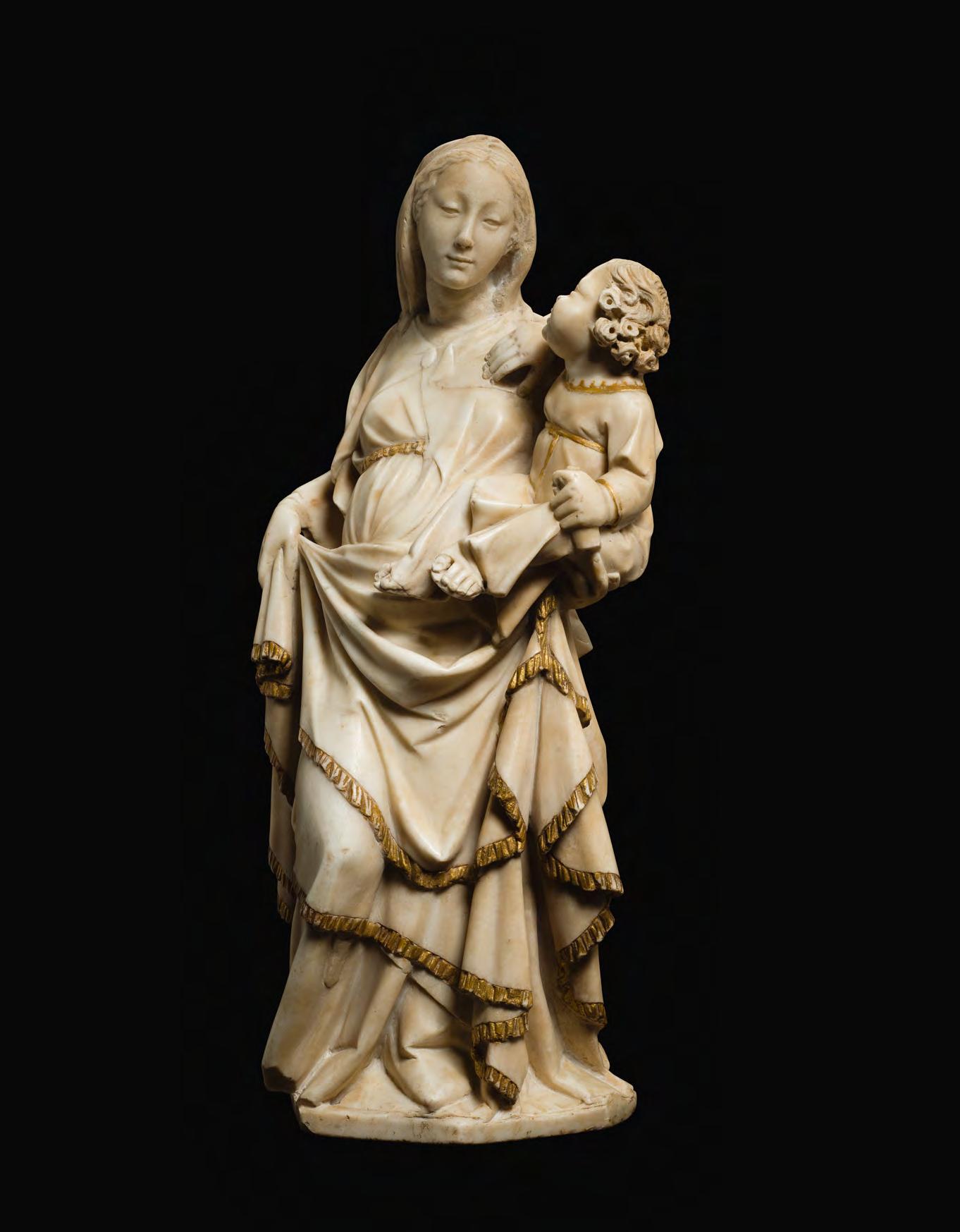

Dear Friends of the Kunsthandlung Julius Böhler,
For me, it is a great pleasure to be able to present a very special Madonna to you at this year’s TEFAF that has been the centrepiece of our family collection for 120 years. The masterpiece is a work by the Italian artist Giovanni Pisano, court sculptor to the Holy Roman Emperor Henry VII. Created in about 1313, it was restored around 1490 by Benedetto da Maiano.
In 1904, my great-great-grandfather Julius Böhler acquired the marble Madonna and Child at the Somzée auction in Brussels where more then 2,000 works of art, brought together by one of Belgium’s most important collectors, were sold after his death. At that time it was attributed to the Renaissance artist Nicola Pisano (1434-1538). Léon Somzée, an extremely successful engineer and Belgian politician, probably acquired it in Rome between 1864 and 1867.
Thanks to his expert eye Julius Böhler had succeeded in acquiring an extraordinary work of art for his important private collection. The Madonna was not intended for sale. It found a new home in the Palais Böhler in Brienner Strasse in Munich, the representative seat of the company and the family home.
A special feature set the sculpture apart right from the start. It was evident that the head and the body did not belong together and even dated from different eras. An art-historical puzzle had to be solved.
The first attribution of the figure, that had rarely been displayed in public, was to Tino di Camaino, a pupil of Giovanni Pisano. Since then, Max Seidel – an internationally recognised expert on Giovanni Pisano – has successfully proven the sculpture’s attribution to Giovanni Pisano himself. Seidel backs up his theory through stylistic comparisons with works acknowledged as being by Giovanni Pisano which are discussed in this publication. He explains the addition of the lost head by Benedetto da Maiano – equally attributed due to style – on account of the extraordinarily high esteem in which the Pisano Madonna must have been held in the late 15th century. Only an artist comparable to Giovanni Pisano, such as Benedetto da Maiano, was allowed to create the new head of the Virgin Mary. This was a unique course of action for which no comparison is known to date.
Thanks to the interaction of these two great Italian artists spanning different epochs, this work combines the Italian Gothic with the Renaissance in a harmonious and artistically convincing way.
I invite you to embark on an art-historical journey with Max Seidel and I am already looking forward to showing you this beautiful and extraordinary work, to which I am particularly close, on our stand.
Finally, I would like to express my thanks to Eva Bitzinger and Julia Scheid for their, as always, profound editorial work.
Yours,
Florian Eitle-Böhler

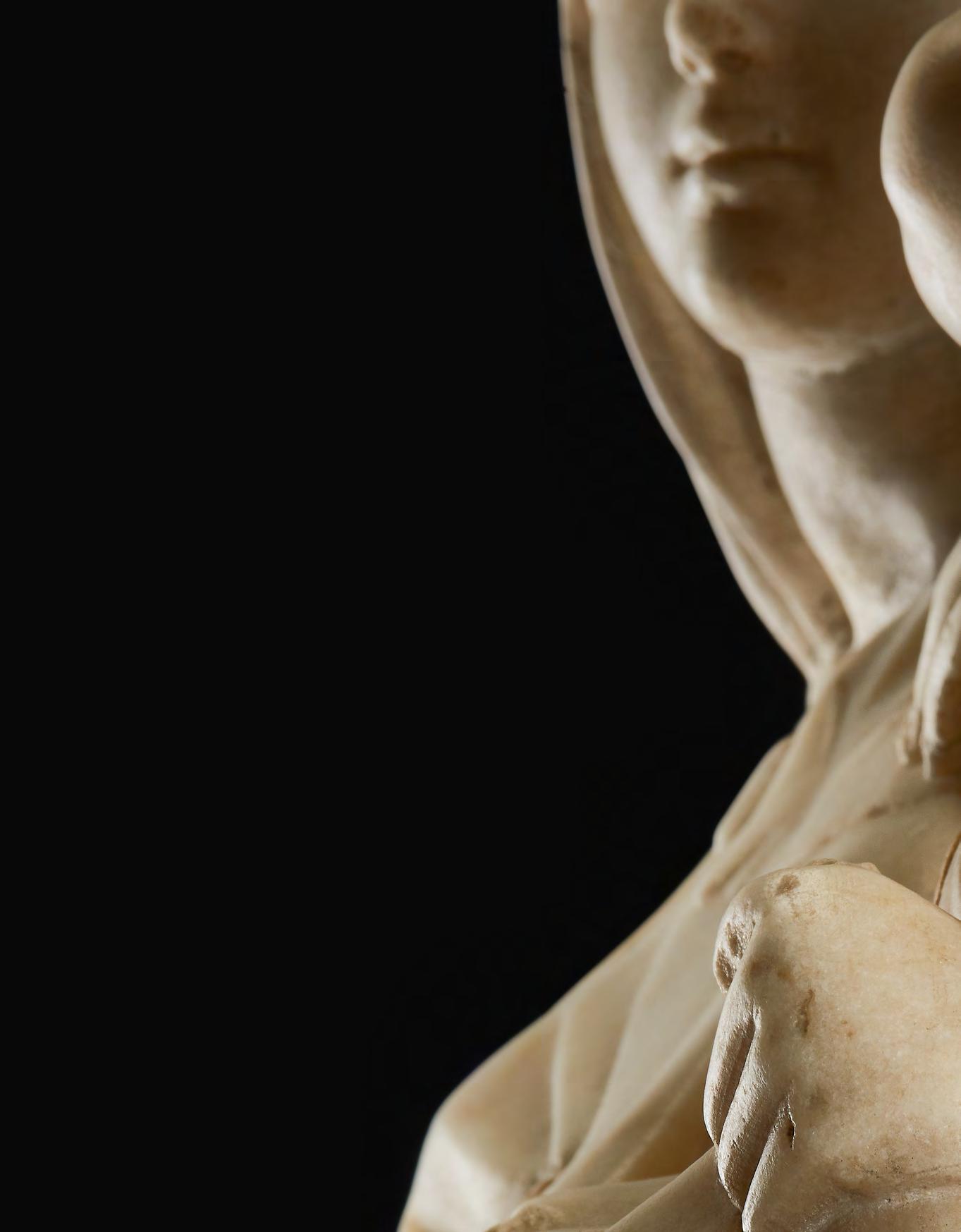 GIOVANNI PISANO
GIOVANNI PISANO
Circa 1248 Pisa – 1318 Siena
Circa 1313
Restoration of the head of the Madonna attributed to BENEDETTO DA MAIANO 1442 Maiano near Fiesole – 1497 Florence Marble, with later partial gilding Height 60.5 cm

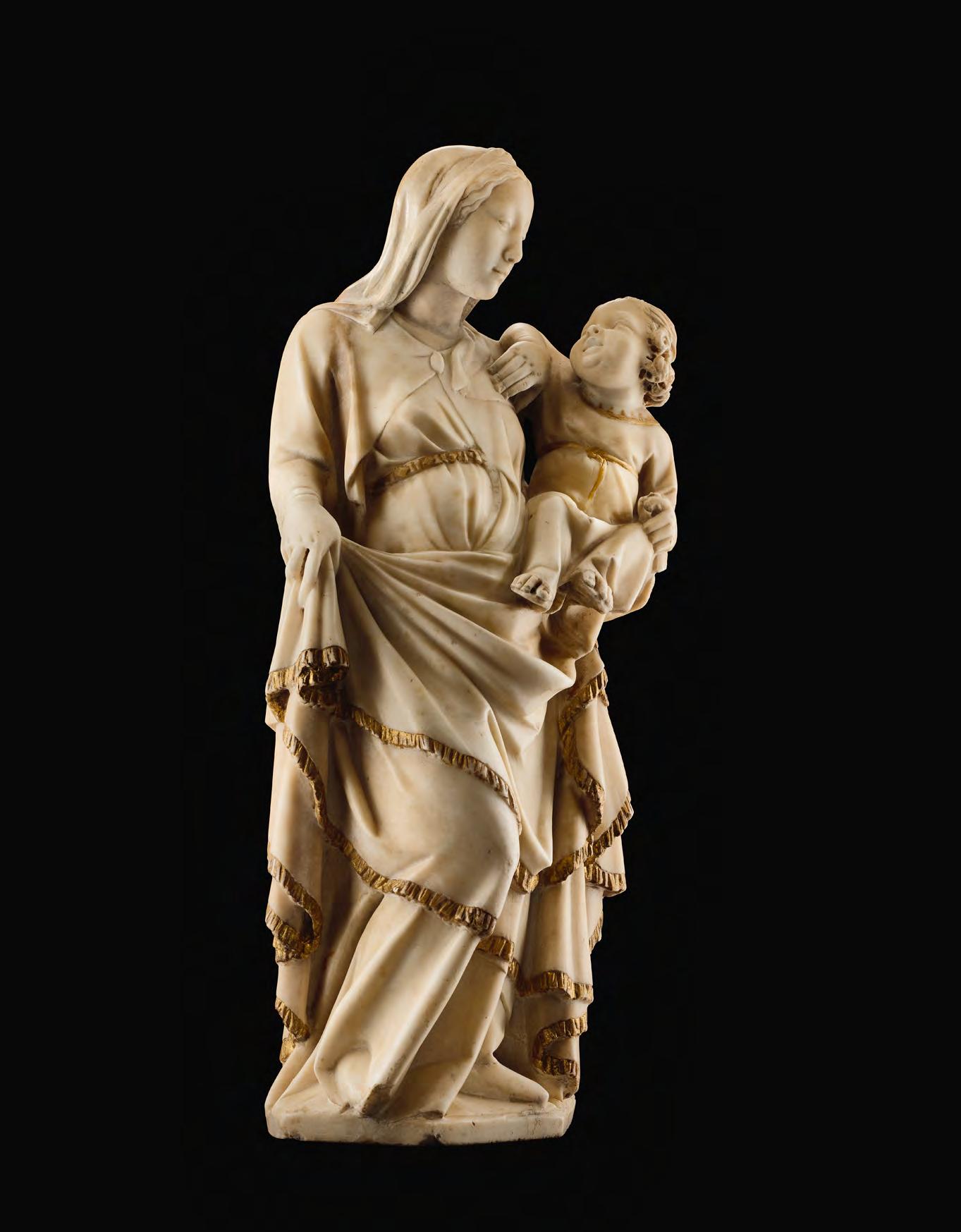





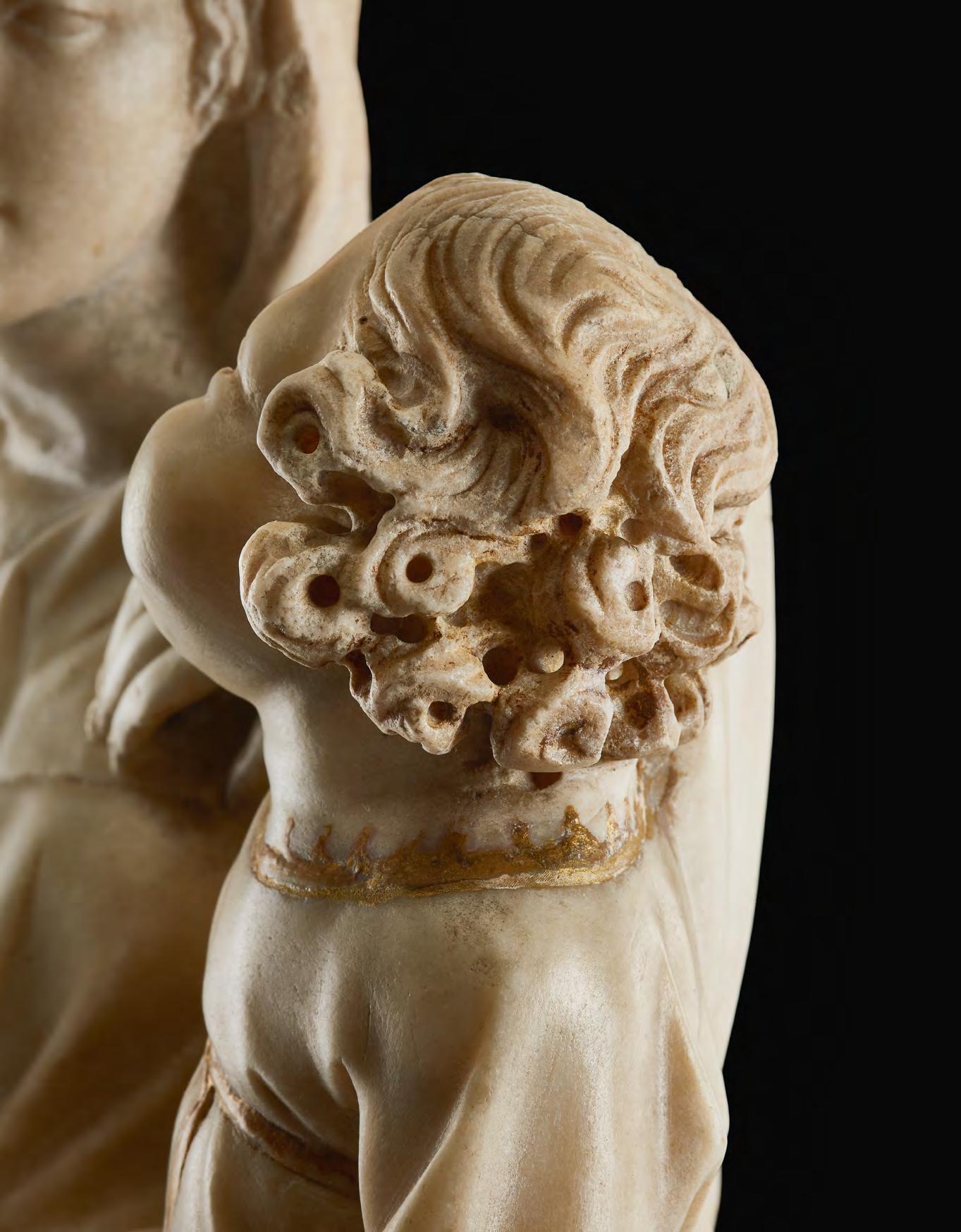
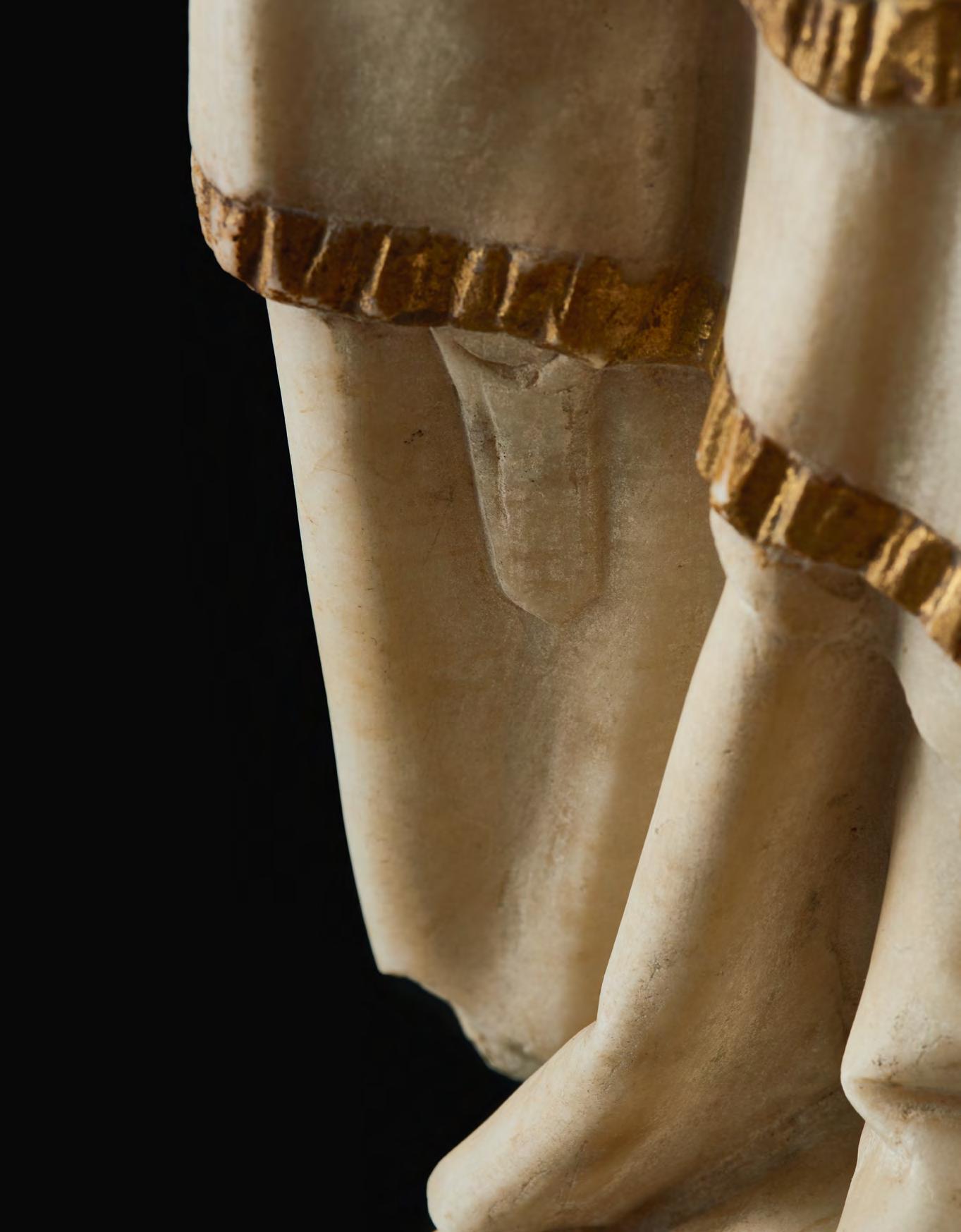
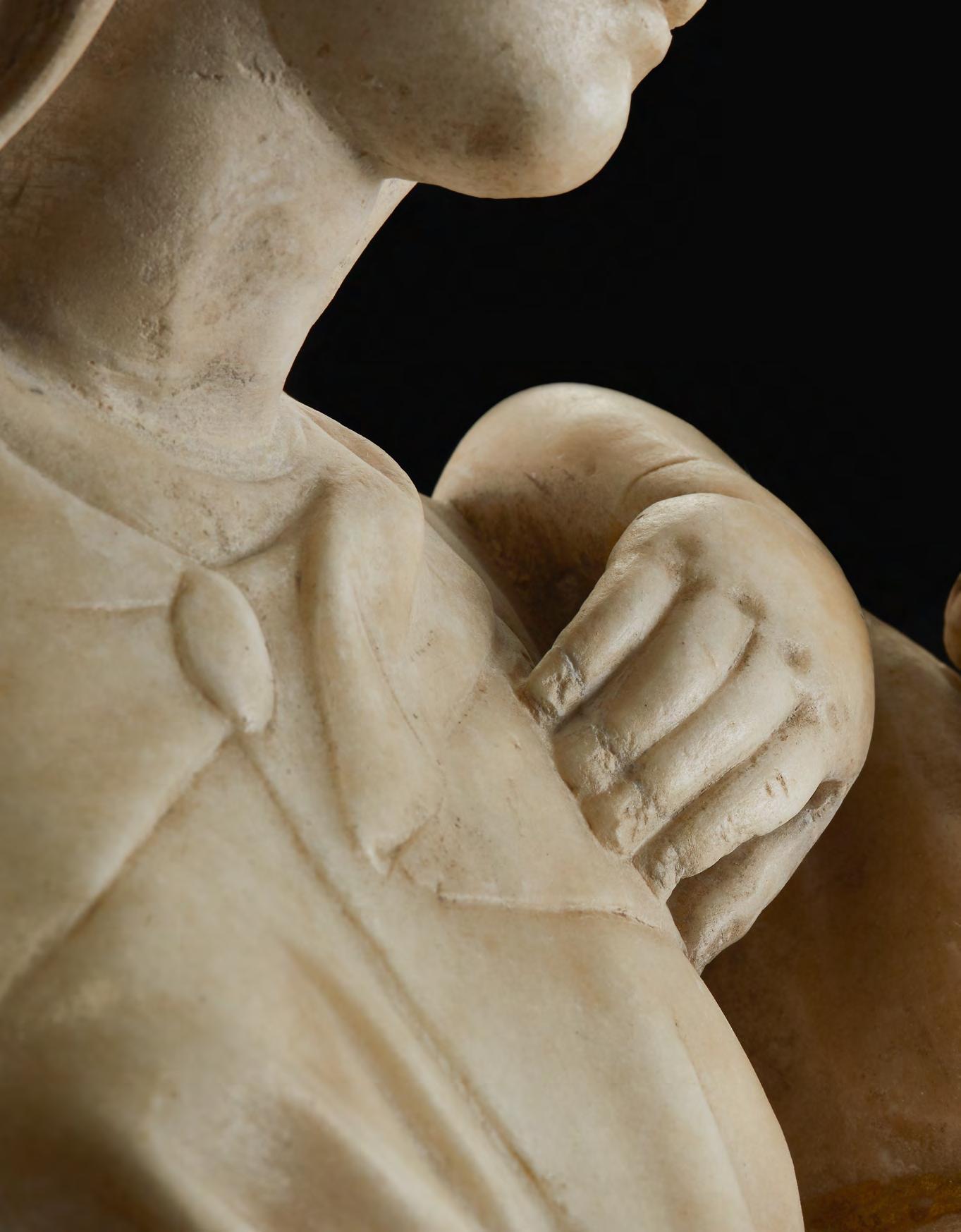



 Fig. 1 Giovanni Pisano, Madonna and Child (Head of the Madonna by Benedetto da Maiano), Starnberg, Böhler Collection
Fig. 1 Giovanni Pisano, Madonna and Child (Head of the Madonna by Benedetto da Maiano), Starnberg, Böhler Collection
The Böhler Madonna (fig. 1) was acquired by Julius Böhler –Kaiserlich-Königlicher Hofantiquar and Königlich-Bayerischer Hofantiquar – from the Belgian collector Léon de Somzée at the auction of the huge collection belonging to the industrial gas magnate, held in 1904 at the Palais Somzée in Brussels (fig. 14). 1
The sculpture has always been kept in private collections, initially in the Collection Somzée and later, until the present, in the Sammlung Böhler. The only exhibition of the sculpture, to a select public, took place in the summer of 1958 during the show entitled ‘Meisterwerke alter Kunst’ at the Böhler Gallery in Munich, as part of the celebrations for the city’s 800 th anniversary. On that occasion the statuette was presented with an attribution to the Sienese sculptor Tino di Camaino. 2
As we gather from the entries devoted to the sculpture in the two typewritten catalogues of the Böhler Collection, issued in 1931 and 1967, it is deducible, but not demonstrable, that Julius Böhler had asked Wilhelm von Bode (fig. 5) for an opinion on the statuette, but, probably because of the stylistic incongruity of the head, Bode preferred to suggest that the dealer should apply to the Italian art historian Adolfo Venturi. 3 As far as we now know, Bode never officially expressed an opinion on the attribution of the sculpture, although in those very years he was involved in the creation of a rich collection of fourteenth-century sculpture for the Kaiser-Friedrich-Museum and enjoyed the availability of enormous sums of money for the purchase of excellent works, thanks to the generous financial support of the Emperor Wilhelm II of Prussia. 4
What is said about Bode’s judgement in the two Böhler catalogues, i.e. that Bode considered the body to be by Giovanni Pisano and the head by Benedetto da Maiano (fig. 1), we must assume to be a rumour passed on by dealers but not officially confirmed. 5 Both in the inventory of 1931 and in that of 1967 the white marble sculptural group with gilded fringes at the hem of the cloak, 60.5 cm high, is described as a work attributed by Adolfo Venturi in primis, and subsequently by Wolfgang Fritz Volbach, to Tino di Camaino. 6 Moreover, in the 1967 catalogue it is stated that the attribution to Tino was confirmed both by John Pope-Hennessy and by Wilhelm Reinhold Valentiner, indicating also that in the Museum of Fine Arts in Boston there was a similar headless Madonna, also by Tino, which was given to the museum by the American collector Charles Callahan Perkins. 7
From this documentation we gather that, after the acquisition of the work by Julius Böhler, the only ones who officially attributed the teenth-century sculpture to Tino di Camaino were Venturi, in 1906, 8 and Volbach in 1925 9 in the margin of a small scholarly article. In volume IV of his Storia dell’arte italiana, devoted to fourteenth-century sculpture, Venturi states that:
While he was in Pisa, Tino di Camaino must have executed a great many Madonnas, which remained typical for the Pisan sculptors. One is in Turin, in the Civic Museum, from the collection of the Marchese d’Azeglio, […] and this served as a model for another in the Berlin Museum, where it was ascribed to Giovanni Pisano, and for a third, entirely remade, which is in Munich at Böhler the dealer. […] The attitude of those Madonnas, raising the cloak with the right hand and gazing at the divine Infant, and the way in which he places his hand on his Mother’s breast, derive from models by Giovanni Pisano. 10


The attribution to Tino di Camaino was based on regarding the d’Azeglio Madonna (fig. 86) – a supreme masterpiece by Tino inspired by the late works of his master Giovanni Pisano –as the model for the Böhler Madonna (fig. 1) and for the Madonna and Child now in the Bode Museum (fig. 55), which Venturi then attributed to Tino although it was ‘ascribed to Giovanni Pisano’ on the basis of Bode’s initial attribution of 1886. 11 The d’Azeglio Madonna is signed by Tino di Camaino in the inscription (fig. 86): VIRGINIS A TINO FECIT OH QUAM CERNIS IMAGHO QAM GENUERE PATER[QUE] MAG[I]STRO. 12 Among the Madonnas which, according to Venturi, remained ‘typical for the Pisan sculptors’ he indicates the Madonna and Child of San Michele in Borgo, a work by a follower of Tino di Camaino, now known to be Lupo di Francesco (fig. 100). 13 The mistaken attribution of the Böhler Madonna was taken up in the essay by Volbach, published in 1925 in the Münchner Jahrbuch für bildende Kunst, 14 mainly devoted to the Ettal Madonna:
If we observe the other works of Tino as well as the forementioned Madonnas, the likelihood increases that the paternity of the Ettal Madonna be his. We find similar features in his first standing Madonnas in the Civic Museum in Turin and in the Böhler Collection in Munich. 15
In his essay Volbach attributed the Ettal Madonna and Child to Tino di Camaino, and compared the Turin Madonna stylistically to the Böhler one (fig. 1 and fig. 86). In his overview of Tino’s works, Volbach dated the Ettal Madonna, at the centre of this stylistic group of Madonnas that included the Böhler statuette, to about 1320. 16
The reasons for this ‘suspension of judgement’ about a sculpture of such high scholarly interest could be multiple. It is possible that the dealer Julius Böhler wanted jealously to conserve the sculptural group in his family collection, in those very years when he was intent on consolidating his position as connoisseur and art dealer on the international scene, together with his eldest son Julius Wilhelm.
Julius Böhler was the eighth child of a family of craftsmen, and was born in 1860 at Schmalenberg near St Blasien in the Black Forest. In 1880 at the age of twenty he acquired his first antique at Überlingen on Lake Constance, and it marked the foundation of his art gallery. 17 So the founder of the famous firm was selftaught. In 1883 he married Maria Loibl, by whom he had two more sons after the first-born, Otto Alfons and Wilhelm. 18
Between 1902 and 1904 (the year he bought the Madonna from the collection of Léon de Somzée, (fig. 1) Julius Böhler, at the peak of his success as a dealer, commissioned from the architect Gabriel von Seidl a building to house his art gallery in the elegant Brienner Straße in Munich (fig. 2), where he also set up his private collection, which undoubtedly included the statuette in question (fig. 1). 19 Subsequently, his son Julius Wilhelm, after a long period of apprenticeship in Paris and London, in 1920 founded together with his friend Fritz Steinmeyer an art gallery in Lucerne, continuing to keep the Madonna and Child secret as a private work belonging to the family. Julius cultivated in particular his interest in Gothic statuary whereas his eldest son, Lulu, preferred paintings and drawings, and for this reason had little interest in sculpture. 20
From 1913 in fact Lulu Böhler and Fritz Steinmeyer moved to the USA, where they came into contact with the art dealer Duveen and the collectors Isabella Stewart Gardener and Philip Lehman. In these circumstances they had success in selling, to leading European museums, some extraordinary paintings such as two landscapes: one by Philips Koninck to the Munich Pinakothek and one by Rubens to the Kaiser-Friedrich-Museum in Berlin. 21 Julius Böhler died in 1934. Over the four decades following the acquisition of the Madonna, the sculpture remained practically inaccessible to scholars in the Böhler family collection in Munich. 22
Another reason that could explain this long silence might have been a certain prudence, due to the strange incongruency of the head, perhaps fifteenth-century or even nineteenthcentury, in relation to the Gothic sculpture (figs. 1, 6-10). Such indecision was aggravated also by Bode’s refusal to purchase the sculpture for the Kaiser-Friedrich-Museum, even though in the early years of the twentieth century he had renewed his interest in the sculptures of Nicola and Giovanni Pisano. 23 There exists however a strange and curious parallel between the careers of Bode and Böhler, which had its beginning in the 1890s and was based on some precise connections, albeit at a distance, between the two connoisseurs and collectors.

When in 1895 Julius Böhler became Kaiserlich-Königlicher Hofantiquar (fig. 3), one year later, on 6 May 1896, by a decree of the Emperor Wilhelm II of Prussia, construction began on the Renaissance Museum in Berlin, which was inaugurated as the Kaiser-Friedrich-Museum in 1904 (fig. 11). In that year work on the construction of the Böhler building in Munich, begun in 1902, was finished (fig. 2). 24 The Madonna from the Somzée Collection was purchased in 1904, and in the following year Julius Böhler was made Königlich-Bayerischer Hofantiquar (fig. 4). 25 In 1875 Bode had begun to collect the masterpieces that two decades later would form the nucleus of the sculpture collection of the Renaissance-Museum (figs. 5, 11), concentrating mainly on the Italian Renaissance. So it seems significant that some of the works acquired in 1881 by Bode were the Imago Pietatis and the Madonna and Child, both by Giovanni Pisano. In this context however it seems strange that Bode, who between 1901 and 1905 had devoted himself to collecting sculptures of the Italian Gothic – choosing in particular the Archangel Gabriel by Nicola Pisano from the pulpit of Siena Cathedral, the Dormitio Virginis by Arnolfo from the façade of Santa Maria del Fiore in Florence, the Sibyls from the pulpit of Pisa Cathedral and the wooden Crucifix by Giovanni Pisano – should not have expressed his opinion officially on the Böhler Madonna, nor have made the slightest attempt to acquire it. 26
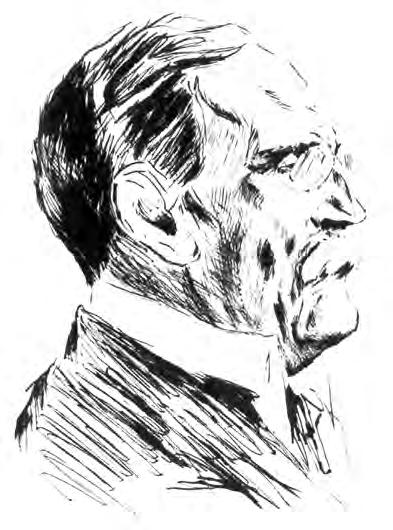



To understand the nature of this strange insecurity of the critics, we need to comprehend the basis for the art historians’ opinions previously expressed. In the early decades of the twentieth century, in addition to the Böhler Madonna, the sculptures of the Madonna and Child known to be works by Giovanni Pisano and Tino di Camaino were three: the Berlin Madonna (fig. 55), attributed by Bode to Giovanni Pisano and by Venturi and Volbach to Tino; 27 the Madonna of the Girdle in Prato by Giovanni (fig. 51); and, in the circle of works by Pisano’s famous pupil, the d’Azeglio Madonna (fig. 86), since the late nineteenth century conserved at the Civic Museum in Turin. In the light of this restricted group of works, critics of the early decades of the twentieth century wrongly saw the Turin Madonna (fig. 86) as the model for the Böhler Madonna (figs. 1, 6-10). Following a long period when scholars paid no attention to the sculpture, for the first time Max Seidel in 1972, in an article in the journal Pantheon on the Berlin Madonna, 28 evaluated the Böhler statue in the context of the group of headless Madonnas of the ‘school of Giovanni Pisano’ –which includes the Madonna in the museum of Sant’Agostino in Genoa (fig. 46), the headless Madonna in Pisa that was originally part of the Lasinio Collection at the Camposanto (fig. 43) and the one in the Museum of Fine Arts di Boston – attributing it to this ambit of the master. Subsequently Seidel, in the 1987 catalogue of the exhibition ‘Giovanni Pisano a Genova’, clearly corrected the models of comparison, identifying the Berlin Madonna (fig. 55), with the imperial crown, and the headless Madonna in the museum of Sant’Agostino in Genoa (fig. 46) as the principal reference models for the stylistic identification of the Böhler statuette. 29
Prompted by a request for an expertise on the work on the part of the dealer Florian Eitle-Böhler, we took the opportunity to examine the statuette in greater depth, on the basis of new stylistic comparisons with works by Giovanni Pisano, distinguishing them from those created by Tino in a style that pays homage to his master, as for example the Turin Madonna. Starting from the awareness that it was an excellent masterpiece by Giovanni Pisano (figs. 6-10), we demonstrated that this sculpture belongs to his period as court artist to Emperor Henry VII, in the years 1312-1313. This demonstration was made possible by concentrating on five basic problems, with the aim of resolving the stylistic question and that of the statuette’s historical-political significance. To understand this sculpture in the history of collecting, we studied the typology and character of the collection formed by Léon de Somzée, who owned the statuette until it was acquired by the Munich dealer. In the singular figure of this industrial gas magnate, who accumulated works of art in his house in Brussels, we discovered the profile of a collector hitherto unknown to art criticism, following his development from amateur purchasing en masse to collector well aware of the historical value of his acquisitions.
We devoted ourselves to studying the sculpture in its two stylistic components. Given that the body, from the very first glance, appeared to be unequivocally by Giovanni Pisano (figs. 6-10), we formulated a hypothetical reconstruction of the statuette’s original appearance, taking the head of the Prato Madonna as a model (figs. 31-32). A particular study regarded the fifteenth-century head: we were able to demonstrate that it is
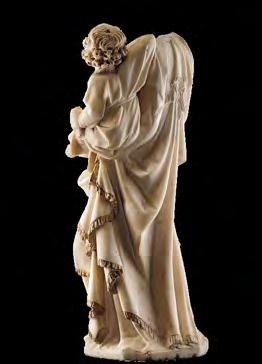


by Benedetto da Maiano and belonged originally to this sculpture, dating the head to around 1490 (figs. 22-26). This allowed us to discover something utterly unprecedented: the dialogue that took place between a famous renaissance artist and Giovanni Pisano, adjusting his own work to the Gothic masterpiece. Thanks to X-rays of the work, it has moreover been possible to shed light on the history of the head’s restoration, not only in the fifteenth century but also in the early twentieth, after Julius Böhler acquired it (figs. 37-40).
By widening the stylistic comparisons with other works by Giovanni, on the basis of new photographic documentation, including the headless Madonna in Pisa at the Museo Nazionale di San Matteo (fig. 43) and the one in Genoa in the Museo di Sant’Agostino (fig. 41), discovered in 1987, 30 both unknown to Volbach and Venturi, 31 we have been able to develop innovative paragons that demonstrate not only the high quality of the Böhler Madonna, but also its place among the works created by Giovanni in the years 1312 and 1313. Following this line of research, we discovered that in the fourteenth century the Böhler Madonna was so famous and venerated that it became the model for the Madonna of San Michele in Borgo in Pisa, by Lupo di Francesco, (figs. 100-101) and for the Madonna in Piombino signed by Marco and Ciolo da Siena (fig. 104), both of them dating from around 1320. On the basis of these new stylistic comparisons we have proposed a dating to around 1313 for the Böhler Madonna and have clarified the provenance of the original location in the city of Pisa.

A wholly unexpected fascination emanates from the history of the Böhler Madonna (fig. 1) in collections, dating from the activities of the first collector, the industrial gas magnate Léon de Somzée, who was an homo politicus, according to the typically late-nineteenth-century definition given by Paul Valery, though today we would probably say that he was a politically influential person on account of his great wealth. Born Léon Mathieu Henri in Liège in 1837, he took his doctorate in engineering in that city in 1862. 32
After his first industrial missions to Spain and Portugal, he was in Italy for the first time between 1862 and 1863 as the emissary of the mining engineers Caroline. 33 It must have been during this first sojourn in Italy that the rich industrialist became strongly attracted to collecting, encouraged by his considerable economic means and by a desire to create an enduring name for himself. This is extremely characteristic of a personality endowed with a high conception of his own destiny, for which he envisaged a great social and political future. This period of about one year spent in Italy must have been too brief for the young Somzée to complete the first acquisitions for his future art collection. So it was during his work as director-general of the Italian gas industry, between 1864 and 1867, that he was able to spend about four years in Italy that were to prove decisive for the formation of his collection; in time it would include works of art of every kind: sculptures, paintings and Belgian tapestries. In all likelihood the Madonna and Child, now part of the Böhler Collection, was acquired during this very period in Rome. From the 1860s dates the first plaster bust of Léon de Somzée that is known to us (fig. 12). It was the sculptor Charles Auguste Fraikin (1817-1893) who portrayed him as a young man, with an elegant coat open to show a silk waistcoat, typical of the dandy fashions of the later nineteenth century. The face is crowned by hair parted in the centre, exalting the open gaze staring thoughtfully into the distance, while the pursed lips are surmounted with a flowing moustache, highly fashionable at the time.
The rampant advancement of Somzée’s career in the gas industry, that emerged as the new source of energy in parallel with inventions in the field of electro-magnetism, was accompanied by the gradual formation of a personality that influenced the economies of many European countries. After his prestigious post in Italy, Somzée was head engineer at the Compagnie pour l’Eclairage et le Chauffage par le Gaz in Belgium from 1867 to 1871, while from 1886 he was director of the gas industry in the city of Brussels. 34 This pioneering role, which favoured the spread of an energy source destined to revolutionise society in a wave of heady economic expansion, allowed him to influence political relations between the European countries. From 1884 to 1892 he was a member of the Belgian Parliament, representing the Brussels district, and his mandate was renewed from 1896 to 1900. 35 In the same years, around the time of the great Exposition Universelle in Paris (1900), Somzée was President of the Association Royale des Ingénieurs Industriels. 36
This homo novus reconciled in his overweening ambition his dream of becoming a great art collector with that of influencing industry and politics. This double and specular aspect of Somzée appears not only from the considerable number of international societies that recognised him as a member, such as the Société Générale Internationale d’Eclairage in Belgium and the Société de Pétrole de Grosny in Russia, or as president, such as the Société Impériale Ottomane d’Eclairage, but also from his membership of the Société Royale d’Archéologie de Bruxelles, something he undoubtedly owed to his reputation as a feverish collector. 37 It seems significant of Somzée’s approach to collecting and of his scarce connoisseurship, dominated by a certain fin de siècle eclecticism, that among his publications there is not a single art-historical study or one dealing with works of art.
From his first book, published in 1878 on submarine communication between Britain and France, to his last, published in 1900 and entitled Chemin de fer pour de grandes vitesses, his writings dealt with the new technologies. 38
In the light of these formative experiences, it appears clear that his role as collector began with the idea of creating for himself the image of a man who has achieved his own rebirth and his fame on the threshold of the modern world, thanks to his staggering wealth and by surrounding himself with works of art that augmented his social prestige. This is confirmed by a glance at the second portrait of Somzée, showing him in his maturity (fig. 13). It is a bronze bust made in the late nineteenth century, undoubtedly before his death in 1901. The face no longer appears somewhat overshadowed with as yet unrealised thoughts, but is illuminated with a placid smile, expressing all the sensibility and determination with which the great politician and collector experienced the dawning of the modern age in Europe. The wavy hair and upturned moustache give vitality to the otherwise calm and lively gaze. Unlike the fashionable clothing worn in the first portrait (fig. 12), lacking the decorations that would proclaim his distinctive political importance, in this bust jacket and shirt are adorned with no fewer than four medals (fig. 13). Moreover the sculptor took the trouble to exalt the value of his sitter, alluding vaguely to the iconography of Roman busts, as appears from the tunic-like drapery, which was not part of nineteenth-century fashion, and

from the medallion sculpted on the base of the bust, vaguely recalling the bronze medals that were inserted into busts in antiquity. The work was commissioned to the sculptor Josef Lambeaux (1852-1908), who signed it on the back, and is part of a ‘gallery of busts of illustrious men’ of the nineteenth and twentieth century in the Musée des Beaux-Arts in Liège.
The Somzée Collection originated in the early 1860s, between 1862 and 1864, and it was undoubtedly shaped during Léon’s long sojourn in Italy that ended in 1867, given that antique and Italian works of art always constituted the major nucleus of the collection. Until his death in 1901, Somzée devoted himself indefatigably to the minutiae of displaying an astonishing quantity of art works in his house in Brussels.
Thanks to our research in the archives of the department of architectural patrimony and town planning for the region of Brussels, we have been able to trace an image and the exact address of what in the late nineteenth century was known as the Maison Somzée (fig. 14). 39 It is a document earlier than 1908 and very important, because it completes the photographic documentation of some rooms in the house that we can admire in the initial pages of the catalogue for the auction of the entire collection that took place in Brussels on 24 May 1904 (figs. 15, 20). 40 The majestic Palais Somzée stood at number 22 (now 46)


Rue des Palais in the Belgian capital. This street was one of the branches of the tracé royal, built in 1820 together with Rue Royale and Avenue de la Reine. 41 In particular, Rue des Palais owed it name to the presence of two royal residences, and was distinguished not only by the houses of the upper middle classes but also by hôtels in the neoclassical style, first of all the Hôtel Somzée. 42 In the rare photograph of the Schaerbeek quarter (fig. 14) we notice how the viewpoint of the photographer coincides with Place Jules de Trooz and takes in, among the passers-by, some children who on the left are playing in the street at hoop and stick, while on the right four little girls and a man in a bowler hat are observing the proceedings with interest. The children probably belonged to the Institute Sainte-Marie, originally a home for deaf-mutes that was demolished in 1908, which we recognise in the large building on the corner, surrounded by a wall protecting a little garden with a row of leafless trees. The street still has a religious building, the Église Saint-Nicolas de Myre, though unfortunately it is not visible in the photograph. Only two buildings stand between the Institute and the Hôtel Somzée, which in an inventory is defined as an ‘imposante demeure d’un collectioneur d’art’. 43 Despite the considerable distance from the camera and the transverse viewpoint, we can clearly see that the house is articulated with three orders of windows, eight on the ground floor with the entrance doorway in the centre, and nine on the first and second floor. The architectural model emulates in a late-nineteenth-century neoclassical style the elements of the Italian renaissance palazzi, which the collector had undoubtedly admired during his stay in Rome, in particular Palazzo Farnese by Antonio da Sangallo the Younger and Palazzo Barberini by Carlo Maderno, which from a residence became a museum. We note in the Belgian house architectural elements typical of these Italian palazzi, such as the rustication on the ground floor of the façade and the aedicules of the rectangular windows on the first floor, against the smooth intonaco of the walls, separated by a string- course. The mingling with the nineteenth-century neoclassical style can be seen in particular in the frieze that runs beneath the eaves, though
unfortunately the photograph is not clear enough to show the details or identify its iconography. We do not know the date of the house’s demolition, but it is possible that it took place in 1908, four years after the auction and in the same year as the demolition of the adjacent buildings.
Hôtel Somzée contained a vast and eclectic collection of works of art. This house was part of Somzée’s collecting project and his favourite place, constructed ad hoc, for the scenographic display of his art works. His home was therefore an exhibition space that acquired the value of a private art gallery, open only to a few chosen connoisseurs and to his intimate friends. As is shown in one of the rare photographs of the interior published in the 1904 auction catalogue (fig. 15), the building must have been carefully designed by Somzée and its internal spaces transformed by him so as to create a gallery for the mixed genres of his mirabilia: paintings, sculptures, tapestries and small objets d'art. 44 The eclectic heaping up of the collection follows for the most part a certain Wunderkammer taste, articulating the pieces in accordance with the monumental scenography of the salon, lit during the day by a large skylight. From the ceiling hung two splendid lamps decorated with glass foliage, as well as a number of oil and gas lights. These latter bore witness not only to the successful career of the engineer Somzée but also to the advanced technology in his house at the dawning of the modern age. The sculptures and a male bust at the sides of the vast salon are arranged with regular cadence in correspondence with columns similar to the Corinthian order; each of the four columns presents a particular stylistic mingling: in the upper part of the enthasis, evidenced by a cornice, we note Doric fluting while the lower part has figured reliefs with grotesques and panoplies. Each column is detached from the wall so as to create round-arched niches, in which were paintings of various subjects. To reinforce the centre of the salon, in axis with the monumental arched entrance opening onto a room similar in perspective, we note two sculptures not easily legible, with antique vases and porphyry urns in the intervals: one of them might represent Venus, Daphne or la Source, while the other is a headless fragment of a Roman copy of a Kouros of the fourth century BC. Small art objects and more delicate items, such as a rare collection of painted fans, are displayed in glass cases in the centre and at the sides of the room. In this building the rooms recall, in the arrangement of the columns and in the almost basilican conception of space, the rooms of Palazzo Farnese in Rome, revealing that the idea of the project was that of a rich and vast family collection, intended to form a private gallery in honour of the glory of its founder and of his family.
The arrangement of the art works in the majestic building in Rue des Palais in Brussels reveals the outlook of an amateur collector, not yet flanked by an expert art historian. Not until the mid-1890s did Somzée entrust his collection of Greek and Roman antiquities to the archaeologist Adolf Furtwängler (1854-1907), who had taken part in the excavations at Olympia in Greece and in 1880 had collaborated on the creation of the Antikensammlung in Berlin, where he was appointed professor in 1884. 45 Later, after being awarded the chair at Munich in 1894, Furtwängler took part in the excavations on the island of Egina and at the city of Orcomenos in the Peloponnese. 46 It is especially interesting that the father of the future conductor Wilhelm Furtwängler (18861954) was employed on the scholarly arrangement of the Somzée Collection a few years after the publication in 1893 of the book Meisterwerke der griechischen Plastik, while between 1900 and 1904 the archaeologist would publish in several volumes his study of Greek vase painting, Griechische Vasenmalerei 47
The work of study and scholarly arrangement carried out by the famous archaeologist was determinant for the value of the collection of antiquities and shows Somzée’s urgent desire to confer order on his collection, with the idea not only of making the more prestigious works emerge but also of making them comprehensible in scholarly terms in accordance with a correct art-historical perspective. In 1897 Adolf Furtwängler published in Munich the first catalogue of the Somzée collection entitled Antike Kunstdenkmäler (fig. 17) 48 In the introduction that the archaeologist wrote as a premise to the arrangement of the collection illustrated in the 1897 catalogue, we find the declaration of those principles at the basis of the transformation of Somzée’s eclectic dilettante holding into a compact art collection limpidly selected, in which each object is displayed in accordance with precise art-historical criteria. 49 Furtwängler traces the acquisitions to the gardens and courtyards of villas belonging to Rome’s patrician families, discovering sculptures still unknown to archaeologists. 50 From a careful analysis of the provenances in the catalogue, we note that no fewer than twenty-two sculptures have a Roman provenance: in particular, fourteen from the Ludovisi Collection, six from Palazzo Sciarra, five from an unspecified Roman Collection, one from Palazzo Rospigliosi, four from the Demidoff Collection and two from Villa Casali. 51 To this list we can add a sculpture from Palazzo Soderini in Florence and another one from the collection of a Polish count in Brussels. 52 The archaeologist took care to emphasise that it was Somzée’s idea to correct the dilettante aspect of

the collection by means of an accurate study of provenance and of scholarly cataloguing. 53
The archaeologist also declared that it was his choice to remove from the sculptures most of the later restorations and integrations, and to interest himself also in Roman copies as evidence of the lost Greek bronzes. 54 In the 1897 catalogue, Furtwängler took the trouble both to indicate the later integrations and to explain their removal. For example, regarding a ‘Torso of a youth in the style of Polykleitos’ he declares that ‘the earlier additions have been removed’, 55 while regarding a ‘Torso of Antinoos’ from the Villa Ludovisi in Rome together with a torso of Poseidon originally from the Baths of Caracalla, he states that he saw it with a head of the Apollo Belvedere type and with the right arm added, while it now lacked both the added limb and the plinth. 56 The conscientious archaeologist did not fail, in the case of a ‘Torso of Apollo’ from the Ludovisi collection, to note both its original components and its later integrations: ‘the stele with the serpent beside two sandalled feet is antique, although not attached. The lower part of the legs from knee to ankle is an integration. The other additions have now been removed.’ 57 In the light of this ‘purist’ choice regarding interventions, which were mostly renaissance or eighteenth- to nineteenth-century, it seems clear that the scholarly work of Furtwängler, or of his successor, did not extend to include the collection of thirteenth- to seventeenth-century sculpture, because otherwise the Madonna and Child, now in the Böhler collection, would be lacking the head made for it by Benedetto da Maiano, which is an important stylistic witness to the dialogue between the renaissance artist and Giovanni Pisano.
In the catalogue of the collection of antiquities drawn up by Furtwängler there is a photograph of the display of works selected by the archaeologist at the Hôtel Somzée in Brussels (fig. 16). Observing this photograph and comparing it with the one of
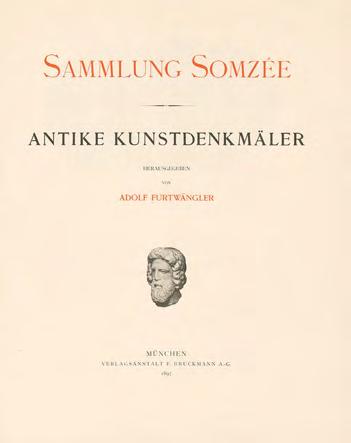

the room with the collection of sculptures, paintings and objets d’art (fig. 15), it seems clear not only that the collection of antiquities is distinct for chronology from the vast number of remaining works of art but also that Somzée was guided and educated by the German archaeologist towards a selected and aware form of collecting, in the stylistic distinctions and in the quality and historical importance of the works on display The imposing colonnaded room with coffered ceiling and a window opening onto the internal courtyard, presents works arranged according to subject and chronology. We note in the layout an attempt to astonish the viewer by the sumptuous nature of the collection, which includes many fragments of torsos and busts, and two centaurs. The articulation of the plinths in respect of the architectural space is the result of a careful choice, which places in the centre of attention the most significant work in the room: a colossal statue of a young man in a helmet, from the gardens of Villa Ludovisi. 58 So the display choices, no longer eclectic and inconsistent, indicate the pre-eminent works as identified by art-historical study. Although the sculpture appears complete in the photograph, Furtwängler specifies that the lower part of the right and left leg, the right foot, the penis, the nose and part of the neck are integrations. 59 The work is the only known copy of a lost Greek original of the earlier fifth century BC, and the only copy that shows an Oplitodromos by the sculptor and painter Mikou, a contemporary of Kalamides and Polygnotus. 60
The fame and fortune of the Somzée Collection grew in parallel with the scholarly study and ordering of the works. Around the late nineteenth and early twentieth century, the owner celebrated the achievement of his fame both as a learned collector and as a European politician and industrialist. At the dawn of the new century, which opened novel horizons for the electrical inventions of the modern age and for new sources of energy, Somzée presented himself at the great Exposition Universelle in Paris in 1900 with a collection of works of art in the Belgian pavilion (fig. 18) – unfortunately the Böhler Madonna was not among the sculptures on display. 61
The rearrangement of the collection was in fact begun by Somzée starting from the works he esteemed most highly, i.e. those of classical antiquity, as is confirmed by the fact that at the Paris Exposition he almost exclusively displayed antiquities. 62 In 1901 death interrupted this project of the cataloguing of the collection, which would undoubtedly have eventually involved the sculptures considered to date from the sixteenth and seventeenth century.



On 24 May 1904 at number 22 Rue des Palais the entire collection of Léon de Somzée, comprising 2,050 works, was sold at auction, given that no member of the family was interested in conserving the patrimony of the far-sighted collector (fig. 20). 63 It was the first time that the Madonna and Child was displayed to the general public, and on this occasion the purchaser was the famous Kaiserlich-Königlicher Hofantiquar Julius Böhler of Munich.
In the auction catalogue edited by J. Fievez of Brussels, plate XCIII is a photograph showing exactly how the Böhler Madonna was displayed at the time of the sale, together with some other sculptures (figs. 19, 21). 64 The display takes no account of the different styles of the statues, nor of their subject, nor of their dating. They appear in a frontal position, some on specially made plinths, so as to create a sort of harmonious arrangement of the heights of the two symmetrical parts of the group; the height of the sculptures varies between 45 and 60.5 cm. The Böhler Madonna (catalogued as number 1421) is also placed on a nonoriginal plinth, which raises it symmetrically in relation to the Virgin and Child numbered 1418 (fig. 19). So the presentation privileges a balance in the formal proportions, as is shown by the insertion at the sides of the sequence of five central sculptures of two putti-telemons supporting shell-like bases, defined by the catalogue as ‘travail florentin du XV siècle’ and exhibited at the Exposition d’art Ancien at Brussels in 1888. 65
Eclectic late-nineteenth-century taste prevails over any idea of historical or scholarly arrangement, and for this reason both the attributions and the dating leave much to be desired. One of the two best-loved works according to the taste of the time is the Virgin and Child identified as number 1418 (fig. 19), called a ‘belle œuvre, finement ciselée et de beaucoup de sentiment’, is attributed to the sculptor Nicola Pisano and dated to the sixteenth century. 66 The later Nicola Pisano was however exclusively a painter who was born in 1434 and died in 1538, son of Bartolomeo da Brugia. 67 This same attributional superficiality is found in the case of the central sculpture of the Virgin in prayer, praised for the drapery and newly attributed to the same Nicola Pisano. 68
The second work of the two best loved is a statuette of the Virgin and Child described at number 1420 (fig. 19) as a very beautiful piece with remarkable drapery and expression. Admiration for this sculpture must have been such that it was in the Exposition Universelle at Paris in 1900. 69 The David with the head of Goliath, next to the Böhler Madonna, is the only sculpture in terracotta, said to be Florentine work of the early fifteenth century and attributed in the catalogue to Lorenzo Ghiberti. 70
The future Böhler Madonna was presented at number 1421 with a single brief line in the catalogue: ‘Statuette en marbre blanc de la Vierge avec l’Enfant Jésus. Travail italien, XVII siècle. Hauteur, sans le socle, 0.60’. 71 As an example of the taste of the time, which conditioned critical judgements on the style of the works without understanding them deeply in historical and scholarly terms, we note that the Böhler Madonna is not praised like the other two Virgins of the group, nor is it appreciated for its drapery and movement. The work, which in the catalogue photograph reveals gilding on the fringes of the cloak, on the girdle and at the base of the Child’s neck, because of Somzée’s lack of appreciation was never sent by him to any exhibition, unlike the other three works visible in the photograph. Lack of understanding of the work’s great art historical value is evident too in the catalogue entry on the Böhler Madonna where no reference is made to the evident stylistic disparity between the renaissance head and the Gothic statuette. Unfortunately we do not know the prices attained at the auction but we may surmise that the price of the Böhler Madonna was very low, to the advantage of its new owner Julius Böhler who with this acquisition showed himself to be an excellent connoisseur.
The stylistic disparity between the head and the body of the Böhler Madonna turns out to be one of the most intriguing problems in the understanding of the statuette, given that it long irritated the art historians and hindered their judgement in identifying the work as a sculpture by Giovanni Pisano (figs. 1, 6-10, 24-26). With a view to resolving the problem implicit in such a disparity, we have formulated four hypotheses.
The first hypothesis is that the head in question is a fake, especially made in the circle of Roman art dealers between 1864 and 1867, i.e. in the arc of time when the magnate-collector Léon de Somzée acquired the sculpture in Rome together with an enormous number of works of art of the Roman period, sold by the city’s old noble families. The hypothesis of a nineteenthcentury head emerged also from the fact that Somzée, not being an expert connoisseur who carefully selected works for his own collection, lacked art-historical advisors (this was before the intervention of the archaeologist Adolf Furtwängler) and for this reason was unable to distinguish a nineteenth-century forgery from an original.
Secondly, we considered the hypothesis that a fifteenthcentury head was mounted onto the sculpture by some art dealer in preparation for its being acquired by Somzée in Rome. The third hypothesis, linked indirectly to the fourth, is based on an attribution of the head to the Tuscan sculptor Benedetto da Maiano (fig. 24). The 1931 and 1967 typewritten inventories of the Böhler Collection report that Wilhelm von Bode had informally, and probably voce dictu, identified in the head the style of Benedetto da Maiano. 72
Lastly, the fourth hypothesis is that the head was made by Benedetto da Maiano for this very sculpture by Giovanni Pisano, which had been left headless after a brutal fall. So this would be a very rare example of an integrative restoration in the 1480s of a fourteenth-century sculpture presumably much admired as an object of veneration and devotion.
To demonstrate that this is an original head sculpted by Benedetto da Maiano, we relied on the professional opinion of Francesco Caglioti, the eminent connoisseur of fifteenth-century Tuscan sculpture, who completely agrees with our analysis as set out here. We wish to illustrate the attribution of the head to the Tuscan sculptor, initially presenting two stylistic comparisons with two famous works by Benedetto da Maiano: the delicate face of the Madonna and Child in the roundel sculpted in relief to crown the tomb of Maria d’Aragona in the church of Sant’Anna dei Lombardi in Naples (fig. 22) and the head of the Madonna and Child known as ‘of the Snows’ in the church of Santa Maria Assunta e Sant’Elia at Terranova Sappo Minulio (fig. 23).
Observing the head of the Böhler Madonna, and comparing it with that of the Virgin in the roundel with seraphim surrounded by a festoon of fruit, (figs. 22, 24-25) we clearly recognise the common compositional traits in the oval of the face firmly supported by a neck worked with soft, subtle moulding and slightly inclined to give full effect to the fall, at the sides of the face, of the drapery on either side of the face. The folds of this veil are gathered into a point at the top of the head above the hair parting, as though alluding to a diadem. This slight but significant raising of the cloth delineates an ideal vertical axis that traces the parting, the nose, the lips and the rounded chin.

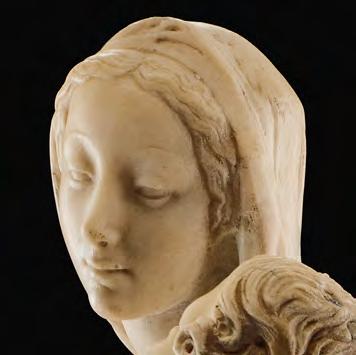
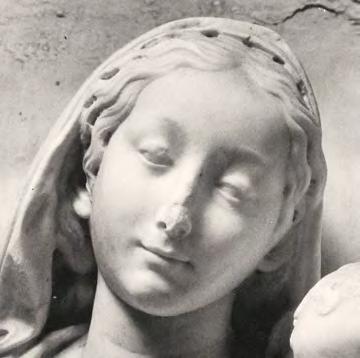


1 Today, only a small number of figures are to be seen.
2 Painted à la porcelaine, the stone sculptures would have had the appearance of painted china figures.
The limpid ovoid form is emphasised by the slight contrast with the locks of hair, in both sculptures three on each side, which fall in soft waves to cover the temples and part of the ears, and seem to lap against the quiet surface of the face. Both in the Neapolitan sculpture and in the Böhler one we observe the same compositional principle in the maximum harmony of the oval, where we admire the quiet expression and the intus that the artist has conferred on the figure.
From the softness of the Madonnas’ complexions there emerge unmistakeable traits of the figures sculpted by Benedetto (figs. 22, 24-25), not only for the almost imperceptible (were it not for the falling of the light on the arched profiles) eyebrows, but in particular for the subdued cut of the almond-shaped eyes. The lips seem sealed and defined by the dimples at the corners of the mouth. The lower lip can be read thanks to an indefinite passage of chiaroscuro given by the dimple on the chin, which like a well polished detail concludes the symmetrical oval of the face. Since the Madonna in the roundel on the Aragonese tomb is one of Benedetto’s supreme masterpieces, it is precisely this extremely high formal quality that allows us confidently to ascribe the head of the Böhler Madonna to the sculptor, in as much as the stylistic features, albeit of a slightly lower tone in the latter, are clearly identical.
The second stylistic comparison is between the head of the Böhler Madonna and that of the Madonna of the Snows in Terranova Sappo Minulio (figs. 23, 25-26), belonging to a series of Madonnas linked to Calabria in southern Italy. It reveals how the stylistic features proper to the Tuscan sculptor are present also in the face of the Böhler Virgin. As in the case of the head of the Madonna in the roundel on the tomb in Naples, we note that Benedetto in the case of the Böhler Madonna used a technique of working the marble in the round that is distinguished from the technique of sculpted relief, proper to the Madonna of the Snows (fig. 27).
Observing the face of the Madonna of Sappo Minulio and that of the Böhler Virgin, we are aware of a greater stylistic quality in the latter although the stylistic motifs have much in common, among them being the composition of the oval motif of the face, positioned in axis with the slender neck (figs. 23, 26). Very similar in both sculptures is the appearance of the eyes beneath the half-closed lids, and the eyebrows perceptible only from a slight hollow in the marble. The expression changes imperceptibly between the two faces: the lips of the Madonna of the Snows appear thin and firm in an icastic smile, while those of the Böhler
Virgin smile delicately. With subtle ability Benedetto maintains the stylistic feature, slightly changing the form so as to adapt the barely hinted smile of the Madonna of the Snows, who does not look at her Son, into the contained movement of empathetic sentiment of the Böhler Madonna who is engaged in a visual dialogue with the Christ Child. In the formulation of the soft and wavy locks of hair, Benedetto expresses himself in the customary central division, which emphasises the oval of the face while partly concealing the ears. The veil appears in this comparison similar in its arrangement, with the same folding into ‘diadem-like’ pleats, although that of the Calabrian sculpture presents a piercing at the edge of the cloak in contact with the locks of hair. While in the Böhler Madonna the veil falls at the sides of the face, timidly alluding to the emphatic movement of the body in the original fourteenth-century sculpture, in the Madonna of Sappo Minulio on the other hand it is slight breeze that disturbs the folds falling at the sides of the Virgin’s face, distending the pleats at the sides.
In the light of these comparisons, we can affirm that the head of the Böhler Madonna is unquestionably an authentic and high-quality work by Benedetto da Maiano. As for the dating, the arc of time in which Benedetto made the head for the Böhler Madonna can be deduced with a certain accuracy from the documented chronology of the funerary monument to Maria d’Aragona and of the Madonna and Child of Terranova Sappo Minulio.
It was Antonio Piccolomini Todeschini, duke of Amalfi, nephew of Pius II and consort of Maria d’Aragona, who set up the funerary monument to his wife, natural daughter of King Ferrante of Naples. 73 As is attested also by Giorgio Vasari in his Lives of the artists, the cenotaph was commissioned from Antonio Rossellino, who died in 1479 leaving the work unfinished. 74 In this connexion we have a Procura document dated 18 July 1481, in which Antonio Piccolomini authorises the abbot of San Miniato to claim the sum of 50 florins from the heirs of Antonio Rossellino, given that the latter’s death had interrupted the commission. 75 On 10 March 1490/1491 a document attests that Antonio Piccolomini paid 100 florins to Benedetto da Maiano, confirming that the Tuscan sculptor worked on the monument to Maria d’Aragona, completing what was left unfinished by Antonio Rossellino. 76 The extraordinary quality of the roundel with the Madonna and Child, and the evident stylistic features of the figures, confirm that Benedetto da Maiano planned this relief to complete the monument begun by Rossellino (fig. 22). So, taking the Procura document as terminus a quo, it follows that the image of the Virgin in the roundel was made shortly after 1481 (fig. 22). 77 The Madonna



of the Snows (figs. 23, 27), identified by Francesco Caglioti as a work of Benedetto da Maiano, 78 was originally conceived by the sculptor as the central part of an altar that was probably commissioned by Count Marino Curiale di Terranova. 79 The close stylistic similarity between the relief of Sappo Minulio and the altar of the Annunciation in Naples, for which 1489 is given as terminus ad quem, allows us to date the Madonna and Child of Sappo Minulio to around 1490 (figs. 23, 27). 80 From this chronological analysis of the two works by Benedetto, we can deduce with a certain degree of probability that the sculptor made the head for the Böhler Madonna at some time in the 1470s (figs. 24-26).
In Tuscan sculpture of the late fifteenth century it is fairly rare, as compared to the fourteenth century, to find statues of the Madonna and Child in a standing position. This motif, which was continually repeated in the Gothic period, rarely and only in particular cases was continued in the early Renaissance. Only a few examples of this type of Madonna have come down to us,
made in terracotta by the followers of Donatello. Jacopo della Quercia on the other hand recreated these themes from Gothic sculpture. Among the predecessors of Benedetto da Maiano, only Luca della Robbia made two standing Madonnas, though they were not in marble but in glazed terracotta.
Several scholars have attributed to Benedetto a small group of Madonnas – all more than a metre in height, standing, holding the Child – stylistically consistent, in the south of Italy, which perhaps derive from a devotional prototype. 81 Ascribed to Benedetto are not more than five marble statues of lifesized Madonna, all in Calabria and none of them commissioned for Florence or for elsewhere in Tuscany. 82 According to the studies of Doris Carl, the Madonna and Child of Morano Calabro, in the Collegiata della Maddalena, and the one of Amantea (fig. 28), in the church of San Bernardino da Siena, both derive from the celebrated Madonna di Nicotera (fig. 29), which has been an object of particular devotion ever since the birth of the legend that it arrived in a ‘wandering vessel’ and was found on the beach by the monk Paolo da Sinopoli, who set it up in the church of Santa Maria delle Grazie.83
Fig. 27 Benedetto da Maiano, Madonna of the Snows, Terranova Sappo Minulio, church of Santa Maria Assunta e San Elia Fig. 28 Benedetto da Maiano, Madonna and Child, Amantea, church of San Bernardino da Siena Fig. 29 Antonello Gagini (or Benedetto da Maiano), Madonna and Child, Nicotera, CathedralIn particular, the Madonna di Morano Calabro is thought to be the first copy of the statue of Nicotera (fig. 29). 84 However in 2002 Francesco Caglioti identified the Madonna Nicotera (150 cm tall) as a youthful work by Antonello Gagini, dating from between 1498 and 1499 (fig. 29); in contrast he identified Benedetto’s typical stylistic features in the face and in the composition of the Madonna of the Snows (fig. 27), which however was not a statue but the central part of an altar sculpted in relief. 85
Lastly, if we consider that also the Madonna di Bombile at the Santuario della Madonna della Grotta presents a style very similar to that of the Madonnas of Nicotera (fig. 29) and of Morano Calabro, it seems clear that the number of standing Madonnas ascribable to Benedetto da Maiano shrinks perhaps to only one, i.e. the Madonna of the Snows (fig. 27), which however in comparison with the Böhler Madonna is not only much taller but is also not a statue in the round but a relief (figs. 1, 27). From these studies it is clear that on the nineteenth-century art market there was no head of a standing Madonna by Benedetto da Maiano with measurements suited to being attached to the Böhler Madonna, which was and is about 60.5 cm tall. Thus we may exclude the hypothesis of an arbitrary reassembling with a head by Benedetto.
In support of the thesis that we are not dealing with a fragmentary head of a standing Madonna by Benedetto attached in the nineteenth century – or even with a nineteenth-century fake used to complete the headless statue – , we should like to illustrate some details that provide proof of the integrative restoration that Benedetto skilfully operated by joining the head, which he had made, onto the fourteenth-century sculpture. The joining of the marble fits perfectly every component of the veil and neck of the original part; neither at the back nor at the front nor at the sides can be found any disjuncture or disarticulation, something that would be impossible had not the head been specifically made for this purpose. On the front we note how the pleats in the folds of the veil fall in perfect harmony with the fourteenth-century remains of the drapery sculpted by Giovanni Pisano, of which the lower left margin has been conserved, which turns behind the back, and that of the lower right margin which with two pleats cover the fold of the cloak, falling turned out at the breast. On the basis of these traces of drapery, Benedetto reconstructed the veiling of the head, worked with a slight disarticulation on the right side caused by the difficulty of recapturing the tension of the movement conferred by the neck on the head. Even more surprising is the study of the back of the head (fig. 40).
The softly channelled pleats of Benedetto’s veil seem vertically generated from the ones of the original drapery. In following the emphasis of the juxtaposition of the heavy cloth conceived by Giovanni, Benedetto widens the distance between the pleats and the braids so as to adapt the inclination of the head to the dialogue with the Child.
Integrative restoration of a work considered to have been of primary importance was in the Renaissance destined exclusively for the rediscovered works of Greek and Roman antiquity, and generally not for Gothic sculpture. In late-fifteenth-century Tuscany there exists no evidence for such an integrative restoration on the part of a celebrated sculptor like Benedetto da Maiano. Neither Donatello nor Verrocchio received commissions of this sort. This testimony is therefore not only an historical document of the greatest importance but it also shows how highly appreciated was a masterpiece by Giovanni Pisano in the later fifteenth century. It was undoubtedly an object of devotion and veneration, and it must have been famous if such an eminent sculptor as Benedetto was called upon to restore it.
The dialogue between Benedetto and Giovanni reveals an unexpected comparison between the art of the Renaissance and that of the Tuscan Gothic, attested by what is for us today an irritating stylistic juxtaposition, which however in the time of Benedetto was the fruit of a new sensitivity towards this period of the previous century (fig. 30).
To reconstruct a hypothesis of how the Böhler Madonna might have looked with its original head, we have created a photomontage that substitutes for Benedetto’s head the head of the Madonna and Child sculpted by Giovanni Pisano around 1312 for the Chapel of the Sacred Girdle in Prato Cathedral (figs. 30-32, 51, 56). The photographic juxtaposition was realised by tracing the profiles of the conjunction between the original and Benedetto’s head: these limits are clearly visible in the Böhler sculpture thanks to the discontinuity in the colour of the marble and to the different working of the surfaces on the part of the two artists. The insertion of the head of the Prato Madonna confers to the observer the idea of how the serpentine movement of the body was articulated in emphatic tension from the feet upwards, until the turn of the head culminating in the dialogue with the Child. To illustrate the hypothetical reconstruction of the sculpture, we propose two phases of the recomposition: the first (fig. 31) with a photographic apposition in which the head appears ‘in semi-transparency’
with a non-invasive tone, the second (fig. 32) with a genuine hypothetical reconstruction of the original appearance of Giovanni Pisano’s marble head.
When we compare this with the present arrangement of the sculpture including the head by Benedetto, it clearly appears how the symmetrical style of Benedetto’s harmonious and pure renaissance proportions does not coherently crown the serpentine Gothic of the taut and extremely expressive movement conceived by Giovanni (figs. 30-32). Benedetto da Maiano, admiring Giovanni’s work, attempted to enter into close dialogue with its expressive tension, integrating it with a magisterial
example of his own art, which however ended up by tempering the movement in torsion that, from the right knee, passes to the Madonna’s hand, opening up to the intense and quivering dialogue between Mother and Son. This desire of the artist to dialogue with the pose of Giovanni’s sculpture explains why the left part of the locks and veil appear unfinished (figs. 25-26), as though to privilege a viewpoint of the head that emphasised the visual dialogue between the Virgin and Christ.
In this rare example of a comparison between two epochs in the history of Italian art, the Gothic and the Renaissance find a point of conjunction in two famous artists united in an unprecedented dialogue, in the context of a single masterpiece.

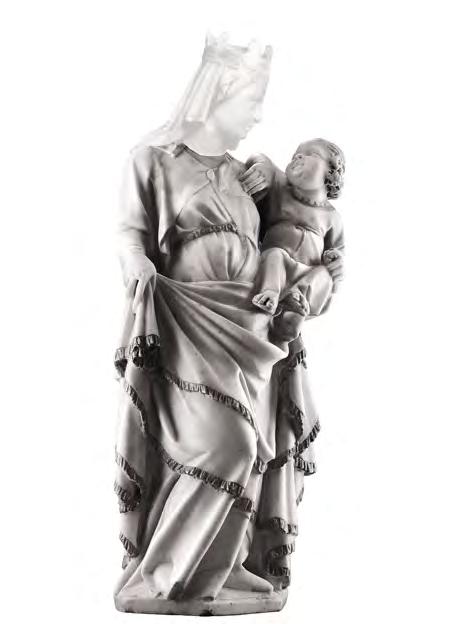

Our demonstration that the head is a late-fifteenth-century work made by the famous Tuscan sculptor for Giovanni Pisano’s headless Madonna does not absolve us from the study of later re-elaborations, of which we have revealed traces by observing the present stuccoing, decisive in determining the current orientation of the Madonna’s face and its dialogue with her Son. This study arose from a comparison between the photograph of the Böhler sculpture taken on the occasion of the 1904 auction (fig. 33) and published in the catalogue of the sale of Léon de Somzée’s Collection (fig. 19), and a modern photograph of the work from the same orientation and viewpoint documented in the early-twentieth-century photograph (fig. 34). This comparison clearly reveals surprising and important, albeit minimal, differences in the position of the Madonna’s head, showing that the restoration and the correction of the fifteenth-century work’s incline are due to the art dealer Julius Böhler, after he acquired the work from the collection of Léon de Somzée.
Benedetto da Maiano’s head must have been very unstable and have undergone repeated interventions between the sixteenth and nineteenth century in order to reattach it to the fourteenth-century sculpture, for which it had been designed (figs. 33-34). However, after he acquired the statuette for his own collection, Julius Böhler decided on a definitive intervention so as to fix the head securely to the pre-existing sculpture. This restoration, which aimed not to alter Benedetto’s brilliant integrative restoration but to exalt the unique nature of this comparison between Gothic and Renaissance in a single masterpiece, made it necessary to use stucco to fix the neck and the veil both at the sides and at the back. It is however important to point out that the stucco did not cover Benedetto’s original junctures between the head and the fourteenth-century sculpture, as they perfectly follow the consistent stylistic flow of the pleats created by Benedetto.
Certainly Julius Böhler’s idea was to recuperate a more correct inclination of the Virgin’s face, so as to recapture as far as possible the original aspect and to emphasise the visual colloquy with Christ, given that the unstable position of the head during the Somzée ownership had led to a disarticulation of the pose that attenuated the intensity of the dialogue (figs. 32-34).
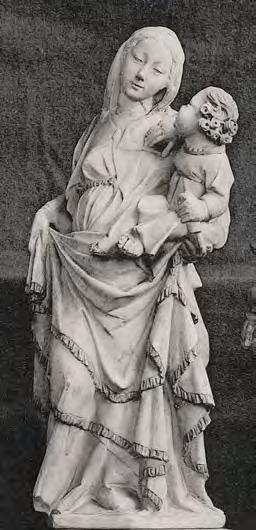

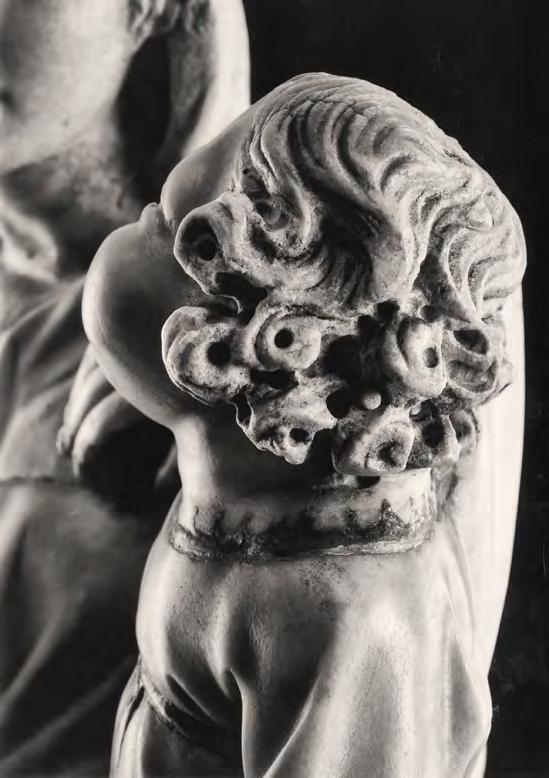

As is shown by a comparison between a modern photograph of the sculpture and the one taken in 1904, the head of the Child, which had also suffered a fall and had been reattached, did not undergo any change in orientation, confirming that the Böhler restoration affected only the head of the Madonna (figs. 33-34).
The head of the Christ Child is one of the supreme masterpieces of Giovanni Pisano (fig. 35). Although broken at the base of the neck, reattached in the fifteenth century and maintained thus by Léon de Somzée and by Julius Böhler, the head of the Böhler Christ Child is distinguished by a skilful working of the curly hair with the drill so as to convey rotundity on the frothy locks (figs. 34, 35). The face was sculpted by Giovanni Pisano in sideways profile, precisely so as to emphasise the Child’s smiling turn towards the Madonna, so as to capture the movement and almost the atmospheric sense of the space in which the Child moves. This is helped by the taut vibration of the rounded cheeks, the expressive creases around the eyes and the softness of the smooth partings in the hair curling around the nape of the neck. This creation of
the idea of the Child who in profile, in an instinctive movement, turns emphatically to fix his eyes on his Mother, is extremely similar to a detail in the relief showing the Massacre of the Innocents, sculpted by Giovanni Pisano for the pulpit of Pisa Cathedral (figs. 35-36). As we can tell by comparing the two children turning towards their own mothers, one in a moment of joyous colloquy and the other in tragic anguish, the expressive intensity that bursts from the skilful working of the curling locks and of the profile of the cheek, nose and eyes, is absolutely the same. This would confirm that the head of the Böhler Christ Child was authentically created by Giovanni Pisano within a few years of the masterpiece for Pisa Cathedral.
Thanks to recent X-rays of the Böhler sculpture, we have been able to observe how the reattachment of the head to the body took place (figs. 38-39). An initial comparison is that between a photograph of the profile of the sculpture’s bust and an X-ray of the sculpture’s profile taken from the opposite side (figs. 37-38).
The head was fixed to the base of the neck by a leaden dowel that extended vertically about half way between the head and the shoulders. In order to insert this reinforcing element, the restorer must have removed Benedetto’s head, thus losing the earlier stuccoing, after which he would have positioned the dowel and re-stuccoed the parts together. In radiography the stuccoing is visible in the horizontal band at the base of the neck. Moreover, the fact that the X-rays are so reflective reveals that it is prevalently composed of gesso and mortar. If we observe the photograph in consideration of this radiographic detail, we see how the Böhler stuccoing faithfully follows Benedetto’s original in correctly recomposing the pleats he sculpted with those of the drapery falling over the back, sculpted by Giovanni Pisano.
The X-ray photograph of the head and bust of the Böhler Madonna shows the position of the dowel in the centre of the neck (fig. 39). The X-rays of the left part of the veil falling from the forehead
demonstrate that, because of the repositioning of the head to recapture the correct orientation of the face, the surfaces of the drapery were stuccoed in order to fix the assemblage at the base of the veil falling over the shoulders. However it is the comparison between this X-ray with a photograph of the back of the Madonna that allows us to read the qualities of the Böhler restoration (figs. 39-40): no fifteenth-century part was altered, but only recomposed in optimum alignment so as to guarantee a solid fixing of the head. The X-ray photograph of the sculpture’s bust reveals that the head of the Christ Child was also consolidated by a leaden dowel inserted during the Böhler restoration (fig. 39). Our hypothesis on the early-twentieth-century conservative restoration is therefore confirmed also as regards the head of the Child, which was consolidated without altering its position, as is demonstrated by a comparison with the auction photograph of 1904, and was then stuccoed at the base of the neck (figs. 33-34, 39).
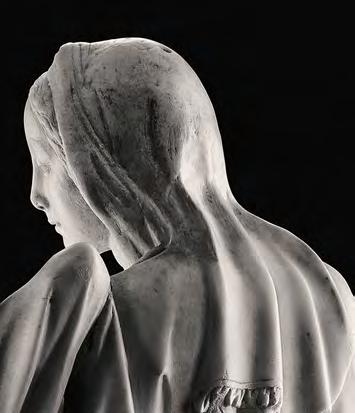
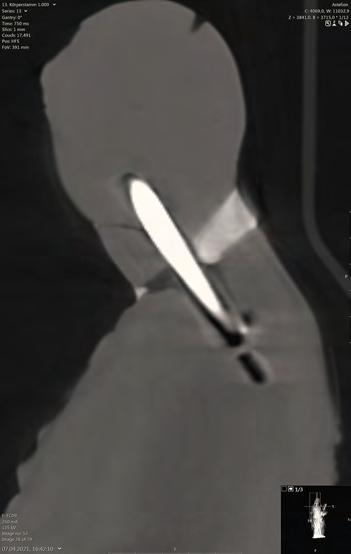

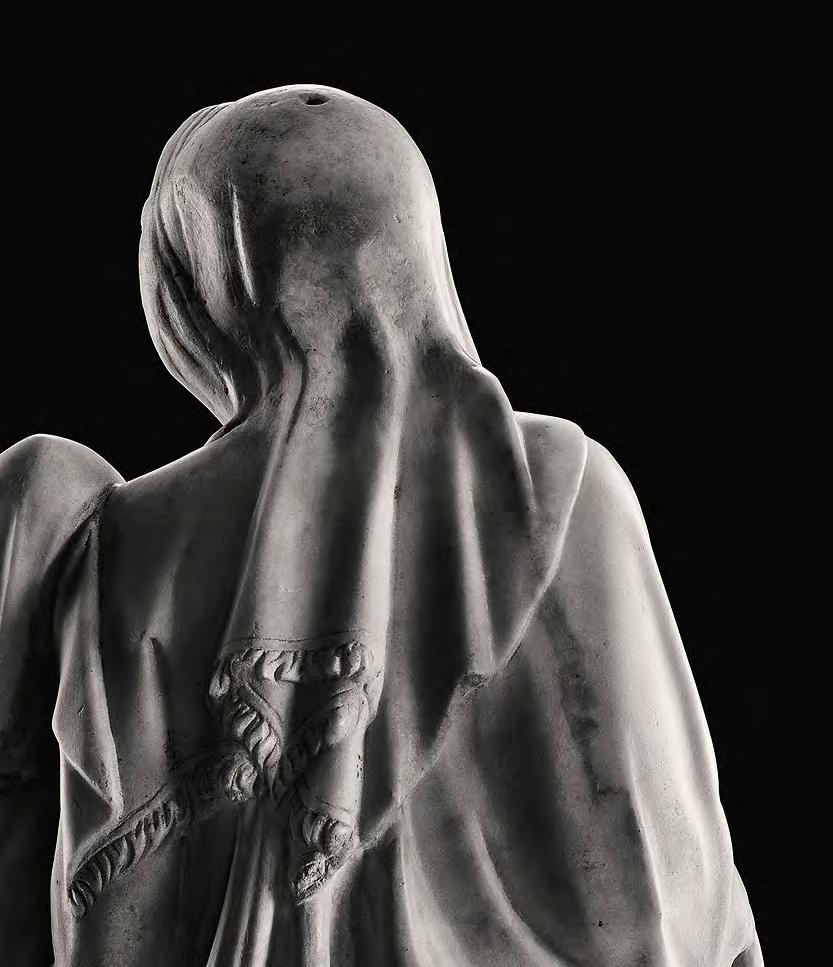
In the Museo Civico di Sant’Agostino in Genoa there is a statuette 47 cm high showing a headless Madonna (figs. 41, 46), now universally recognised as a masterpiece by Giovanni Pisano but unknown at the beginning of the last century both to Venturi and to Volbach, as emerges from their studies of the sculptures by Tino di Camaino and Giovanni Pisano. 86 Furthermore this statuette is mentioned, as a work of comparison for the stylistic understanding of the Böhler Madonna, neither in the two type-written catalogues of the Böhler Collection of 1931 and 1967 87 nor in those of the exhibition held at the Böhler gallery in Munich in 1958. 88 It was only five years later, in 1963, although the sculpture had been part for several decades of the old collection in the Museo Civico di Sant’Agostino, that the statuette was published by Caterina Marcenaro as a work originally belonging to the tomb of Margaret of Brabant by Giovanni Pisano, in the very years when Marcenaro was collaborating with the museologist Franco Albini on the new arrangement for the sculptural group of the elevatio animae, made for the funerary monument to the queen consort of the emperor Henry VII. 89
The work was again studied in the context of the 1987 exhibition ‘Giovanni Pisano a Genova’, and on that occasion underwent cleaning at the restoration department of the Vatican Museums (fig. 46) 90 This conservative intervention clarified that the marble of the statuette is different from that of the other sculptures on the royal tomb, originally in the church of San Francesco in Castelletto in Genoa, given that the marble of these latter presents grey veining that is absent from the Madonna, which is distinguished by a soft alabastrine patina (fig. 46). 91 The statuette of the headless Madonna certainly belongs to the works created by Giovanni in the period he was working in Genoa on the imperial monument, though it is possible that the work was part of the vast
complex of sepulchral architecture or that it was intended for Genoa Cathedral, as part of an altar executed after the donation made by the emperor to the cathedral Chapter, before his departure from Genoa and in memoriam of his consort. Given that the sculptures in the Museo Civico di Sant’Agostino are almost exclusively from Genoese circles, it is highly unlikely that this statuette did not come from Genoa. Although we cannot be certain as to its provenance from the church of San Francesco in Castelletto or from the Cathedral, we can be sure of the dating to the second half of 1313, corresponding to Giovanni’s only Genoese sojourn for the creation of Margaret of Brabant’s tomb. 92
The ‘imperial context’ of the Genoese statue provides an important clue to a dating around the middle of 1313, given the very close stylistic and compositional resemblance to the Böhler Madonna (figs. 41-42). The two sculptures are of similar height: 47 cm the headless Madonna of Genoa and 60.5 cm the Böhler Madonna with the head created by Benedetto da Maiano (figs. 30, 41). The rediscovery of the statuette in the Böhler Collection, in view of its correct attribution to Giovanni Pisano, has made it possible to reconstruct an homogeneous stylistic group of Madonnas holding the Child, all about 60.5 cm tall, which bear witness to Giovanni’s ‘imperial style’ under the influence of the emperor Henry VII. 93 This stylistic reconstruction, something absolutely new in Giovanni Pisano studies, originated in the unprecedented comparison between the Genoa Madonna and the one in the Böhler Collection (figs. 41-42), thus breaking out of the narrow circle of stylistic comparisons hitherto known, which apart from the Madonna in the Museo Civico di Sant’Agostino, includes the headless Madonna donated by Paolo Lasinio to the collection of the Camposanto di Pisa (now in the Museo Nazionale di San Matteo), long thought to be a workshop piece (fig. 43). 94 Our recognition of the stylistic similarity between the Böhler sculpture and the Genoese one has allowed us to reconsider
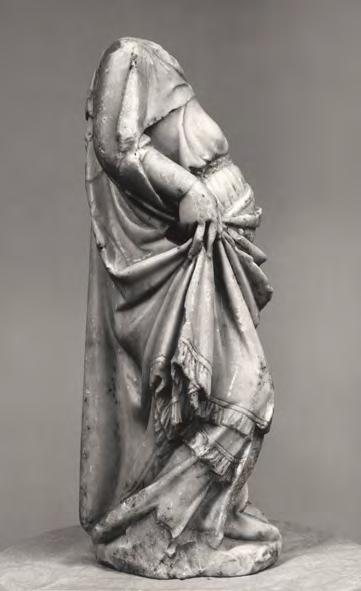


both the notable quality of the headless sculpture in Pisa (fig. 43), 54 cm tall, and to recognise in the headless Madonna in Boston, 47 cm tall, the work of a slavish imitator of the master. 95
The archetypal paragon – at the centre of our study – that allows us to recognise with precision the stylistic features of Giovanni Pisano’s ‘imperial style’ is that between the Genoese statuette and the Böhler Madonna as a work, hitherto lacking, that revolutionises the historical and stylistic understanding with which we observe all the other Madonnas by the sculptor. The attribution of the Böhler statuette to Giovanni Pisano is evidently confirmed in an initial comparison between the right faces of the Madonna and the same viewpoint on the Genoese statue (figs. 41-42). We note the conformity of the same stylistic features: the Virgin’s right knee bent forwards by the foot pointed backwards, forming an angle in respect of the flank in torsion. The emphatic movement of the knee stretches the heavy cloth of the cloak, gathering its lower folds to cover the right foot. The double fringed border of the drapery above and below the right knee of the Böhler Madonna, slightly stretches and raises the cloth, while the
shoulders and breast tend towards the Child. In the Genoese Madonna this tension of the bust and of the right hand is lighter, in fact the same gesture of the hand is less in torsion, although equally concentrated on raising the cloak which, because of the gentler movement of the bust, gathers finer and softer pleats at the belly, while those of the drapery that binds the lap of the Böhler Madonna are tighter and more synthetic.
The stylistic feature that more than any other identifies the handwriting of Giovanni Pisano is the shape of the right hand (figs. 44-45). The wrist, traced by the line of the sleeve’s cloth, flexes arching the back of the hand, a bit more rotated in the Genoese work and slightly curved upwards in the Böhler statuette, on which four dimples in the soft skin of the marble mark the beginning of the slender fingers. In both sculptures the thumb, index and middle finger, sinking into the pleats of the drapery, form the gesture that pins it with the three outstretched fingers, open on the belly, to move it away in the twist and close it to the side, lifting the heavy fabric to form a rich cascade of folds that fall triangularly degrading downwards.


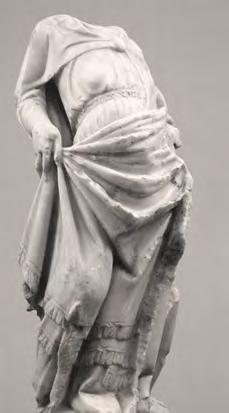
The other two fingers are curled towards the palm of the hand. The stylistic punctum of the composition in both masterpieces by Giovanni Pisano is defined by the emphatic tension of the hand that is both tense and in movement. In both sculptures this gesture releases the compositional lines of the brilliant invention of a double movement, which combines the fluidity of the serpentine twist that goes from the foot to the knee, and to the hand up to the shoulder, culminating in the twisting of the head towards the Child, with the accentuated arching of the back.
The attribution of the Böhler Madonna to Giovanni Pisano and its dating to the Genoese period are confirmed by the observation of the plasticity of the compositional lines of the drapery in this sculpture (figs. 41-42, 44-45). Similarly to the Madonna of Genoa, in which the composition of the three directions of the pleats of the drapery, starting from the gesture of the right hand (from the back, from the cone falling under the hand and from the lap), wander in detailed calligraphic declinations in a slightly tense movement, in the Böhler Madonna the composition and the motif of the drapery, while the angular folds that flow from the back of the cloak into the right hand, those of the drape enveloping the lap and those falling from the fingers of the hand, are sculpted with greater softness and fluidity of movement.
In both statuettes the right wrist, elbow and shoulder create a compositional angle which, in the side view of the work, emphasises the arching of the bust, highlighting the lap unveiled by the drapery, the waist that holds back the folds of the soft garment on the breasts (figs. 41-42). The stylistic feature of the cloak that, fixed by a brooch, envelops the right shoulder sheathing the elbow and uncovering part of the breast, finds a double declination in the two sculptures: in the Genoese Madonna a single pleat of the cloak falls tautly to envelop the arm, creating a space visible in the contrasted chiaroscuro of the pleats between the posterior drapery, the arm and the bust, while in the Böhler Madonna the cloak falls softly from the clasp and the lamellar fold drops vertically right into the opening between the arm and the breast, covering with folds the tight-fitting sleeve of which we note the edge at the wrist.
In the light of these stylistic reflections, which on the basis of this comparison illustrate the topoi of Giovanni’s ‘imperial style’, it appears clear that the original prototype of the compositional elements of the Böhler Madonna is the Madonna in the lunette of the main portal of the Baptistery of Pisa. We will later discuss the relationship with this homogeneous stylistic group of the three Madonnas of the imperial period (figs. 30, 32, 78, 84)
Our new understanding of the corpus of the Madonnas created by Giovanni Pisano around 1312-1313, and therefore also their new stylistic interpretation, derive from the rediscovery of this group’s central figure, the Böhler Madonna (figs. 30, 42).
The sculpture of the Madonna and Child, both headless, conserved in the Museo Nazionale di San Matteo (fig. 43) and 54 cm tall, entered the collection of the Camposanto in Pisa between 1810 and 1815, as a donation by Paolo Lasinio, attributed to Nino Pisano and without indications of provenance. 96 The sculpture was exhibited in the 1987 show ‘Giovanni Pisano a Genova’ and, for that occasion, underwent in Pisa in 1986 a careful cleaning which removed a thick layer of dust. 97 It was Roberto Papini in 1915, studying the Camposanto Collection, who identified the headless statue as the work of Giovanni Pisano, 98 followed by Enzo Carli who indicated the sculpture as a work attributed to the master. 99 In 1972 Seidel, although comparing the Madonna with the Madonna in the Bode Museum in Berlin and with the one in the Museo Civico di Sant’Agostino in Genoa (figs. 43, 46, 55), preferred to be more cautious, affirming that the statuette was the work of a talented assistant of Giovanni who worked closely with the master. 100 The sculpture was again exhibited in 1993 in the show ‘I Marmi di Lasinio’ in Pisa and, in the catalogue entry, Antonino Caleca attributed it to the circle of Giovanni Pisano, considering it a project of the late activity of the master’s workshop. 101 Following these studies, the sculpture is exhibited at the Museo di San Matteo in Pisa in a vitrine, similar to the one that today contains the ivory Madonna by Giovanni Pisano at the Museo della Primaziale. In 2005 Lorenzo Carletti attributed the sculpture to Giovanni Pisano. He confirmed this attribution in 2011 in a study published together with Cristiano Giometti. 102
In view of our present studies, the authenticity of the Madonna of the Museo Nazionale di San Matteo as a work by Giovanni Pisano is confirmed even more clearly by a comparison with the Madonna of Genoa (figs. 41, 43, 46). The Genoese statuette, made during Giovanni’s sojourn in Pisa after August 1313, is a work that expresses the ‘aulico stile imperiale’ of the master’s late maturity. At that time he must have been about sixty-five, given that he is thought to have been born around 1248 and, between 1265 and 1268, collaborated with his father Nicola on the pulpit of Siena Cathedral. 103 It is however unlikely that the statuette was originally located at the summit of the tomb of Queen Margaret of Brabant, as Clario di Fabio argued, 104 since it would have been in contrast with the correct iconography of the tomb’s architectural structure,
which above the queen’s elevatio animae would have envisaged a celestial vision of Christ. It also seems unlikely that the Madonna of the Museo Nazionale di San Matteo was the central element of an altarpiece sculpted in marble in Pisa (and which is supposed to have inspired Tommaso Pisano to make the marble dossal in the church of San Francesco in Pisa, in around 1370), as was proposed by Annarosa Calderoni Masetti, 105 given that it was made to be seen from different angles and that the back is carefully worked (figs. 43, 49).
In the Madonna of the Museo Nazionale di San Matteo (fig. 43) the composition of the stylistic features of the drapery that falls between the right arm and the flank of the cloak, pointed at the breast by the rectangular brooch, and of the pose of the figure with the slight arching of the spine, recall the composition of the Madonna in the lunette of the main doorway of the Pisa Baptistery, signed in the inscription by Giovanni Pisano (fig. 78). The Child in the headless sculpture is slightly detached from the body of the Virgin, whereas in the Baptistery Madonna he is an integral part of the sculptural block of Mary. In view of our studies, it has been possible to propose a new dating to about 1311 for the Baptistery Madonna, as we shall demonstrate in one of our subsections, 106 and to date the headless Madonna of the Museo Nazionale di San Matteo, of which the Baptistery Madonna was one of the prototypes, to 1312 or the early months of 1313 (figs. 43, 78). For evident stylistic reasons, as we shall demonstrate with the comparisons that follow, the correlation between the Madonna of the Museo Nazionale di San Matteo and the Genoese Madonna is closer than the one we find between the Baptistery Madonna and the Madonna of the Museo Nazionale di San Matteo (figs. 43, 46, 78). The Madonna of Genoa in comparison with the headless Madonna of the Museo Nazionale di San Matteo shows the same principal composition elements of the cloak, of the pose, and in particular of the gesture with the right hand (figs. 43, 46). However we notice that the artist, in the Genoese Madonna which is linked to the context of the imperial commission for the sepulchre of Margaret of Brabant, shows in comparison with the headless Madonna of the Museo Nazionale di San Matteo a working of the marble that expresses a greater corporality solidity of the figure, with an emphasis on the softness not only of the rich pleats of the drapery but also of the firmness of the belly and breasts, which recall those sculpted in the elevatio animae of the queen, who as she rises arches her spine in much the same way as the Madonna of the Museo Civico di Sant’Agostino. The stylistic variation between the sculptures in comparison does not in any way affect the works’ quality, but emphasises a slight chronological
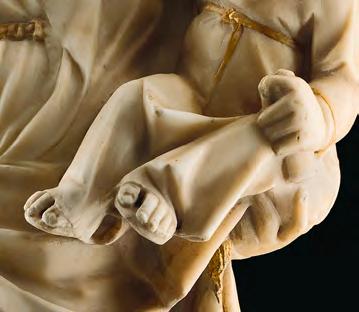
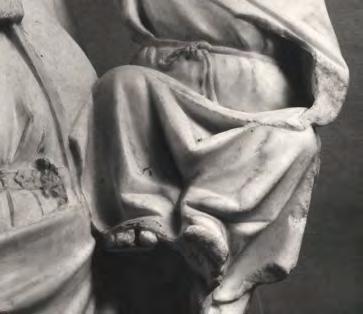
difference that predates by a few months the Pisan work over the Genoese one, since the former is closer to the famous monumental prototype of the Baptistery of Pisa (figs. 43, 46, 78). Giovanni Pisano’s change of style in Genoa is accompanied by greater fluidity of serpentine movement proper to the Genoese Madonna; in comparison, the headless Madonna of the Museo Nazionale di San Matteo, designed in accordance with similar stylistic features, appears endowed with a less evident emphasis in the torsion, just as the gesture of the right hand is calmer and the rotation of the right knee in relation to the shoulders and belly is less pronounced (figs. 41, 43, 46)
The rediscovery of the sculpted figure’s corporality and the thrust of the serpentine movement in the gestures and pose, with a marked tactile sensibility, are all characteristics that we find with greater intensity in the Madonna of Genoa and in the Böhler Madonna (figs. 32, 41, 42, 46). As is shown by the comparison between the detail of the right hand of the Böhler statuette and the bust of the Madonna of the Museo Nazionale di San Matteo (figs. 43-44), the compositional elements are almost the same. In particular, we notice: the drapery of the cloak falling beside the right breast – a stylistic feature that clearly recalls the Baptistery Madonna and that is absent from the Madonna of Genoa because replaced by a space created by the master in order to detach the cloak from the bust (figs. 46, 78) – the verticality of the pleats of the tunic taken up by the girdle and bound by the tight pleats of the cloak, and lastly the ordering of the pleats in the area of the right hand which, raising the heavy drapery, gleans on the back and front neat pleats. Also surprising is the similarity between the three fingers buried in the drapery, while the bent elbow forms a pleat at the sleeve of the cloak.
From a comparison with the Madonna of the Museo Nazionale di San Matteo in Pisa, the style of the Böhler statuette suggests that the work dates from the period of the emperor’s stay in Pisa (from October 1312 to 8 August 1313) and that the sculptor made it a few months before the beginning of his Genoese sojourn, documented by the payment of August 1313 (which possibly
lasted until the inauguration of the funerary monument to Queen Margaret, scheduled for 14 December that year, the anniversary of her death in Genoa in 1311), 107 while for evident stylistic reasons it seems less likely that the statue was made in Pisa in the early months of 1314, after the completion of the funerary monument to Queen Margaret (figs. 42-43)
A splendid example of Giovanni Pisano’s ‘imperial style’ in this period is in the detail of Christ in the Böhler Madonna, which shows its undoubted derivation from the model of the headless Madonna of the Museo Nazionale di San Matteo, although distinguished by a softer modelling of the marble (figs. 47-48). In both sculptures the feet wear sandals and are covered by the cloak, which leaves the toes uncovered and hangs heavily with two horizontal pleats. In the Böhler statuette the variant is minimal but significant: the left foot is detached by a greater vivacity in the torsion of the Child and dissolves with a spontaneous movement the somewhat rigid pose of the Child’s feet and legs in the Museo Nazionale di San Matteo statuette, indicating once again a slightly later dating for the Böhler Madonna. Some stylistic features of both statuettes are rather surprising, such as the drapery of the Child’s tunic, which creases between the knees, and the knotted girdle at the waist that delineates the pleats of the tunic in similar fashion.
Our dating proposals, although articulated in a narrow arc of time of a few months, find splendid confirmation in a comparison between the back of the Böhler Madonna and that of the Madonna in the Museo Nazionale di San Matteo (figs. 49-50). The stylistic feature common to both the Madonna of the Museo Nazionale di San Matteo and the Böhler statuette consists of three principal compositional lines delineated by the pleats at the back of the cloak. The first comprises a vertical pleat that runs from the shoulders to the base, the second is a transverse pleat that runs obliquely from the right hand to the base and the third is a curved line that, falling from the shoulders, flexes elegantly at the fingers of the right hand. This tension of the three lines of composition is transformed in the Böhler Madonna into a grandiose formal synthesis. The three pleats of the drapery are distinguished
from those of the Madonna of the Museo Nazionale di San Matteo by being worked with neater and more essential lines and with a greater plasticity, which neatly detaches the pleats from the background, accentuating the space in chiaroscuro, formed by the triangulation of the pleats. The transformation of the stylistic feature thus appears precisely in this comparison, where the sculptor’s handwriting is renewed in the passage from the fluid drapery of the Madonna of the Museo Nazionale di San Matteo to the neat, and energetically defined, plastic traits of the cloak on the Böhler Madonna.
Giovanni Pisano’s ‘imperial style’ in the years 1312-1313, as well as being documented in the group of works we have illustrated so far, which constitute its nucleus (the Madonna of Genoa (fig. 41), the Böhler Madonna (fig. 42) and the headless Madonna of the Museo Nazionale di San Matteo (fig. 43), had a more ample diffusion in sculptures which, while having a slightly different composition, were created on the basis of a similar compositional idea and with a declination of the same stylistic features.
Giovanni Pisano, creating the abovementioned sculptures of his ‘imperial period’, developed in more ample fashion his style in contemporary works, such as the Madonna of the Girdle in Prato (fig. 51) and the Madonna of the Bode Museum in Berlin (fig. 55), which, distinguished by an imperial crown, turns out for iconographical reasons to be closely connected to the court of the emperor Henry VII.
The diffusion of the courtly style of these years, in which the sculptor creates variants without relying on a pre-established formula, comprehends in primis the Madonna of the Girdle, a supreme masterpiece made by Giovanni Pisano around 1312 and conserved in the Chapel of the Sacred Girdle in Prato Cathedral (figs. 51, 56) 108 The statuette, 69 cm tall, is perfectly conserved and is rightly considered to be slightly earlier than the Madonna of the Museo di Sant’Agostino in Genoa. 109 The commissioning of the Prato Madonna from Giovanni Pisano followed an attempted theft of the Girdle, which determined the commission for the celebrated sculptor to make an image of the Virgin to protect the relic, for which a chapel dedicated to Mary was set up in the Pieve.110


The story of the Girdle, narrated in an anonymous fourteenthcentury manuscript chronicle, originally owned by the canon Gioacchino Pelagatti and surviving only in later copies, 111 recounts how the relic, woven by the Blessed Virgin, was brought from Jerusalem by a Pratese pilgrim named Michele as a gift for his wife, who after her death bequeathed it to the rector of the Pieve in Prato. The earliest certain testimony for the Girdle dates from a chapter of the Statutes of the Comune of Prato of 1276-1279 entitled ‘de plebe in festo sante Marie et de […] cingulum eius’; 112 another chapter of the same Statutes, dated between 1285 and 1294, refers to the ancient custody of the relic: ‘Camerarii comunis Prati teneantur expresse non diffirmare a aliquo modo cingulum beate Marie virginis […]’ 113. It was attested on 8 July 1293, through a payment to a certain Lippo Accompagnati on the part of the General Council of the Comune of Prato, that the Girdle was venerated by the faithful on an altar in the Pieve: ‘camerarii comunis, solvant dee pecunia comuni Lippo Accompagnati sedecim soldos pro remuneratione sui servicii quod stetit ad facienda fieri opus altari beate virginis Marie plebis Sancti Stephani pro custodia cinture beate virginis Marie’. 114 The official recognition of the cultus of the Sacred Girdle took place in 1298 with a letter of 14 February that year, written in Pistoia by the legate of Pope Boniface VIII, Matteo d’Acquasparta, General of the Order of Friars Minor and Cardinal-Bishop of Porto, who granted absolution from their sins to all those who visited the Pieve during the festivities when the sacred relic was displayed. 115
The resounding attempt to steal the Girdle was perpetrated by Giovanni, known as Musciattino, son of the Pistoian notary ser Landetto. After the secular cleric had broken the locks of the entrance to the altar, in the night before Thursday 28 July 1312, ‘speçato l’uscio dell’altare, in mano prese la cassettina d’avorio con detta Cinctura pretiosa et sanctissima’ [having smashed the entrance to the altar, he took in his hands the ivory container with the said precious and most holy Girdle] 116. According to the Book of the Virgin’s Miracles, it happened that the Madonna, offended by this base action, filled the soul of Musciattino with such anguish that his lantern went out and he lost his way inside the Pieve. 117 The cleric was so astonished that he replaced the ivory container on the altar. His lantern regained its light and he once again ran with the relic towards the door of the church, losing his way because his lantern again went out. 118 It was the canons’ cook who encountered Musciattino wandering in the darkened church and noticed that the container of the Girdle was missing from the altar. He began to shout: ‘Correte, correte, canonici, correte, perché la Cintola della Vergine gloriosa ci è
stata rubata’ [Run, run, canons, because the Girdle of the glorious Virgin has been stolen] 119. It was said that Musciattino defended himself by saying that the theft was on behalf of the city of Florence, which was prepared to reward the villain for the precious relic. 120 Such was the veneration of the Pratesi for the Girdle that the whole population rose up, and the Podestà of Prato, Baldo de Castelnuovo from Perugia, issued a severe sentence: Musciattino was tied to an ass’s tail and dragged through the streets, after which both his hands were severed outside the Pieve. 121
The account of the attempted theft and of the miracles of the Virgin allow us to understand the true political and religious dynamics that at that time induced the Comune to commission a sculpture of the Virgin and Child from such a leading artist as Giovanni Pisano (fig. 51) and to deliberate in General Council the construction of a new chapel inside the Pieve. 122 Around 1312 Prato was in fact attempting to distinguish itself politically both from Florence and from Pistoia, augmenting its role as an autonomous city proud of its own civic identity. 123 The presence of the relic in the Pieve of Prato notably augmented the ecclesiastical independence of the bishop of Prato. The Girdle concentrated on Prato the attention of all the inhabitants in the surrounding countryside, and made of the city an important place of pilgrimage. 124 This political operation was desired especially by the Comune, which profited from the religious and miraculous attraction of the relic in order to increase its own power. The custody and management of the Girdle were always organised by the Comune of Prato, as is testified by a deliberation of the Comune on 20 October 1330 which, on the basis of a rubric in the Statute of 1287, 125 decreed that the box containing the relic should be provided with two locks, the keys of which were to be kept by the Comune, as had already been ordered in an act of the Comune of 4 July 1293. 126 The ostension of the Girdle was however the responsibility of the canons, whose hands were to be covered in gloves of cloth-of-gold, as was required by an act of 30 April 1321. 127
What is most important for our studies is to note that the attempted theft was followed, on the next day, by a deliberation of the General Council of 29 July 1312, with which the Comune decreed the construction of a new chapel, in which to keep the Girdle and to celebrate its political and religious cultus. 128 The project described in the deliberation of 31 July 1312 envisaged ‘quod de novo fiat quedam Capella pro dicto cingulo conservando qui sit coniuncta ecclesie plebis de Burgo ex latere vie sive strate per directum navis dicte ecclesie iuxta tribunam dicte

ecclesie’ 129 and the Comune earmarked 500 lire to pay for it. This sum was paid in nine instalments from 24 December 1317 until 2 April 1322. 130 The great damage threatened to city of Prato was thus transformed into an incentive to pursue the policies of the Comune through the celebrated object, one of the most famous relics in Christendom. Although the project to build the chapel was held up, because of the Comune’s need to finance the war against the troops of the emperor Henry VII and, later, against the Ghibellines of Uguccione della Faggiola, it was between 29 July and 1 August 1312, this latter being the date of the institution of a specific Opera for the creation of the Chapel of the Girdle (an indication of the importance of the commission), 131 that decisions were taken about the construction of the chapel and the commissioning of the sculpture of the Madonna and Child from Giovanni Pisano, probably shortly after the terminus a quo of 1 August 1312 (fig. 51). However, no trace of this commission awarded to the celebrated sculptor survives among the documents of the
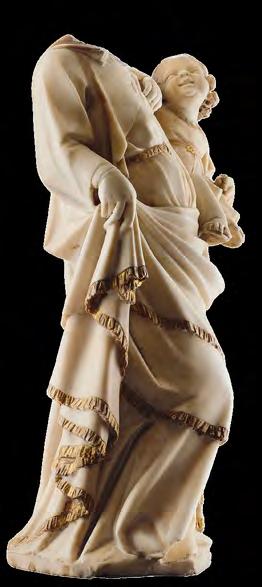
Comune. Building work on the chapel would go ahead with long pauses in the years to come, while the sculpture by Giovanni Pisano was by 1312-1313 (according to our stylistic analysis) already on the altar where the Sacred Girdle was kept, to watch over the relic while waiting for the chapel to be completed. In view of the narrative of the miracle performed by the Virgin, who put out Musciattino’s lantern in the darkened Pieve, 132 we can easily understand how urgent it was for the Comune, so as to make reparation for the grave offence committed by the Pistoiese villain against the Madonna, and to reinforce the cultus of the relic, to personify the miraculous image of the Virgin in a sculpture by the celebrated master.
We come to the comparison between the Böhler Madonna and the Madonna of Prato, (figs. 51-52): with a photomontage we hypothetically applied the head of the Virgin of Prato to the Böhler statuette, substituting it for the head created by Benedetto
Fig. 51 Giovanni Pisano, Madonna and Child, Prato, Duomo, Chapel of the Girdle Fig. 52 Giovanni Pisano, headless Madonna and Child, (photographic simulation of the sculpture minus the head by Benedetto da Maiano), Starnberg, Böhler Collectionda Maiano so as to recover the figure’s original tension (fig. 32). In the Böhler Madonna we note the same stylistic features present in the Pratese masterpiece both in the supple and tapered serpentine pose and in the hand gesture that raises the drapery and forms a concentration of pleats around the belly and at the back of the cloak. Though we cannot observe in the Böhler Madonna the intensity of the original dialogue between Mother and Son, nor the tension of the Virgin’s neck as the culmination of the figure’s serpentine movement, we can notice how the artist varied the position of the Child’s right hand. In the Madonna of Prato, with a rare iconographic invention, Giovanni Pisano represented Christ as placing the crown on Mary’s head, as a symbol of her coronation in heaven (fig. 89). In the Böhler Madonna the Child places his hand delicately on the Virgin’s breast, accentuating the turn of the bust and favouring a more intimate visual dialogue with Mary (figs. 32, 52). Christ’s gesture in the Madonna of Prato emphasises the work’s sacred and political importance. In the Böhler Madonna, on the other hand, the smile of Christ seems typical of a work of private devotion. The sculptor, aware of the singular politico-ecclesiastical commission for the celebration of the cultus of the Girdle and so as to emphasise the mystery of the relic’s presence in Prato, substituted for the girdle, in his representation of Mary who gave her belt to the Pratesi (fig. 51), a band of soft pleats of the cloak adhering beneath the breast. Thus he devised an iconography that was never used again in other Madonnas in this group. In fact the Böhler Virgin (fig. 52), like those of Genoa (fig. 46), of the old Collezione Lasinio (fig. 43), of the Baptistery in Pisa (fig. 78) and of Berlin (fig. 55), are all belted beneath the breasts by a girdle worked with decorations that allude to metal. This iconographic difference implies a variation in the clothing of the Madonna of Prato who does not present, like the Böhler and the other Madonnas of this stylistic group, the cloak falling or stretched between the right hand and the breast. The iconography of the Madonna of Prato allowed the sculptor to vary the typology of her clothing. The figure in fact wears a soft tunic elegantly worked at the neck and an almost translucid cloak with very fine pleats, enriched by an embroidered flounce with fringes.
The stylistic features of Giovanni’s ‘imperial style’ are present in the Madonna of Prato, in the stylistic similarity with the Böhler Madonna, in formulas attenuated by the different iconographies of the two sculptures (figs. 51-52). From a careful observation it appears likely that the stylistic features of the Madonna of Prato developed in continuity with the Böhler statuette: starting from the serpentine tapering of the drapery in the Madonna of Prato,
where the artist accentuated the bending of the right knee and the torsion of the bust and shoulders. We note moreover how the gesture of the right hand assumes in the Böhler Virgin, from the closed and reclined wrist, a position detached from the flank so as to create a space between the body and the taut drapery. The statuette of the Madonna of Prato is closer in the serpentine movement, where the wrist fluidly accompanies the fall of the cloth, holding the cloak against the side with the arm.
To illustrate how Giovanni Pisano was able to vary the stylistic features of the Madonnas in the period of his ‘imperial style’, we wanted to include in the present studies the famous Madonna of Berlin conserved in the Bode Museum (fig. 55). In an essay published in the journal Pantheon in 1972, Seidel attributed it to Giovanni Pisano, confirming Bode’s attribution that was published in 1886 before the acquisition of the statuette for the collection of Italian sculptures of the future Kaiser-Friedrich-Museum in Berlin. 133 Seidel’s 1972 article refuted not only the proposals of Sauerlandt and Venturi, who saw in the sculpture a work by Tino di Camaino, because they were misled by an inexact comparison with the Madonna of Turin (figs. 55-57), 134 but also the erroneous attributions of Harald Keller and Pietro Toesca to a follower of Giovanni Pisano. 135 After the sculpture was returned to the Bode Museum by the USSR, Seidel was the first to observe and study this work, after long decades when it was inaccessible, because he had been commissioned by the Academy of Sciences of the GDR to catalogue the Tuscan sculptures returned by the USSR. In his essay, Seidel based his attribution of the Berlin Madonna on the rediscovery in 1962 of the Madonna of Genoa, identifying the Böhler Madonna as a work close to the Berlin masterpiece and as the prototype from which the Madonna of San Michele in Pisa derived (figs. 30, 46, 55, 100).
In view of the present studies, which have made it possible to identify the Böhler Madonna as an authentic work by Giovanni Pisano, the Pisan provenance of the Böhler statuette has been clarified on the basis of comparisons with the two Madonnas of Pisa that are certainly by the hand of Giovanni himself: the one from the old Collezione Lasinio and the one on the main doorway of the Baptistery (figs. 42, 43, 78). The group of Madonnas in the ‘imperial style’ of the years 1312-1313 thus clearly emerges, showing that the Böhler Madonna is a work that is fully part of the sculptor’s stylistic phase at the time of the second Pisan sojourn of the emperor Henry VII. The dialogue between the Virgin and Child in the Madonna of Prato (fig. 51), emphasised by the vibrant tension of the tapered body in the drapery of the
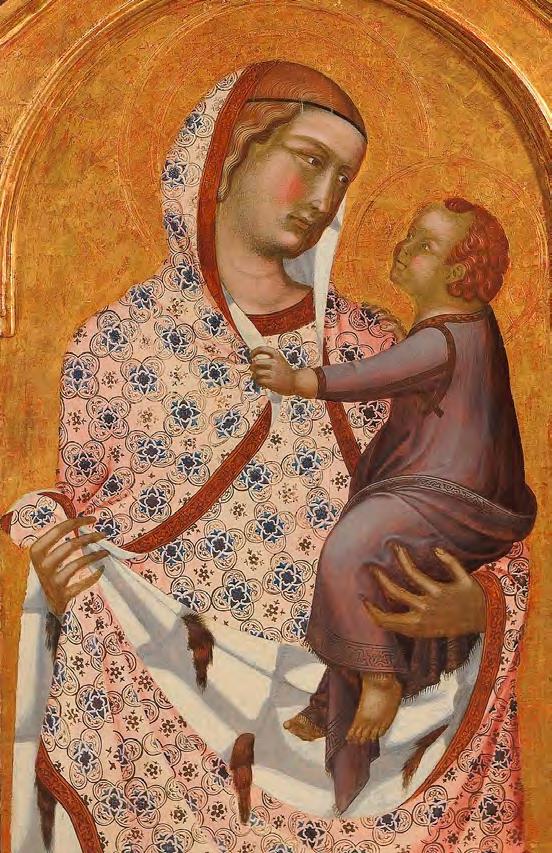

cloak, turns out to be even more intense in the Madonna of Berlin (fig. 55). The sculptor has varied the formula of the stylistic feature in the position of the arm and hand of Christ, who for this reason participates even more in the emphatic tension of his Mother. In this expressive impetus Giovanni Pisano has captured the instant when the Child, turning, encounters the profound gaze of the Virgin. In what is one of the peaks of the master’s art, the frothy hair emphasises the smile on the face, defined by the dimples on the cheeks and around the eyes, making the figure’s movement perceptible in the air.
With extraordinary iconographic inventiveness Giovanni Pisano has characterised the two Madonnas differently. The Prato one is distinguished by the absence of a girdle and by a crown that alludes to Ecclesia (fig. 56), the Madonna of Berlin on the other hand is the only one of all the sculpted Madonnas of Italian art of the late Romanesque and early decades of the fourteenth century to wear an imperial crown (fig. 55), the same one that Giovanni Pisano sculpted as an attribute of Justice for the tomb of Margaret of Brabant, described in the liturgy for the imperial coronation that took place in Rome on 29 June 1312.
Thus, the suspicion arises that the Madonna of Berlin was created by Giovanni Pisano after the return of the emperor to Pisa following his coronation in St John Lateran, as a homage to Henry VII on the part of his faithful imperial city (fig. 55). This extraordinary iconography of the Madonna invested with the imperial crown reflects Henry VII’s idea of reinforcing the close connection between Imperium and Ecclesia, 136 in defence of the ferocious defamation of Robert of Anjou against the emperor and the Ghibelline city of Pisa, accused of being enemies of the Church by the king of Naples himself.
The stylistic feature common both to the Madonna of Prato and to the Madonna of Berlin consists of three compositional lines traced by the pleats of drapery at the back of the cloak (figs. 58-59) As we observed in our comparison between the back of the headless Madonna of the Museo Nazionale di San Matteo and the Böhler statuette (figs. 49-50), also on the backs of the Madonna of Prato and of the Madonna of Berlin Giovanni Pisano constructed a triangulation of lines traced by the pleats of drapery (figs. 58-59): a vertical one from the shoulders to the base, a diagonal one from the base to the right hand and a curved one that from the shoulders runs below the elbow as far as the fingers that gather the drapery. In the Berlin statuette the pleats, which in the Madonna of Prato fall elegantly beneath the right arm, are strongly articulated and with more marked emphasis, while the vertical pleat, which outlines the straight line, divides to form two pleats, sculpted to form intense depths in the surface of the marble.
The amazement aroused among artists by the group of Madonnas defined by the courtly imperial style can be better understood if we compare the well-preserved Madonnas of Prato and of Berlin with two paintings by Pietro Lorenzetti, the Madonna and Child in the Tarlati Polyptych and the Madonna and Child in the lower Basilica of San Francesco in Assisi (figs. 53-54), which surprisingly reflect, without any direct imitation, the stylistic and expressive essence of the two Madonnas by Giovanni Pisano in the spiritual intensity of the dialogue between Mary and Christ. It is a splendid testimony to the high value that artists of the time attributed to these works by Giovanni Pisano.

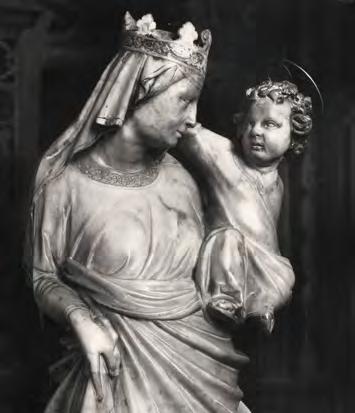
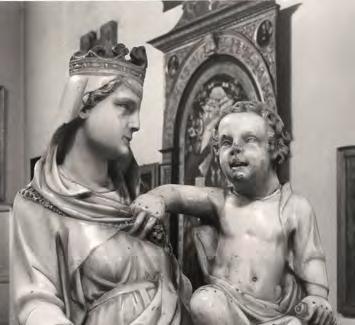

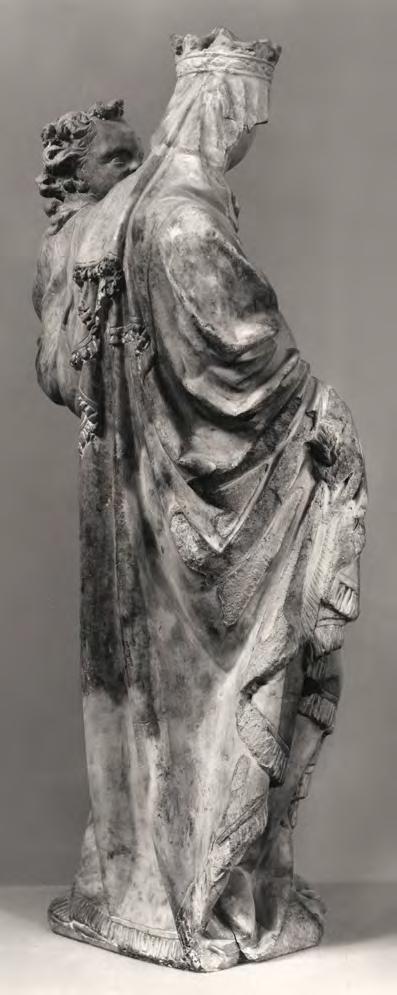
In 1310-1315, the years of the creation of the Madonnas in Giovanni Pisano’s ‘stile aulico’, the Codex Manesse was composed in Zurich and illustrated with precious miniatures to accompany the richest song- collection of Old High German courtly lyrics, the Minnelieder. On folio 372r of the Codex the Minnesänger Johannes Hadlaub, whose contribution to the lyric corpus is the most extensive, praises the collection made by the celebrated member of the Zurich Council, Rüdiger Manesse (who died in 1304) and by his son Johannes. It seems likely that the songbooks cited by Hadlaub formed the nucleus of the codex now in the library of the University of Heidelberg. 137
The miniatures of the Codex Manesse illustrate, starting from the courtly poetic formulas of the Minnesang, the gestures, fashions and poses of the knights and ladies at the courts north of the Alps. In the miniature that accompanies the amorous lyrics of Count Gottfried von Neifen we observe the stylistic features of chivalric fashion in the courtly taste (fig. 60). Gottfried, attested between 1234 and 1279, lived in the family castle situated between Nürtingen and Reutlingen. 138 Within a rectangle, traced by a red external frame and a blue internal one decorated with ochre rhombi, we see the poet courting his lady against a grassy landscape and a neutral background. In his left hand he holds a parchment alluding to the words of the courtly lyric addressed to the lady, while his right hand raised to his face alludes to the sufferings of amorous desire in the Minneklage. The crown of roses is an attribute that reveals how, having laid down his knightly weapons, the young poet had been awarded the crown of victory in the courtly contest.
The Neifen coat of arms, three horns with gules cordlets on an azure ground, appears above the figure of the poet, while above the lady a crest is painted with the same three horns. In considering the correlation between the stylistic features of the courtly lyric and the figurative ones present in the miniature, we note that, in a balanced counterpoint of gestures, the hands of the poet correspond to the inverted ones of the lady, who holds her left hand to her breast while with her right she raises the rich drapery, slightly arching her back.
In the miniature illustrating the Count von Neifen’s lyric we can identify the principal stylistic features of female fashion in the courts north of the Alps (fig. 60). Both figures wear a cloak lined with fur, distinctive sign of their social status. The poet’s cloak is red, reaches to his shins and is fixed at the breast, so as to cover the green tunic beneath, edged at the neck and wrists, and to show the fur lining at the height of the legs. The lady wears an ochre cloak reaching to the ground, the fur lining being visible beneath the folds falling from the right elbow, which presses to her side a fold of the cloak, and from the heavy cloth of the cloak gathered by the left arm. The lady’s left hand elegantly raises the drapery of her blue tunic, forming a rich series of pleats from the right foot to the left hand. The gesture of raising the cloak emphasises the figure’s serpentine pose, accentuated by the arching of the spine and by the head inclined to the left. These characteristics of the articulated drapery of the lady’s cloak and tunic, and especially the gesture of her left hand, are surprisingly reminiscent of the Böhler Madonna (figs. 7, 52, 60). This comparison, which clarifies the style of the rich and articulated dress of the Böhler Madonna, demonstrates that Giovanni Pisano was inspired by the sumptuous dresses worn by ladies at the court of Henry VII, which the sculptor would have observed during the Pisan sojourn of the emperor and his entourage.

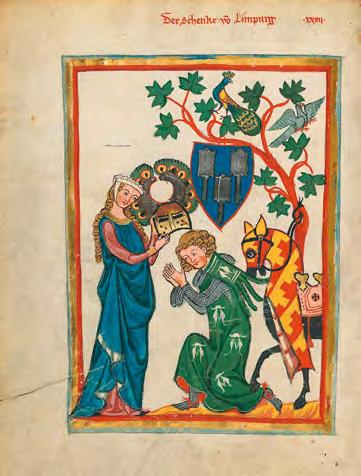
The lady’s headdress in the Codex Manesse miniature covers the head with a sort of starched crownlet, while her chin is bound by the strap of the wimple (fig. 60). This type of headdress is typical in northern Gothic images of empresses such as Adelaide of Burgundy, as attested by her sculpted portrait in Meissen Cathedral, or Margaret of Brabant, as shown in the representation of her elevatio animae created by Giovanni Pisano for the queen’s funerary monument in Genoa. 139
A second miniature in the Codex Manesse introduces the courtly lyrics of the house of Von Limburg, linked to the Staufen dynasty (fig. 61). It is not clear whether the poet is Walther I (documented between 1230 and 1249-53) or one of his two sons, Walther II (known between 1251-1253 and 1282) or Konrad I (recorded between 1256 and 1280). 140 The miniature illustrates a scene typical of courtly love, in which the lady places a crest on the head of her beloved knight. The artist, inspired by the courtly stylistic features of the lyrics, plays lovingly on the ambivalence between the chivalric duel, which aspires to demonstrate prowess in arms so as to win the heart of the lady, and the lyrical duel in poetical lovemaking. In view of this ambivalence, derived from the topoi of courtly love, the poet-knight wears over his chain-mail that protects him in battle down to his spur-clad feet, a sleeveless green

cloak with a hood, decorated with the white initials of the word AMOR. The knight is shown kneeling with his hands raised in a gesture of amorous devotion as he waits to be crowned by his beloved with a crested helmet. The crest is adorned with peacock feathers. The peacock, symbol of perseverance in love, is shown among the leaves of the tree together with a dove. Hanging from the tree is the family coat of arms, three sable maces on an azure ground. It is by careful observation of the lady’s clothing that we can deepen our understanding of chivalric fashion, typical also of the court of Henry VII, which inspired Giovanni Pisano for the sumptuous dress of the Böhler Madonna (figs. 62). It is in fact documented that Henry VII was accompanied in Italy by a Minnesänger from Lorraine. 141 Unlike the previous miniature (fig. 60), where the figures wear winter clothing and the scene is bare, in this illustration the birds perched in the leafy tree and the absence of the heavy fur-lined cloaks show that it is spring (fig. 61). The lady’s sleeveless blue tunic falls softly and with rich pleats over an ochre dress bordered at the neck and wrists. Unlike the serpentine pose with the hand raising the drapery in the previous miniature (fig. 60), in this image we note that the artist, given that the lady’s hands are supporting the crest, has chosen to represent another characteristic of the female fashion of the time, i.e. the tunic fixed at the side so that abundant pleats in the heavy cloth
fall cone-like (fig. 61). Comparing this detail, typical of courtly fashion, with a side view of the Böhler statuette we note that, behind the sculpture’s left arm bent to carry the Christ Child, the heavy drapery of the tunic worn by Mary is sewn to her side, and is not supported by her hand, just as we see in the lady of the Codex Manesse (figs. 61-62). Compared with the sculpture created by Giovanni Pisano (fig. 62), the lady in the miniature illustrating the Von Limburg lyrics appears lighter and more slender, not only because she lacks a heavy cloak (fig. 61), such as is worn by the lady in the previous miniature (fig. 60), but above all because the sculptor has emphasised the plastic variations of the pleats in the Madonna’s cloak and dress, rendering the effect of the heavy cloth’s tactile qualities and potentiating the stylistic features of ladies’ fashions at the court of Henry VII. So, for his invention of the richly articulated drapery in the clothing of the Böhler statuette, Giovanni Pisano drew on precise poses and stylistic features of those ladies’ fashions.

The description of courtly fashions related to the Tuscan dolce stil nuovo courtly lyric finds a significant representative in Francesco da Barberino, who was born in 1264 to a Ghibelline family and studied at the studium of Liberal Arts in Florence under Brunetto Latini, qualifying as a notary in Bologna in 1294. 142 After the death of his father, he was episcopal notary in Florence from 1297 to 1303, where he came into contact with the dolce stil nuovo literary circles of Dante Alighieri and Guido Guinizzelli. 143 His Ghibelline position obliged him to leave Florence for Padua in 1304 and for Treviso in 1308. During the period of the Italian expedition of the emperor Henry VII, i.e. between 1309 and 1313, he was at the papal court of Clement V at Avignon and at the court of Philippe the Fair at Paris, as a diplomat and jurisconsult in the relations between the kingdom of France and the republic of Venice. 144 From some time between 6 January (when Henry VII was crowned in the church of Sant’Ambrogio in Milan) and 11 December 1311 (the day before the death of Queen Margaret) the letter from Francesco da Barberino was written to Henry VII King of Italy. In it we gather how he believed in the Ghibelline ideology that recognised the emperor as the executor of universal justice according to the Divine design. 145 From the text of this letter emerges his close link with Dante, and a clear echo of the themes in the latter’s fifth letter, dated 1 September 1310, and in particular the praise of imperial justice. 146 With the Supreme Poet, Francesco da Barberino shared not only the pro-imperial political ideal but also a knowledge of the lyrics on fin amor by the Provençal troubadours and of the dolce stil nuovo poetry. Evidence of this in found in two of Francesco’s allegorical treatises, ‘Documenti d’Amore’, illustrated with twenty-seven miniatures and drawings by the author, and ‘Reggimento e costumi di donna’. A Latin commentary on Dante’s Inferno, composed by Francesco, documents his profound knowledge of Virgil. 147
After the death of Henry VII, in particular between 1314 and 1315, Francesco da Barberino returned to Florence and then went to Venice. Disagreements between Guelfs and Ghibellines were still very fiery, and indeed they culminated at the battle of Montecatini on 29 August 1315. 148 Only after his definitive return to Florence, between 1317 and 1318, did he complete his allegorical treatise, in hendecasyllabics and septenaries in prose and unrhymed vernacular verse, ‘Reggimento e costumi di donna’, which is a mirror of the fashions, costumes and modes of various social classes, based on a severe morality that adheres to a tradition of antique noble families and is antecedent to the customs
described by Boccaccio in the proem to the ‘Decameron’. 149
The ‘Reggimento e costumi di donna’ was begun before the ‘Documenti d’Amore’, written during the period at the French court, and was completed during Francesco’s final Florentine period. The treatise, being punctuated in the degrees of training of the lady by personifications of Virtue, and being formulated on the genre of the allegorical-didactic exemplum of fashion and the honoured customs of the women described according to the merits of the stil novo and courtly lyric, clearly derives from French literary models such as the ‘Roman de la rose’. On the model of the poetic invocations in Virgil, in the proem of the ‘Reggimento’ Madama addresses the author, referring to the colloquy with Onestade and the invitation to compose a work on the ‘ornate costumes’ of women. As Eloquenza illustrates, the severe morals impose on the author a scheme of costumes and fashion according to the social status of the ladies, from the ‘daughter of an emperor or crowned king’ to the female workers in the fields. 150
So in Francesco da Barberino and in his writings, in particular the Reggimento, two aspects of his political and poetical personality are joined, fundamental for an understanding of fashion at the court of Henry VII: this influenced the rich clothing of the Böhler Madonna (figs. 6-10, 63), made by Giovanni in Pisa during the months of the emperor’s second sojourn: his Ghibelline ideology in favour of Henry VII, and his fondness for the costumes and fashions derived from the feudal culture of the French court.
The fifth part of the ‘Reggimento e costumi di donna’ is devoted to rules governing the married woman’s behaviour and begins with a dialogue between Chastity and the Donzella, in which Francesco develops a series of warnings on fashion according to the various social degrees. Initially he deals with the modes, gestures and clothes of the queen during her wedding night. 151 As we learn from the story in verse, the king as soon as ‘dawn appears’ and ‘the people are sleeping’ leaves the nuptial chamber and goes hunting ‘with all his people’. 152 The queen is thus joined in her chamber by the damsels who dress and entertain her; later she is led to a large room ‘from which the knights and all other damsels have been driven, in order to give security to this woman, as is most suitable’. 153 At this point in the narrative of the queen’s behaviour, in the morning after the wedding night, Francesco describes the movements and attitudes of a woman of the aristocratic class, in a way surprisingly similar to the cadenced gestures of the movement of the rich drapery of the Böhler Madonna: ‘stay on top of yourself as much as you can and may you move your hands on your cloak so that it doesn’t look like stone.’ 154 These
verses are an extraordinary document on the female fashions and modes of the court, and perfectly describe the gesture of taking the cloak into the left hand, as made by the lady in the Gottfried von Neifen miniature in the Codex Manesse (fig. 60) and especially in the Böhler statuette (figs. 62-63), where we note that the Madonna, portrayed in clothing typical of aristocratic ladies at court, lifts the heavy drapery of her cloak while turning slightly, emphasising the complex interplay of pleats, so as not to seem rigid or immobile. Francesco’s splendid indication ‘ché non paia pietra’ [so that it doesn’t look like stone] almost seems like a descriptive slang notation and reveals itself as twofold in its interpretation in the light of the two female figures treated, the queen described by Francesco and the sculpted Madonna. The writer alludes to the idea that the ‘beauty and solemn stature’ of the queen’s clothes, given by the heavy and complex draperies worn, do not appear rigid like those of a marble figure, while the sculptor, by depicting the same gestures, not only confers a identity of rank on the beauty of the figure but also wishes to enliven it so that it does not seem only made of stone (figs. 6-10, 63)
Ladies’ fashion in Pisa during the sojourn of the emperor Henry VII, which was reflected in the clothing of the Böhler Madonna, found a significant continuation at the Neapolitan court of Robert of Anjou, which was of French origin. Although he was regarded in much of Italy, especially by his Guelf enemies, as being of Germanic custom and culture, Henry VII was the son of Beatrice d’Asvesnes and was educated for several years at the court of the French king, in French. This was the only language he spoke apart from a certain amount of Latin, 155 as Albertino Mussato tells us in the Regis descriptio of the ‘Historia Augusta’ written after spending long months, around 1311, at Henry VII’s court in the capacity of notary and delegate for the city of Padua: ‘Idioma Gallicum, satisque se conferens intelligentia Latinorum’ 156. Furthermore Henry VII was, as Count of Luxembourg, knighted by Philippe the Fair in 1294 and was a vassal of the king of France. 157
In the years following the emperor’s death in 1313, between 1318 and 1325 in particular, the bitter conflict between Guelphs and Ghibellines, led respectively by Robert of Anjou and by Henry VII, had calmed down. The common French culture between the court of Luxembourg and that of France therefore favoured a continuity of customs and fashion that influenced the artists who gravitated around the court of France and of the Anjou in Italy. In particular, this continuation can be observed in some miniatures by Jean Pucelle of the precious Book of Hours of Jeanne d’Évreux,
now in the Cloisters Collection of the Metropolitan Museum of New York. 158 The manuscript was probably illuminated by Pucelle in 1325 on the occasion of the marriage of Jeanne d’Évreux to Charles IV d’Anjou. 159 The miniatures illustrate the lives of Christ and of St Louis IX of France, and the codex was conceived for the exclusive use of the queen, for prayer at the various hours of the day. In the grisaille miniature that represents the Annunciation, we note how the Virgin is of notable stature compared to the architecture and the Angel, for the gestures of the pose and especially for the plastic chiaroscuro of the pleats, contrasted as though the figure were inspired by sculpture (fig. 66). Compared with the clothing depicted in the Codex Manesse miniature. (fig. 60), we notice how this courtly mode was further developed in Paris in accordance with the French taste for the soft falling of rich and fluidly designed pleats (fig. 66). The Virgin of the Annunciation, like the Böhler statuette, (figs. 7, 63, 66) wears an ample cloak that envelops the tunic beneath and is raised by the left hand in that gesture, codified by Francesco da Barberino in his Reggimento, that was characteristic of aristocratic ladies. The serpentine pose of the painted figure is accentuated by her arched back and by the movement of the right flank in correspondence to which the Virgin raises her prayerbook and, although the figure turns to the Archangel and the Böhler statuette to Christ, the gestures and movements of the two Madonnas appear specularly similar.
This fashion had already reached Italy some years before the Pucelle codex from the Anjou court, and is seen in Simone Martini’s frescoes in the Chapel of St Martin in the lower Basilica of San Francesco in Assisi (fig. 65). Simone Martini had finished the frescoes in the chapel around 1318, one year after spending a period at the court of King Robert of Anjou in Naples. Among the female saints shown in trilobed arches supported by twisted colonnettes, the Magdalene is depicted wearing the French fashion, with a cloak falling into rich pleats from the left arm, while in similar fashion to all the sculptures we have seen so far she raises with her right hand the hem of the cloak, in a light gesture (figs. 42, 43, 46, 65). As well as the confluence of the canons of fashion, we notice here a singular fusion between the stylistic features of fashion at the Paris court and Tuscan Gothic art, in the comparison between the Annunciation, depicted by Pucelle, and the Announcement of the death of the Virgin from the crowning of Duccio’s Maestà (figs. 64, 66). The French painter admired the Sienese image but transformed its compositional model by combining French statuary with Duccio’s scenography; the Virgin is in fact shown no longer seated but standing up,
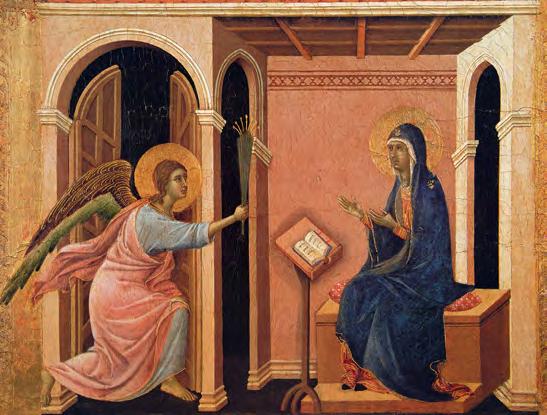
accentuating her plastic, almost sculptural, presence inside the room. The stature and monumental pose of the Virgin in the miniature are reinforced by the representation of the rich garments and the complex variations in the drapery, absent from the panel by Duccio but typical of fashion at the court of the French queen. The size of the standing Mary in the Book of Hours has induced the painter to re-proportion the relationships between the figures and the architectural space of the room, borrowing from Duccio’s panel both the coffered ceiling and the double arch where the Archangel arrives. Pucelle, to make space for the statue-like size of the Virgin, heightens and lengthens Mary’s room, reducing the loggia where the Angel stands and adding the sloping roof with a loggia where five angels appear in the arches. In Duccio on the other hand the two spaces appear lower and equally divided by the architectural opening cesura of the two doors (figs. 64, 66). Pucelle corrected the perspective of Duccio’s angel, depicted in a space between the open door and the room but not included in the architecture, in a figure perspectively inserted into the architectural foreshortening both with the wing and with the left foot, creating a loggia open on three sides in front of the access door to Mary’s room. Despite the change in the details of the spatial representation, the importance of this comparison is revealed in the extraordinary artistic dialogue between France and Tuscany, which could almost be identified as a stylistic fusion between the ideal of beauty of the French court and that of Sienese painting. This comparison also reflects the context of the fashion of the Böhler Madonna’s clothes between the courts beyond the Alps and Pisan statuary.


In the early months of 1308 Baldwin of Luxembourg, younger brother of Henry VII, was designated Archbishop of Trier thanks to the support of the French king, Philippe IV, who hoped to have a supporter in one of the pre-eminent ecclesiastical offices. 160 In this way Baldwin became one of the three clerical electors for the Holy Roman Empire. Between 1294, the year Henry VII was appointed vassal of Philippe the Fair who later knighted him, and 1 May 1308, the date of the death of Albert I, the political links between Henry VII and the French monarchy were solid. 161 In fact Henry VII adhered in 1302 to the protest of the French nobles against Pope Boniface VIII and in 1306 together with his brother Baldwin he swore fealty to Philippe IV of France. Both the political balance between the courts of Luxembourg and France and the political role of Baldwin changed after 1 May 1308, the day of the assassination of Albert I King of the Romans by a group of Swabian nobles. 162 Philippe IV of France tried to advance his brother Charles de Valois as candidate for the imperial throne, seeking the support of Pope Clement V, but the German electors feared an emperor who would have severely curtailed their powers. 163 Decisive among the leading German electors was the position of the new Archbishop of Trier, Baldwin, and of the Archbishop of Mainz, Peter von Aspelt who came from a town in Luxembourg, in favour of the election of Henry VII as the new sovereign of the Holy Roman Empire, which took place in Frankfurt on 27 November 1308 and was followed by the imperial coronation at Aachen on 6 January 1309. 164
The Italian campaign of Henry VII from 1310 to 1313, who had the aim of being crowned in Rome by the pope and of pursuing the expansion of the empire under a single idea of universal justice, was described with splendid miniatures in a codex commissioned by Henry’s brother Baldwin and illustrated in accordance with his precise instructions. 165 Baldwin, who followed his brother into Italy as far as the second Pisan sojourn, took the trouble to have illustrated not only the principal political events but also certain scenes of court life in the presence both of the emperor and of his consort. 166 One of the most significant miniatures for the study of fashions and customs at the court of Henry VII is the one on folio 8 which shows an imperial banquet (fig. 68). Henry VII with the crown and his brother Baldwin with the archiepiscopal mitre are seated with two high court dignitaries at a table laden with food served on trays and pyxes; the queen consort Margaret of Brabant, second from the left, who is wearing a larger crown, sits at a table laden with fish and bread, separated from her husband’s


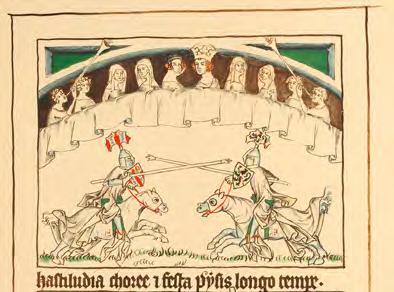

male court and entertained by a lady of high rank, engaged in conversation with two other ladies. The pace of the banquet is governed by a maître who beats his staff to call two servants who carry to the two tables two enormous soupières. We note that the two imperial courts of the emperor and of his queen were distinct in their internal ménage, and their relations depended on necessary matrimonial occurrences of a political or social nature. What is most surprising is that the costume worn by Margaret of Brabant, comprising a white wimple, a cloak joined by a silken cord and the crown, was imitated by all the pre-eminent ladies (fig. 68) The fashion introduced by Queen Margaret with her arrival in Italy beside her husband was unknown in the peninsula prior to 1310. With her fashions she influenced the costumes of her entourage and to a lesser extent high-class female clothing in Italy. It was Albertino Mussato in the Reginae descriptio of his ‘Historia Augusta’ who defined, after a rare and valuable physical description of Margaret, this royal fashion:
Augusta (Regina) annum jam sextum et trigesimum agens, impuberis habet aspectum, cui color albus, fusca caelaries, maxillae teretes, nasi rubra acies, os pusillum facie et ocellis ridenti simillimis. Labellum inferius mentum et colla velum tegit circumductum Germano ritu, amictus laxior Gallico more, statura paulo breviore mediocri. 167
The august Queen Margaret at the age of thirty-six had light hair, a youthful appearance and small laughing eyes. However, what most interests our studies is the accurate description of the veil that binds the lower lip and chin, covering the whole neck. This is in fact clearly shown in the Codex Balduini miniature, where we note that wimple covers the neck of the queen and of her ladies; the hair contained by the crown is also bound with a snow-white veil (fig. 68). Mussato in his description affirms that this fashion, which he had never seen before in Italy, derived from the Teutonic usage (Germano ritu), and from French custom (Gallico more), which were appreciated both by Margaret of Brabant and by her husband Henry VII.
On folio 34 of the codex in the upper register we find another scene of imperial court life in Italy. It shows a tournament of knights that took place in Pisa during the emperor’s second sojourn on his return from his coronation in Rome.
It was visited by Henry VII who was attended by a high ranking lady and surrounded by two depictions of ladies and two pages (fig. 69). We note that Baldwin was not so much interested in showing the places and landscapes of Italy but rather in giving a detailed depiction of the pre-eminent personages of the imperial court, of the fashions and customs, of the heraldry and armour of the knights in the imperial entourage. In the context of the influence of Margaret of Brabant’s fashion gallico more, we note in this miniature that also the court ladies with veiled heads, and in particular the high ranking lady next to Henry VII, who does not wear a crown because she is not his consort, are wearing – two years after the death of Margaret – the white wimple that covers the neck, chin and part of the hair, in the Teutonic manner (fig. 69). In the Santa Caterina Polyptych, painted by Simone Martini towards the end of the first decade in the fourteenth century, we find important evidence of the influence on fashion introduced by Queen Margaret to the high ranking ladies of Pisa (fig. 67). The painter showed in the predella a female saint of noble rank, with a diadem and a cloak lined with fur, with the typical white wimple of Teutonic tradition. This saint, hitherto ignored or mistakenly identified as St Lucy, 168 is in fact a rare representation of St Anastasia Pharmacolytria (fig. 67). As is testified by some Croatian icons imported to Rome in the ninth century, Anastasia is traditionally shown as a Roman matron of the gens patricia carrying a vase of curative ointment, in as much as she devoted herself to curing the wounds of Christian martyrs. Simone Martini painted her with a crown and wimple, typical attributes of a woman of high social standing, and a vase that now appears black but was once silvered. She turns with her pharmacon towards the wounded body of the Risen Christ. In the whole polyptych, which includes six female saints, she is the only one dressed in the manner of Henry VII’s court, a rare testimony to an exclusive fashion that was followed by only a handful of Pisan ladies (figs. 67-69)
One of the miniatures in the Codex Balduini conserved complete in the colouring the backgrounds, figures and clothing is on folio 10 (fig. 76), showing Henry VII on the throne, after his coronation as King of Italy in the Basilica of Sant’Ambrogio in Milan on 6 January 1311. The inscription below the image reads: ‘Rex sedes in trono iudicio turres destruxit in Melant.’ 169 Although the miniature illustrates the king’s judgement from the royal throne on representatives of the city of Milan, the insignia and costume worn by Henry VII correspond to those described by Albertino Mussato in the Coronatio apud Milanum of his ‘Historia Augusta’ dealing with the appearance of the new king on a horse after his coronation:



Triumphans igitur in Mediolano Rex Henricus Corona Ferrea insigniri justa legis imperialis sanctionem antiqua statuit. […] Phaleratis rubro scarleto cum purpureis tegumentis supra vertices latis […] Rege Sceptrum manu dextera gestante […] aureo lilio supra renitente. 170
In the miniature in the Koblenz Codex we note in fact that Henry VII is wearing a purple cloak, according to the imperial tradition that we see for instance in a miniature in an Evangeliary of Otto III, the flowered sceptre (symbol of the Iustitia Imperatoris that he exercises over the mediolanenses) and the Iron Crown (fig. 76)
These costumes and insignia are united to a typical French royal fashion in the style of his hair beneath the crown. In the Regis descriptio compiled by Albertino Mussato in his ‘Historia Augusta’ after long months spent at the court of Henry VII, the emperor’s appearance is described thus:
Homo gracilis, statura prope iuxta, colore, capilloque subruffis, eminentibus supercilis, sinistri oculi albuginem detegit plus aequo mobilitas. De planicie in acutum apicem nasus se porrigit. Ore venusto, mento terete, coma Gallica […]. 171
Mussato does not neglect, after the description of the emperor’s stature, comportment and facial features, such as the eye affected by leucoma, to attribute the origin of his hairstyle to the French fashion, coma Gallica. The frothy curls tightly rolled in series around the head at the level of the ears derive from a characteristic fashion of the kings of France, as we see in a representation of St Louis IX in a miniature in the Book of Hours of Jean d’Évreux (fig. 70). The son of Blanche of Castille is shown kneeling in a gesture of humility and under the crown shows the typical royal French hair, with curls turned outwards to form volutes at the sides of the face. In an early-fourteenth-century sculpture that shows St Louis IX in the church of Mainneville in Normandy, we note the same fashion with curls (fig. 75). This royal French fashion was transmitted also to the kings of the Anjou dynasty, precisely through the cultus of St Louis who, as is shown by his representation as patron saint of the Anjou dynasty by Simone Martini in the Chapel of St Martin in the lower Basilica of San Francesco in Assisi (fig. 71), is portrayed with softly wavy hair curled outwards at the ears.
Four years after the event depicted in the miniature in the Codex Balduini, showing Henry VII on the throne in Milan in 1311 (fig. 76), Tino di Camaino sculpted an image of the emperor enthroned

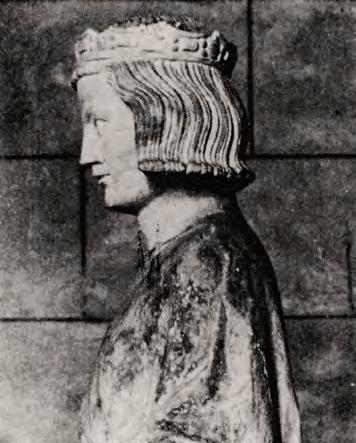

surrounded by six court dignitaries for his funerary monument in the apse of Pisa Cathedral (fig. 74). Given that the emperor’s statue was to be located very high up on the wall of the apse, so that it could be seen by the whole Pisan people assembled in church, the sculptor accentuated the size of the imperial crown, especially in its height. This crown alludes to the one with which Henry VII was crowned emperor in Rome and differs from the crown of the King of Italy. As we see in the fascinating portrait sculpted by Tino di Camaino, the pointed episcopal mitre is surrounded by the crown with its trilobed flowers, on a circular base decorated with lozenges (fig. 74). Although the emperor had been dead for two years, the sculptor did not forget, in relation to the crown, to show Henry VII’s hairstyle in the French fashion. Behind the neck Tino sculpted the curls below the ears. This detail of the hairstyle removes any possible doubt about the identity of the figure portrayed: it could not possibly be the emperor Louis the Bavarian, as has recently been proposed. 172
The emperor’s coronation in Rome is illustrated in the Codex Balduini on folio 23. The three cardinals, distinguished by their red hats, place on the head of Henry VII, seated on the Leonine throne, the imperial insignia comprising mitre and crown (fig. 73) Among the insigna imperialia we note the stole, the cloak and
the sceptre. Baldwin took the trouble to confer on the figure in majesty not only a hairstyle according to the gallico more of the kings of France but also that favourite gesture of French royals, grasping with the left hand the silken cord of the cloak. This is shown by a comparison with a sculpture, dated circa 1240, showing King Philippe Auguste in the cathedral of Notre Dame in Rheims as he holds the sceptre in his left hand and with his right grasps the cord of his cloak (fig. 72). 173
These final reflections on the fashions at Henry VII’s court demonstrate that the fashion of the clothing in the Böhler Madonna can be clearly understood only if it is inserted into the larger picture of the study of costumes at the imperial court, so strongly influenced by French fashions and by the couple Henry VII and Margaret of Brabant (figs. 6-10). This panorama of studies in fact allows us better to comprehend the importance of the affinity between the stylistic features of ladies’ clothing shown in the Codex Manesse, the expression of aristocratic chivalry from north of the Alps, and those of the rich garments of the Böhler Madonna, created by Giovanni Pisano around 1313, i.e. the time of the emperor’s second Pisan sojourn (figs. 60-62).
Fig. 76 H enry VII presides over the tribunal in Milan, Codex Balduini, Kaiser Heinrichs Romfahrt, Koblenz, Landeshauptarchiv, 1 C 1, c. 10



An old Alinari photograph shows the sculptural group of the Madonna and Child, St John the Baptist in the place of honour with the patron, and St John the Evangelist, in the lunette above the main doorway to the Baptistery of Pisa (fig. 77). On the original base of the statue of the Madonna there is an inscription with the signature of Giovanni Pisano; this work has since the beginnings of art history been admired as his monumental masterpiece together with the sculptures of St John the Evangelist and St John the Baptist, for which workshop assistance has been noted (figs. 77, 84). Compared with the present location of the sculptural group in the new Museo dell’Opera della Primaziale Pisana, recalling with its and inspired and scholarly arrangement the original context, in the Alinari photograph it is possible to observe the sculptural complex in its original proportions, in respect to the architecture of the lunette surmounting the imposing doorway, and to re-acquire the viewpoint for which these sculptures were originally conceived (fig. 77). We note in fact that Giovanni Pisano carefully designed the proportions of the figures in the light of his sensitivity to the relationship between architectural ordo and sculpture, both for the minute proportions and for the monumental ones. In particular, it is surprising how the poses and movements of the three sculptures and of the Madonna in the first place are accentuated by the arches of the lunette and by the embrasure of the doorway.
We should like to propose a new study on the Madonna of the Pisan Baptistery by Giovanni Pisano, in the light of the rediscovery of the Böhler Madonna (figs. 7, 78). This comparison, never before drawn to the attention of scholars, allows us to confirm definitively the attribution of the Böhler statuette to Giovanni Pisano and to illustrate the stylistic relations between the group of Madonnas in Giovanni’s ‘aulico stile imperiale’ and the Madonna of the Baptistery.
Surprising, for the extraordinary richness of its stylistic details, is the comparison between a detail of the front of the Böhler Madonna and the almost identical section of the Madonna of the Pisan Baptistery (figs. 79-80). The extreme resemblance is revealed not only in the composition of the figure’s traits, such as the hand, the cloak, the bust as far as the right shoulder, but also in the style, despite small variations. For despite Baptistery Madonna’s very poor state of conservation, it is possible to observe the similarity between the two works in the gesture of the right hand, which raises the hem of the cloak while the three fingers are buried in the pleats of the heavy cloth. In both sculptures the right arm bends at the elbow, which remains closer to the flank in the Baptistery Madonna and more open in the Böhler Madonna, in which we note an elegant space of volumetric depth sculpted between the flank and the elbow. This slight declination in the movement of the arm between the two works, and consequently of the right shoulder, is due to the greater expressive emphasis of the Böhler sculpture, characterised by an accentuated serpentine movement with respect to the fixed frontal monumentality of the Madonna of the Baptistery which, unlike the other sculpture, was intended to be seen only from the front. The rounded vision of the Böhler Madonna allowed the sculptor to work the figure in all its details, to emphasise the threedimensional plasticity and the serpentine movement (figs. 6-10). There is a notable similarity in the form of the cloak, fixed by an oval brooch above the chest, beneath which the pleats of the tunic design the breasts and reappear around the girdle (figs. 79-80). Despite the abrasion of the marble surfaces of the cloak in the Baptistery Madonna, which has involved a slight loss in the thickness of the cloth’s pleats, we note that in the two works the composition of the cloak’s drapery and its tension, due to the gesture of the right hand, are mirrored in the articulating of an almost specular number and movement of pleats.
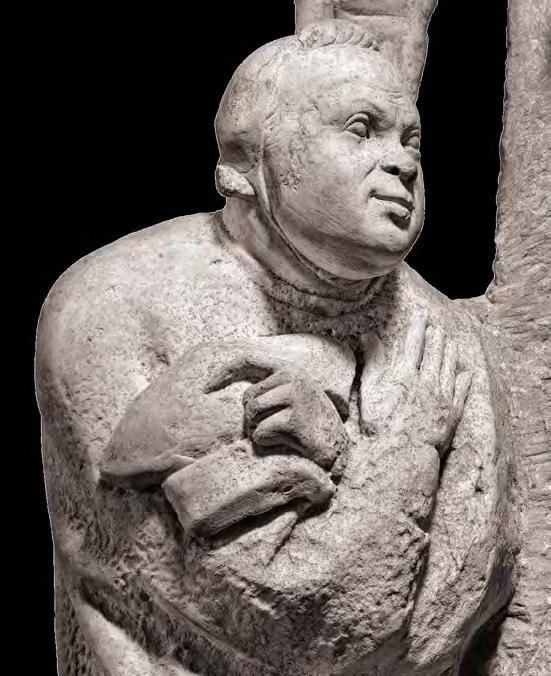

From every stylistic feature we gather the surprising stylistic similarity between the two Madonnas in question, strengthening beyond any particle of doubt the attribution of the Böhler statuette to Giovanni Pisano (figs. 79-80). At the same time, it is nevertheless important to observe how Giovanni declined the stylistic variations, which define the two different works and their distinct patronages and destinations. The Böhler Madonna was conceived as a statuette to be seen from close up, about 60.5 cm tall, calculating the measurements with a hypothetical original head, while the Madonna of the Baptistery, 180 cm tall, was a sculpture with a strongly monumental character (figs. 32, 78)
These respective characteristics of the two works are mirrored in the type of working of the marble, which emerges from an examination of minute stylistic details. In the Böhler Madonna the right hem of the cloak, open at the side of the breast and falling towards the flank with lamellar pleats, has a palpable subtlety in the delicate adherence of the fabric to the breast, united to the plastic tactile quality of the pleats above the girdle, not at all comparable to the rigid composition of the same pleats, thick and neat, in the same detail of the Baptistery Madonna (figs. 79-80); the pleats of the cloak fall vertically in the latter, without the fluid articulation of movement that we read in the Böhler statuette.
This great transformation towards subtilitas and the tactile sensibility of Giovanni Pisano’s ‘imperial style’, expressed with variations of the same compositional stylistic features, can be observed in the passage from the monumental work for the Pisan Baptistery to the group of small Madonnas, among which the absolute masterpiece is the Böhler Madonna (figs. 41, 42, 78) Consequently the new stylistic evaluations, emerging from the comparison between the Baptistery Madonna and the Böhler statuette (figs. 7, 78, 79-80), prompted us to reconsider the dating of the Madonna of the Baptistery precisely in the light of the dating, to around 1313, of the Böhler Madonna. Thus we distinguish the group of statuettes of the so-called ‘imperial style’, dating from the period in 1312-1313 of the second Pisan sojourn of the emperor Henry VII and his court, from the monumental work for the Baptistery which we propose to date to 1311, a stylistic period distinct from Giovanni’s imperial one and at the time when the emperor Henry VII was in northern Italy. To demonstrate the validity of our new dating proposal, which has allowed us to cast light also on the figure of the Operarius patron who is shown beside St John the Baptist in the sculptural complex of the Baptistery (fig. 84), we will illustrate new analyses of the documents and of the inscription at the base of the Baptistery Madonna, in virtue of new stylistic revelations that have emerged from the comparison of the two sculptures in question.
The problem of the dating of the sculptural group of the Madonna of the Baptistery is intrinsically linked to the patron, who is mentioned in the inscription at the base of the sculpture and is portrayed in an act of devotion to the Virgin (figs. 81, 84). The solution to this conundrum is to cast light on the identity of this Petrus mentioned in the inscription. The block of stone, 66 cm high, that acted as the original base for the Madonna, is an octagon worked at the profiles with moulded cornices; on it, in a surface of 31 x 66 cm, is sculpted the inscription that extends as far as the short sides of the front of the base and for a short space also on the right side (fig. 78) 174 The text of the inscription is extremely sophisticated in its articulation:
SUB PETRI CURA HAEC PIA FUIT SCULPTA FIGURA NICOLI NATO SCULPTORE JOHANNE VOCATOThis is a text notable in primis for its composition, which reveals how Giovanni Pisano was aware of the importance of his work and wanted this to appear well visible in the inscription. The artist places himself immediately under the name of the patron Petrus,
thus finding himself at the centre of the composition, given the extension of his signature with which he records his descendance from his father Nicola: NICOLI NATO SCULPTORE JOHANNE
VOCATO. The social prestige of the artist, who proclaims himself a sculptor, emerges not only from the closeness to the name of the Operarius patron but also from the description of the sculpture not in generic terms as hoc opus but as a pia sculpta figura, with which Pisa celebrates her holy Protectress. The linguistic sophistication of the text is revealed in this very detail: sculpta is in fact predicated both of the verb fuit and as adjective of the substantive pia figura Praise of the sculpture as a pious figure emphasises the glory of the artist, who has set his name at the centre of the inscription.
On the identity of the Pietro Operaio dell’Opera del Battistero di Pisa, under whose watch the sculptor created the celebrated figure of the Madonna, and thus on the dating of the sculptural group above the doorway of the Baptistery, an opinion was given by Antonino Caleca in 2001. 175 In his article Caleca proposes interpreting the phrase sub Petri cura in the inscription as a dating of the sculptures ‘to the time of the archpriest Pietro (and thus before 1286)’. 176 This dating, proposed by Caleca in 2001, went to clarify what the same scholar had proposed in his book ‘Dotta Mano’ in 1991, based on a documentary appendix relating to the deeds conserved in the archive of the Opera della Primaziale. 177 In his study of 1991, Caleca proposed a dating for the sculptural group to around 1284, on the basis of a document of 13 March 1284 178 and under the patronage of the archpriest Petrus, cited in a document of 12 June 1295 as the engaged party together with the Operarius Bonaccorso and the Chapter of Canons in a payment in favour of Giovanni Pisano: ‘magistrum Petrum olim Archipresbiterum pisanum agentem pro dicto Capitulo et Opera ex una parte, et dictum magistrum Iohannem ex alia.’ 179 With regard to a second hypothesis, also proposed by Caleca, according to which the dating could be postponed to after 1306, under a layman Pietro, four documents dated between 1306 and 1322 are referred to, in which a certain Ser Petrus is mentioned, a layman, as Operarius of the Baptistery of Pisa. 180 On 15 May 1306 a document ratified the appointment of ‘Petrus quodam Cionis’ as Operarius of San Giovanni, and he was cited also in a document of 18 May 1308. 181 A document of 19-20 June 1315 refers to a certain ‘Dominus Petrus’ as being the Operarius of San Giovanni, and that of 30 September 1322, the final mention, cites Ser Petrus as Operarius of San Giovanni, expressly mentioning his lay status. 182 To cast light on the dating of the work and at the same time to identify which Pietro is referred to in the inscription, given that the arc of time from 1284 to ‘after 1306 until 1322’ that emerges
from the documents is extremely wide, we have carefully examined the representation of the Operarius who is presented by St John the Baptist to the Virgin as he kneels humbly before her, with his hands crossed on his breast (fig. 81). Giovanni Pisano reveals for the first time in this figure an extraordinary talent for portraiture, which goes beyond the icasticity of sacred images, representing not only the bourgeois status of the Operarius but also his distinctively popular facial features. The detail that reveals the identity of the Operarius is however the hat, which he grasps in his left hand while he crosses his hands on his breast. The patron is in fact shown wrapped in a simple tunic as, in an act of devotion, he kneels down and removes his hat, leaving visible on his head a cap tied under his chin, made of white cotton or wool, which covers his head and ears revealing only a few strands of hair on his forehead. The particular shape of the hat and the cap attest that the Operarius was characterised by the common clothing of a lay citizen of the first half of the fourteenth century, as is confirmed by a comparison with a detail of the fresco of Buon Governo by Ambrogio Lorenzetti, in which a shoemaker is depicted with the same hat composed of a band that surrounds the forehead and a soft fabric with two high ends (figs. 81-82). It follows that the patron represented by Giovanni Pisano cannot possibly be a cleric, for his clothing does not belong to that social class, but is a layman. This observation, studied in the light of the previously cited documents, allows us to exclude from the dating the period of the archpriest Pietro and to accept as a possible time- frame, in which we will indicate a probable dating, only the period from 1306 to 1322, identified by the four documents cited above, 183 which mention the layman Petrus quodam Cionis as Operarius of the Baptistery of Pisa (fig. 81). In 2019 Marco Collareta and Lorenzo Carletti proposed as a dating for the Baptistery Madonna ‘a period identifiable with the Operarius Pietro who was in office from 1306’ 184, and this proposal implicitly strengthens our identification of Pietro as the layman Petrus Cioni and not as an archpriest, even though this indefinite chronology does not allow for a precise dating of the sculptural group.
Our thesis on the other hand is based not only on the correct identification of the Operarius (fig. 81), and thus on identifying as valid the period from 1306 to 1322, but also on a hitherto unprecedented stylistic reading of the Baptistery Madonna compared to the Böhler Madonna (figs. 79-80), which we have previously illustrated in the close transition from monumentality to subtilitas in Giovanni Pisano’s style. For this reason we propose a dating of the Baptistery Madonna to circa 1311, i.e. after Giovanni had finished the pulpit for Pisa Cathedral in December 1310 (1311 in Pisan style). 185
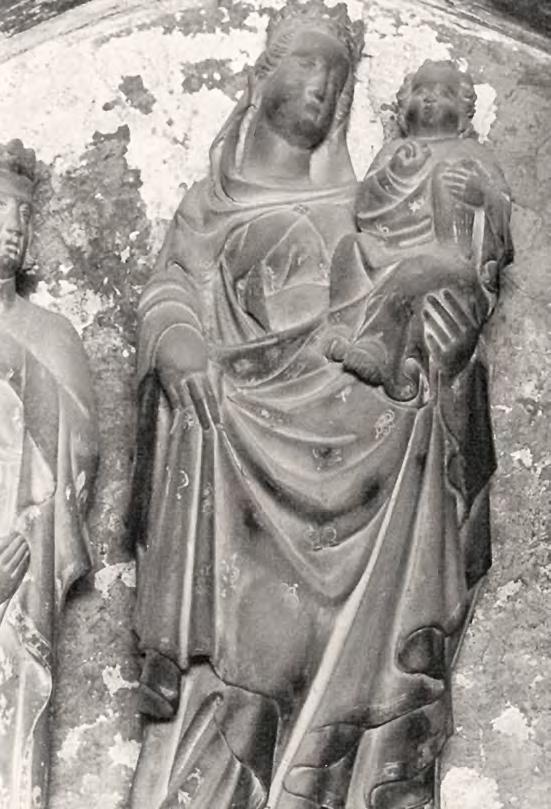
The present state of conservation of the Madonna of the Baptistery emerges in all its problematic nature in comparison with a detail in the abovementioned Alinari photograph, which shows the sculptural group still in its original position in the lunette of the main doorway of the Baptistery (figs. 78, 84). Notable abrasions are visible on the marble surface of the right shoulder, on the hand that raises the drapery, on much of the cloak and on the right knee (fig. 78). From the tubular fold in the centre of the drapery, which falls from the pointing of the cloak on the left side, the marble surface has largely been lost, causing an attenuation of the effect of the bending of the fold up to above the base. The infant Christ is presented today without the nineteenth-century additions (fig. 78), visible in the Alinari photograph (fig. 77), of the head, the arms and part of the legs. From the Alinari photograph, observing in parallel the present position of the body and arms of Christ, we note that the nineteenth-century restorer followed the original composition of the sculpture, i.e. a lack of the direct visual colloquy between Mother and Child, who was presented facing the faithful frontally and blessing them. In the present state we note such a discrepancy between the body of the Christ Child and the size of the Madonna’s head that it is impossible to reconstruct

a direct visual relationship between the two figures, such as we find in the Böhler Madonna (figs. 30, 32, 78). A testimony of how the original iconographic composition of the Baptistery Madonna might have appeared emerges from a comparison with the Madonna and Child made by Tino di Camaino for the lunette surmounting the tomb in the funerary monument to Marie de Valois in the church of Santa Chiara in Naples (figs. 83) 186 In the Neapolitan sculpture, the Child is shown frontally and giving his blessing, without any kind of visual dialogue with the Virgin, as we suppose also for the Baptistery Madonna and as is suggested by the nineteenth-century restoration, which followed the original appearance of the Christ Child. The dating of Tino di Camaino’s Neapolitan work to 1335-1337 and the location of the Madonna in the lunette of the funerary monument, suggest that the sculpture could be a distant memory of Tino’s Pisan period, and in particular of the famous monumental Madonna sculpted by Giovanni Pisano for the lunette above the Pisa Baptistery doorway. Comparison between the Madonna of the Pisa Baptistery, which we have dated to around 1311, with Christ in benediction held in his Mother’s arms and facing the faithful, and Böhler Madonna, made during the period of the ‘imperial style’, around 1313, shows the transformation of a monumental sculptural prototype into the proportions and iconography of a statuette for an altar (figs. 30, 32, 78). The iconographic idea of a Virgin in majesty, made for a famous monument in the centre of Pisa, was transformed two years later into a work characterised by a delicate tactile working of the marble, in which the composition culminates in a direct dialogue between Madonna and Child.
In 1890 the Marchese Emanuele d’Azeglio donated a statue of the Madonna, whose provenance is unknown, to the Museo Civico in Turin (figs. 86, 92). This masterpiece, 65 cm, tall is signed by the artist in an inscription on the base. 187 As stated by Roberto Paolo Novello in 1996, 188 the marble of the base is the same as that of the sculpture, so there is no reason for the perplexity, expressed in 1951 by Toesca 189 and in 1965 by Mallé, 190 about whether the two pieces belong to one another. The inscription reads: VIRGINIS AT TINO FUIT OH Q[U]A[M] CERNIS IMAGHO QUAM GENUERE SEIE CAMAINUS PATER Q[U]AM MAGIS[T]RO. 191 So Tino chose to mention his father Camaino di Crescentino and, as in the tomb of the bishop Antonio D’Orso in Santa Maria del Fiore in Florence, affirmed that he did not wish to be called maestro while Camaino was still alive. 192 As Seidel pointed out in 1975 193 and again in the catalogue of the exhibition ‘Giovanni Pisano a Genova’ in 1987, 194 in two works Tino closely approached the compositional idea of Giovanni Pisano: the Madonna of Turin, probably made in Pisa around 1314, and the unfinished Madonna, 80 cm tall, which was abandoned incomplete at the sculptor’s flight from Pisa in July 1315 (figs. 85-86). In view of our present studies, prompted by the rediscovery of the Böhler Madonna, it is evident that the Madonna of Turin is the work by Tino that is closest to the style expressed by Giovanni Pisano in the Madonnas of his imperial period, which include for example the Madonna of Genoa of 1313 (figs. 46, 86, 88). The rediscovery of the Böhler Madonna allows us to propose, thanks to a new stylistic reading, a hitherto unattempted comparison between that pre-eminent masterpiece by Giovanni Pisano, presented minus its fiteenthcentury head, and the Turin Madonna by Tino di Camaino (figs. 86-87). This comparison illustrates, at first glance, how it came about that critics of the early twentieth century, 195 attributed the Böhler Madonna to Tino di Camaino, also because of the loss of
the original head, for which a work by Benedetto da Maiano had been substituted, causing in the connoisseurs such a sense of irritation as to lead to a mistaken reading of the stylistic features of the fourteenth-century body sculpted by Giovanni Pisano. For instance, we note the clear similarities in the rich articulation of the drapery, in the gesture of the right hand which supports the cloak with the three fingers, in the angle of the right shoulder, in the crease at the elbow and in particular in the opening of the cloak from the chest to the waist, letting it fall to the side of the right breast. Such affinities may at first glance justify the reasons why the Böhler Madonna was initially attributed to Tino di Camaino. However, an in-depth stylistic reading requires observing not only the elements of proximity between the Turin Madonna and the style of the so-called imperial period of Giovanni Pisano, represented by the Böhler Madonna, but also the considerable stylistic autonomy of the work of Tino di Camaino (figs. 87, 88)
In view of this interpretation, from a comparison between the Böhler Madonna, hypothetically integrated in a photomontage with the head of the Prato Madonna by Giovanni Pisano, and the Turin Madonna, there emerges immediately the profound difference in the artistic imagination (figs. 32, 86). The sinuous serpentine pose of the Böhler Madonna, which emphasises the closeness between Virgin and Child, is transformed by Tino into an arching of the bust that distances the Madonna from Christ, while maintaining the hanchement unchanged. The major difference turns out to be the absence in the Turin Madonna of a direct visual colloquy between Mother and Child, who, detached from the body of the Virgin, releases an emotion full of amazement as he grasps, with his left hand, the veil of the Madonna with an energetic gesture, quite different from the gentle placing of the hand on the chest of the Child of the Böhler Madonna. Tino has given the face of the Madonna of Turin the dreamy sweetness of gaze



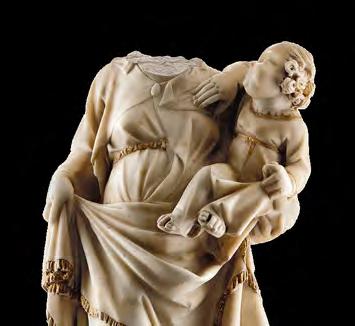
typical of contemporary Sienese painters; this lyricism, consistent with the supple pose of the body, contrasts with the expressive emphasis of the Child, clearly inspired by Giovanni. However, comparing the two Infants, it is clear that Tino, with the idea of paying homage to the master, has accentuated the tension of Christ’s naked bust and his intense expressive movement concentrated in a brief moment (figs. 87-88). The quiet and smiling Child of the Böhler Madonna is on the other hand inserted, dressed in a tunic, into the contours of the block of marble and encounters his Mother in a direct colloquy. Lastly, observing the pleats of the drapery in the two statues we note how, despite a similar articulation, they are clearly different in the working of the borders of
the cloak, pierced and drilled in Tino, linear and chiselled in Giovanni (figs. 32, 86). So it appears clear, in the light of our stylistic reading, that the two statuettes belong to different masters, who interpreted the theme on the basis of quite distinct sculptural ideas. So we are able to confirm the attribution of the Böhler Madonna to Giovanni Pisano, and its dating to around 1313, and to identify the Turin Madonna as the work in which Tino di Camaino, about a year later, most closely approached his master, rendering to Giovanni’s art a homage that is unique and exceptional in Tino’s work, not only for the dynamic force he impressed on the marble but also for his articulation of the various stylistic features of Giovanni’s art.
Comparison between Tino’s Turin Madonna and the Berlin Madonna by Giovanni illustrate how much Tino admired and received the stylistic features of Giovanni, not only from the Böhler Madonna but also from the other Madonnas in the ‘imperial style’ group (figs. 55-57). In particular, in the Child of the Turin Madonna we note how Tino was inspired by the Berlin statuette, assimilating the prototype to his expressive vehemence. From the Child sculpted by Giovanni, Tino took the dynamic movement in the instant when Christ snatches at the Madonna’s veil. However, whereas in Giovanni the Child turns, encountering the deep and direct gaze of his Mother, and the two figures tend towards a mutual meeting, in Tino on the other hand Christ, in snatching at the veil, expresses an impulsive and vehement movement that distances him from the body of the Virgin, so that he does not encounter her remote and dreamy gaze. The same idea manifests itself in the two works capturing different moments in the representation: in Giovanni’s sculpture everything is concentrated
in the immediate tension of gazes and movements, while on the contrary in Tino’s statuette the dissolving of the Mother-Son visual bond dilates the time of representation into an indefinite contemplative gaze of the Madonna and into an impetuous dynamic reaction of the Child.
In support of our thesis that the group of ‘imperial style’ Madonnas by Giovanni Pisano was known to Tino di Camaino and was well impressed into his artistic imagination, we present a comparison between Tino’s Turin Madonna and the Madonna of the Girdle by Giovanni (figs. 89-90). Despite intrinsic compositional differences, such as the absence of a Mother-Son visual dialogue in Tino, intensely present in Giovanni, and the diversity in the gesture of the Child, who grasps the veil in the Turin work while in the Madonna of the Girdle he crowns the Virgin, one notices a surprising resemblance in the robust body of the Child, defined in Giovanni’s sculpture by a tight-fitting tunic and accentuated in

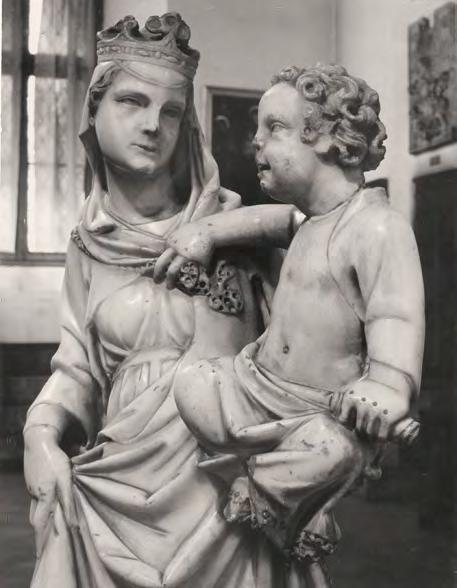
the work of Tino by the naked body of Christ, veiled at the left shoulder by a garment, lowered on the spread knees and slightly disarranged at the feet.
Finally we should like to propose the comparison between the backs of the Böhler Madonna and the Turin Madonna, a viewpoint that has not hitherto been taken into consideration by critics, given that no such photograph of the Böhler Madonna was known (figs. 91-92). If there should be any supporters of the attribution of the Böhler statuette to Tino, this comparison would show them to be totally wrong. Apart from observing how in the work of Tino the body of the Child is strongly detached compared to the compact profiles of Giovanni’s work, we note how Tino transformed the articulated drapery of three triangular pleats in the Böhler Madonna into a single solid vertical pleat formed by tubular drapery falling directly to the ground and neatly bent outwards. 196 So Tino preferred a single large drapery constructed almost by cubic abstraction, detaching himself completely from the stylistic features of courtly fashion north of the Alps (figs. 61-62, 91-92).
Giovanni Pisano’s sensibility for courtly fashions was alien to Tino, who sculpted rigid and not very articulated drapery. Also in the statues made by Tino for the funerary monument to the emperor Henry VII, he never shows any interest in the emperor’s fashions.
In the light of our comparative study of the works of Tino di Camaino with those of Giovanni Pisano, we should like to investigate the relationship between the two sculptors so as to understand how Tino received the stylistic and compositional elements of Giovanni’s art, and to gather whether, in virtue of a wider context, Tino was a pupil, or – if only for a few years – an assistant of the celebrated sculptor. Tino di Camaino, born in Siena around 1280, 197 in the year 1314, the date of the creation of the Turin Madonna, paid homage with admiration and individual stylistic expression to the work of Giovanni Pisano, recording however in the inscription on the base of the Turin statue, as he would repeat a few years later in the inscription on the tomb of the bishop Antonio D’Orso, 198 the close artistic link with his father Camaino di Crescentino, who was in service at the Fabbrica del Duomo in Siena after the departure of Giovanni Pisano for Pisa, where the latter was Capomastro dell’Opera del Duomo, before he was succeeded by Tino di Camaino. 199
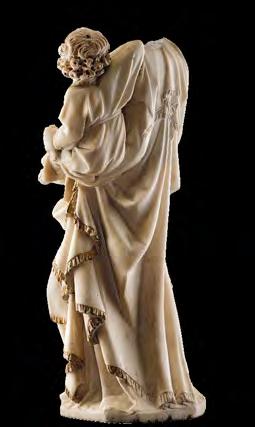

The profound link with his father Camaino di Crescentino certainly dates from the time of Tino’s early training, and his words in homage to his father and master testify that Tino admired the pre-eminent role that Camaino played in the city of Siena, whether at the Opera del Duomo or at the Comune, not only as master stonemason and procurator of the Opera di Santa Maria, but also as Capomaestro employed in town planning. 200 The first document to mention Camaino as magister lapidum is registered in a Biccherna of the Comune of Siena on 10 August 1298, in which Camaino is deputed by the chamberlain and by four officials of the Comune to establish together with other masters the location of a new fountain in Borgo Franco d’Ovile a Siena. 201 Despite the numerous documentary testimonies regarding Camaino di Crescentino in Siena, where almost certainly he was born and where he worked without almost ever leaving the city, no work signed by him or firmly attributable to him has survived. This circumstance makes it impossible to reconstruct a corpus of his sculptures, which would in fact be extremely useful for understanding the work of his son Tino.
Camaino was a leading personality at the cathedral works for the project of enlarging the Duomo in the months before and after the departure of Giovanni Pisano. This prestigious position is witnessed for example in two documents, of 28 November 1310 and of 8 June 1318, which mention Camaino as heading a list of masters working for the Opera. 202
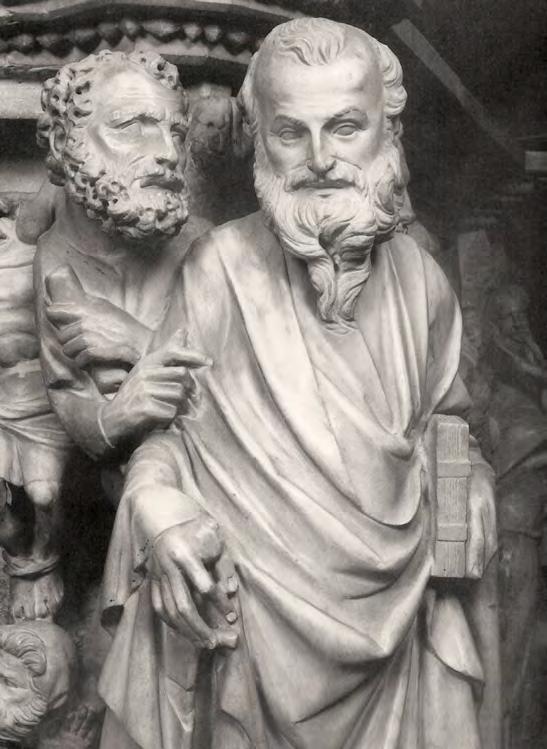
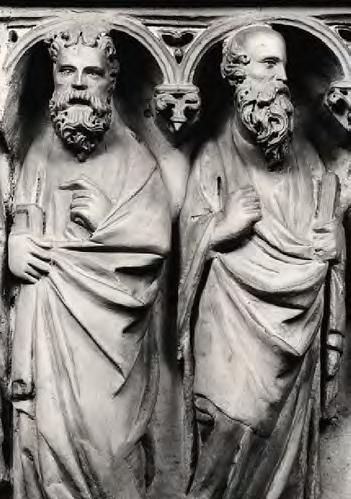
Tino’s father was already registered as being in the employ of the Opera del Duomo in 1299 and from 1299 to 1311, then again in March 1314, in January-February 1315, in August-September 1316, in 1320, in January-June 1326, in 1329, in 1330-1331 and in the second half of the years 1333, 1334, 1335. 203 Given that after 1336 there are no surviving documentary references to Camaino in the archives of the Opera del Duomo, we may suppose that he ended his life in 1337 in Siena, around the same time as his son Tino, who died in the second half of 1337, given that he is documented in Naples on 2 June 1337 204 while on 2 January 1338, also in Naples, he is registered as being deceased. 205
The documentary testimonies cited above describe Camaino di Crescentino as a sculptor, a capomaestro and a personage employed on town planning who played an important role in Siena at the time when the Comune and the Opera were engaged on redesigning the architecture and layout of the religious heart of the city. 206 In the documents, Camaino and Tino appear however as two personalities engaged on different projects, which allows us to understand how Tino, after training with his father as a master stonemason, fully developed as a sculptor, rooted in the Sienese artistic tradition and endowed with stylistic autonomy,
only after working with Giovanni Pisano. To understand how the roles of Camaino and Tino developed in parallel, we propose taking a close look at a two-year period that was crucial for both sculptors: 1305-1306. In 1305 some documents of the Comune of Siena describe Camaino as syndic and procurator of the Opera del Duomo and of the Comune involved in the separation of the goods of a certain Fazino di Nicolò Buonsignori from the goods of the monastery of San Galgano, of the Comune and of the Opera. 207 Again in 1305, Camaino, having worked on the project for the Fonte Nuova, 208 assessed some houses that were to be demolished to make room for a new street. 209 These roles culminated in 1331 in the task of measuring and designing the new city walls. 210 In the year when Camaino was consolidating his prestigious position as procurator and capomaestro in Siena, his son Tino in 1305-1306, having probably worked with Giovanni Pisano on the pulpit of Sant’Andrea in Pistoia, finished in 1301 according to the inscription, 211 was awarded the important commission to make the sculptures for the tomb of St Rainerius in Pisa Cathedral. 212
Although Tino never appears mentioned in a document together with Giovanni Pisano, Camaino and his son are cited together in
records of payment in the ‘Libro delle Entrate e delle Uscite’ in the archive of the Opera del Duomo of Siena between January and June 1320. 213 In their capacity as master stonemasons of the Opera del Duomo, the exact nature of their work not being specified, it is surprising that the already famous Tino received a monthly salary for January that was almost the same as that of his father the genius urbis, i.e. only 1 soldo more. During the same years as this artistic collaboration, it is reflective of the close bond between father and son that Tino and Camaino lived in the same house sub platea canonicorum of the libra of Vallepiatta di Sotto that belonged to the father.
A more complex problem appears in the attempt to define precisely the relationship between Giovanni Pisano and Tino di Camaino. After his initial training with his father, Tino must have spent a period in contact with Giovanni’s famous workshop, possibly in Siena in the years of his youth and very probably during the work on the pulpit in Pistoia. 214 However no surviving document gives concrete proof that Tino was Giovanni’s pupil, though hitherto this has been considered likely on the basis of Giorgio Vasari’s Vita of Giovanni Pisano: ‘furono discepoli di Giovanni molti che dopo di lui fiorirono; ma particolarmente Lino, scultore e architetto senese’ [many who flourished after Giovanni were his disciples; but particularly Lino, the Sienese sculptor and architect]. 215

While the artistic bond between Tino and Giovanni is undoubted, it is also true that Vasari’s statement may not be exact, given that there are no decisive elements in the stylistic analysis testifying to a discipleship of a pupil who became so famous. Only from the study of the traces of the stylistic reception of some motifs by Giovanni in the autonomous works of Tino, as in primis in the tomb of St Rainerius (fig. 96), can we offer a hypothetical reconstruction of the role that Tino played alongside Giovanni.
The tomb of St Rainerius, which Vasari attributed to Tino of Siena, was described by the Aretine biographer as ‘la Cappella dov’è il corpo di San Ranieri in Duomo, tutta ornata di marmi’ [the Chapel where lies the body of St Rainerius, all adorned with marbles]. 216 The cusped marble altarpiece shows the enthroned Madonna and Child, flanked by two angels, and the praesentatio of two donors (fig. 96). In the predella, two of the three scenes that illustrate the life of St Rainerius, the Translation of the Saint’s mortal remains and St Rainerius with a donor in front of the tomb, show the tomb, which seems to have maintained its original appearance despite the loss of two lateral pinnacles and the cornice of the cusp. 217 The structure of the marble altarpiece, at one time painted, and the working of the relief like a pictorial stiacciato, show that the sculptor was well aware of certain painted models for the typology of the altarpiece, including in particular the structure of Giotto’s altarpiece for the church of San Francesco in Pisa.

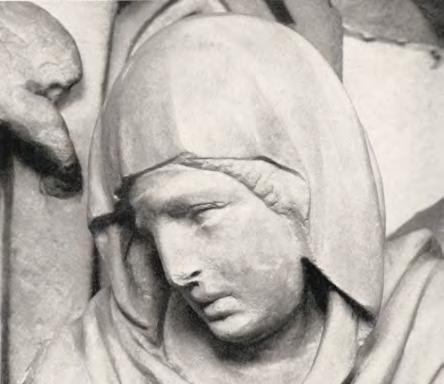
At the centre of the relief, the Virgin, extending her right hand, addresses her client Burgundio di Tado, Operarius of the Opera della Primaziale, who in 1306 allocated a bequest so that the religious functions could be officiated at the altar of San Rainerius (fig. 96). 218 Burgundio di Tado, shown kneeling as he proffers his hand to the Virgin, is presented by St Rainerius who is wearing the penitential pilurica, while to the left of the Madonna St Mark presents the notary Marco Sicchi, who in 1291 took the initiative to set up the altar. 219
Tino di Camaino had made the tomb of St Rainerius by 1306, the date of the bequest allocated by Burgundio di Tado. As was already pointed out by Seidel in 1975, 220 we note especially in the face of the Madonna the stylistic patrimony of Giovanni Pisano, in particular the face of the Virgin Annunciate on the pulpit in Pistoia, on which – according to our thesis – Tino had collaborated with Giovanni five years previously (figs. 95-97)
The resemblance between the stylistic features of the Pisan and Pistoiese reliefs is surprising in the profile and in the facial features, bordered by the pleats of the veil, which accentuate the curvature of the oval face. It seems clear that Tino had absorbed the Virgin Annunciate of the Pistoia pulpit into his artistic imagination, but the sculptor brilliantly adapted – according to the different theme – the expressive facial features of the Madonna to the different iconography. While the Madonna turns to St Rainerius with benevolent eyes, and mouth open in a slight smile, on the contrary the Virgin Annunciate draws back in alarm, her forehead tense with fear and the corners of her closed mouth drawn down. Tino’s brilliant ability to interpret, according to a different iconographic theme, the stylistic elements proper to a masterpiece by Giovanni Pisano, reveals that he was not a mere pupil, or an ordinary follower as Vasari says, 221 but a brilliant interpreter of Giovanni’s work.
About ten years after the project for the tomb of St Rainerius, in the funerary monument to Henry VII Tino di Camaino reproposes figurative models derived from the pulpit of Sant’Andrea in Pistoia, tending however towards a progressive detachment from Giovanni’s emphatic sensibility. Comparing the Apostles Peter and Paul among the group that adorns the sarcophagus of the funerary monument to Henry VII (fig. 94), made by Tino in 1315, with the St Peter and St Paul sculpted by Giovanni on the pulpit in Pistoia (fig. 93), we observe how Giovanni’s models, which perdure in Tino’s works in the foamy working with the drill on hair and beards, in the composition of the ample pleats of the drapery and in the different expressive declination between the personalities of the two Apostles.
These are transformed in the sculpture on the tomb into a calm paratactic monumentality, while in the pulpit the expressive emphasis of the vibrant faces and hands of the interconnected figures is concentrated into a single moment of time. The memory of the Pistoiese pulpit would accompany Tino di Camaino until the 1330s, during his period at the Angevin court in Naples. This is witnessed by a relief showing a group of the holy women from a marble altarpiece of which numerous pieces are conserved at the Benedictine abbey of Cava dei Tirreni (fig. 98). Here the compressed composition of the figures standing out in relief and the abandonment of the Madonna, who with her head reclined is supported by the mourners, reveal that Tino was inspired by a distant memory of the relief of the Crucifixion on the pulpit in Pistoia, like a dissolving and imprecise image (fig. 99)
In view of these stylistic comparisons it follows that first important direct contact between Tino di Camaino and Giovanni Pisano was in their collaboration on the Pistoiese pulpit, memories of which recur during the rest of Tino’s career. His dialogue with Giovanni Pisano culminates in the Turin Madonna and already in the funerary monument to Henry VII Tino is distancing himself from Giovanni, to the point where there are only vague memories of his work in the final Neapolitan period (figs. 32, 86, 98-99)

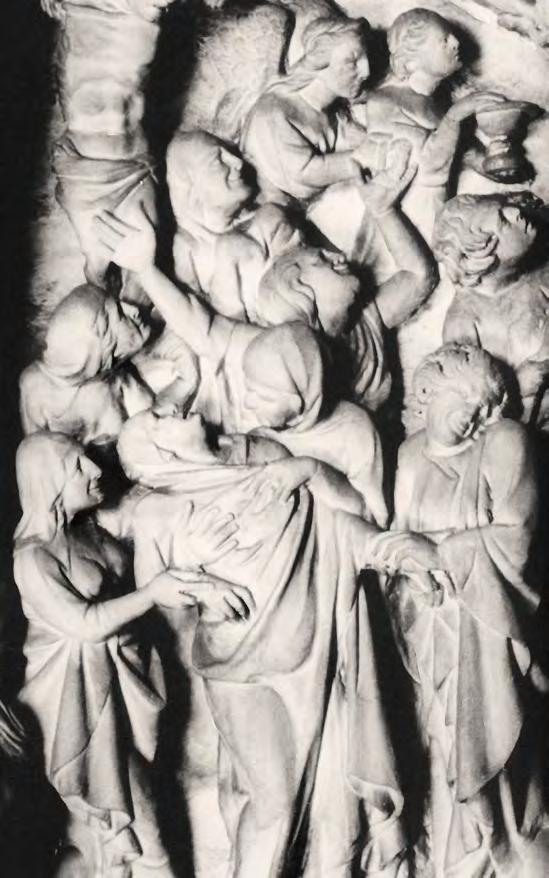
In our attempt to reconstruct the artistic fortune, and indirectly the provenance, of the Böhler statuette, we have made an extraordinary comparison between the Madonna by Giovanni Pisano and the one by Lupo di Francesco, originally in the tabernacle above the main doorway in the church of San Michele in Borgo in Pisa and now in the Museo di San Matteo (figs. 100-101)
In 1315 Lupo di Francesco replaced Tino di Camaino in the role of capomaestro of the Opera del Duomo of Pisa and, shortly after 1325, when a document records his being the leading sculptor and architect of the city, 222 he made, before 1330, the sculptures of the group of the Madonna and Child, with two angels at the sides and the abbot of San Michele in Borgo kneeling as the patron of the tabernacle on the façade of the church. 223 The triptych-like composition of the aedicule containing the sculptural group derives in particular from the tabernacle above the main doorway to the Camposanto in Pisa, sculpted by Lupo around 1320, and from the Della Gherardesca tomb, made by the sculptor for the church of San Francesco in Pisa before his departure for Barcelona in 1327. This was following the Pisan embassy that had reached the city in 1326 to agree the peace between the Catalans and the Pisans after the Sardinian war. 224 The antithesis between the richly decorated lower order and the light articulation of the three levels of loggias in the upper order of the façade of San Michele in Borgo is emphasised by the string-course cornice which, at the level of the architrave above the embrasured doorway, traces the base of the tripartite tabernacle backing onto the lunette and containing the sculptural group by Lupo di Francesco. 225 The aedicule was restored between 1892 and 1894 and, as we can tell from an engraving by Charles Rohault de Fleury of 1866, the sculptures also underwent restoration, in particular the angel to the right of the Madonna and the head of the Child. 226
The Madonna by Lupo di Francesco reprises precise stylistic features and iconographic formulas from the Madonnas in the ‘imperial style’ by Giovanni Pisano. 227 To illustrate this stylistic derivation, we compare the sculpture by Lupo di Francesco with the Böhler Madonna hypothetically completed in a photomontage by the head of Giovanni Pisano’s Madonna of the Girdle (figs. 31-32, 100-101). Given that, unlike what we find in the Renaissance, Tuscan Gothic statues are almost never reproduced in very similar variants, it is surprising to find how slavish is the imitation in the San Michele sculpture of the Böhler Madonna, in the pleats of the drapery falling over the knee, in the gesture of the right hand raising the cloak, in the arrangement of the pleats around the girdle, and in the articulation of the vertical pleat beside the right breast and of the one in the cloak beneath the hand of the Child, near the brooch. The extraordinary closeness in the details of the two sculptures confirms not only that the Böhler Madonna must have been a very famous sculpture in the early fourteenth century but also that it must originally have stood in a pre-eminent religious building in Pisa where it was highly visible, given that an exact repetition such as the one carried out by Lupo is possible only if the model can be directly observed. So Lupo di Francesco transferred the stylistic features of the Böhler statuette (fig. 101), 60.5 cm tall, into a Madonna of monumental proportions (fig. 100), 191 cm tall, which, rather like the famous Madonna over the doorway of the Pisa Baptistery (fig. 78), 180 cm tall, was visible from the ground upwards in a lunette of the doorway of a church on a pre-eminent street of the city (fig. 77). So what we have in the case of the Madonna of the Pisan tabernacle is an act of great admiration on the part of Lupo for the greatly admired ‘imperial style’ of Giovanni Pisano and in particular for the celebrated Böhler Madonna, from which however he distances himself by a hard and angular workmanship (figs. 100-101)


Such admiration recalls, by antithesis, the marvellous homage that Tino di Camaino paid to Giovanni’s masterpiece in 1314 with the Turin Madonna (figs. 32, 86). However, whereas Tino created a brilliant interpretation of Giovanni’s celebrated work, Lupo on the other hand managed only a slavish copy, lacking invention, executing a simple enlargement of the model (figs. 32, 86, 100101). Lupo di Francesco’s very feeble attempt at interpretation is attested by the mere repetition of details of the drapery, and by the absence of the serpentine movement of the body, typical of the Böhler Madonna, in favour of a more upright pose. Lastly, in the figure of the Child in Lupo di Francesco’s statue we observe how the stylistic features of the Böhler Christ are repeated, in the gesture of the right hand on the Mother’s breast and in the legs, with dry and rigid movements, together with the lack of a direct dialogue between Mother and Son, the fulcrum of Giovanni’s sculpture (figs. 100-101)
The Sienese brothers Nuto and Ciolo di Nerio are each recorded as ‘famulus Magistri Iohannis’ 228 in the lists of craftsmen who collaborated with Giovanni Pisano on the pulpit of Pisa Cathedral which, according to the inscription of Burgundio di Tado, was begun in 1301 (1302 in Pisan style). 229 The presence of the two stonemasons, as craftsmen working on the Pisa pulpit, is relevant in relation to the sculpture of the Madonna and Child (fig. 104), the original provenance of which is unknown, now conserved in the Museo Diocesano d’Arte Sacra Andrea Guardi in Piombino, bearing on its base an inscription with the signatures of Ciolo and Marco da Siena: ‘HOC OPUS FECERUNT MAGISTRI CIOLUS ET MARCO DE SENA’. 230 If Ciolo is to be identified with the abovementioned Ciolo di Nerio, then Marco must correspond to a certain Marco da Siena documented as a master stonemason at the Opera del Duomo in Pisa between May 1303 and May 1304. 231
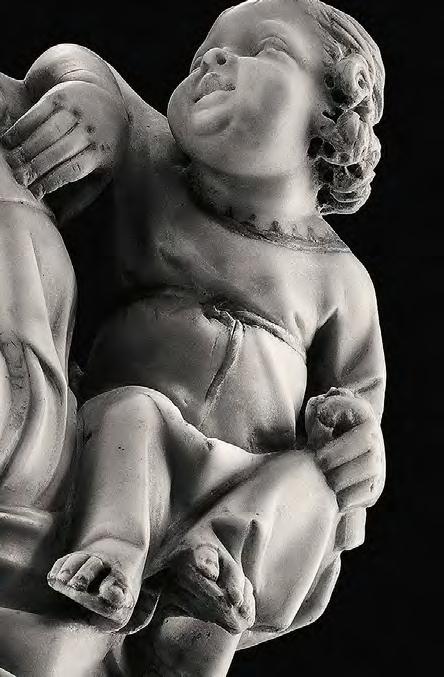
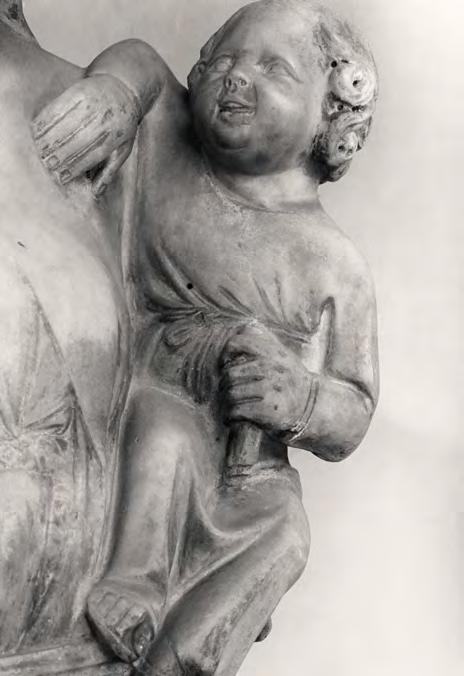
Although it is known that for their sculptures Ciolo and Marco da Siena drew their inspiration from Giovanni Pisano, there has hitherto been no attempt to compare the Madonna of Piombino with the Böhler Madonna. From this comparison it is possible to demonstrate not only that Giovanni’s statuette was a masterpiece referred to by his collaborators but also that the Piombino Madonna was made in Pisa, given that it repeats the stylistic and compositional elements of the Böhler statuette observed as a direct model (figs. 101, 104). So the Böhler Madonna was so famous in Pisa, and so much admired by the collaborators of Giovanni, as to induce them to create a work extremely similar to it, but in a much weaker and more awkward style in the repetition of the Madonna’s gesture as she raises her cloak, in the articulation of the drapery and in the not very emphatic movements of the rigid body. From this we can deduce that the Piombino Madonna was made certainly after 1313 (fig. 104). The immediate dependence on the Böhler Madonna emerges especially from a com-
parison between the figures of the Child in the two sculptures, showing in the first place the profound similarity between the master’s model and the slavish imitation by his collaborators (figs. 102-103). In the Piombino Madonna the working of the hair with the drill is similar to the treatment of the hair in Böhler Child, which however is softer and more foamy both in the fall of the curls and in the lightness of the locks that descend over the temples. Not being at the expressive level of Giovanni Pisano, his two collaborators slavishly repeat the pose of the Child’s right arm resting on the Madonna’s shoulder and the movement of the legs. It is surprising how Ciolo and Marco da Siena imitate the composition of the Böhler Child, especially in the pleats of the tunic caused by the girdle, and in the gesture of Christ’s left hand, which clutches a scroll. Although the Piombino Child reproposes the same smile as the Böhler Christ, its expressivity is attenuated by the absence of the dialogue between Mother and Son, which is the distinctive element in the rendering of the inclined profile of Giovanni’s Child
(figs. 32, 101-105). In the Child of the Böhler Madonna we note the soft and fluid articulation of the tactile surface of the marble in the movements between the Virgin and her Son, accentuated by a skilful articulation of solids and voids that emphasise the tactile quality of the bodies. On the contrary, in the Child of Piombino the stiffness of the right arm resting on the shoulder of the Mother clearly fixes the body of the Son at the side of the Virgin. The two Sienese sculptors, in an attempt to create a statue very similar to the model, failed to interpret Giovanni’s masterpiece, trivially repeating the expressiveness of the Child’s eyes and the movements of his legs, which appear weak and awkward.
In a context such as that of Tuscan Gothic sculpture, in which the phenomenon of the copy is unknown, it is surprising to find

not one but two examples of sculptures that minutely imitate a famous model: one by a distant successor of Giovanni Pisano as capomaestro of the Opera del Duomo in Pisa, and the other by two simple craftsmen who collaborated with Giovanni on the cathedral pulpit (figs. 100, 104). These two examples, and there may have been others that are now lost, demonstrate the centrality of the Böhler Madonna in the work of Giovanni Pisano and his great fame.
We could perhaps say that the rediscovery and precise historical evaluation of the Böhler Madonna coincides with the recovery of the decisive missing piece of a great puzzle which today presents the late, albeit still fragmentary, work of Giovanni Pisano in a richer form than was found in previous studies.


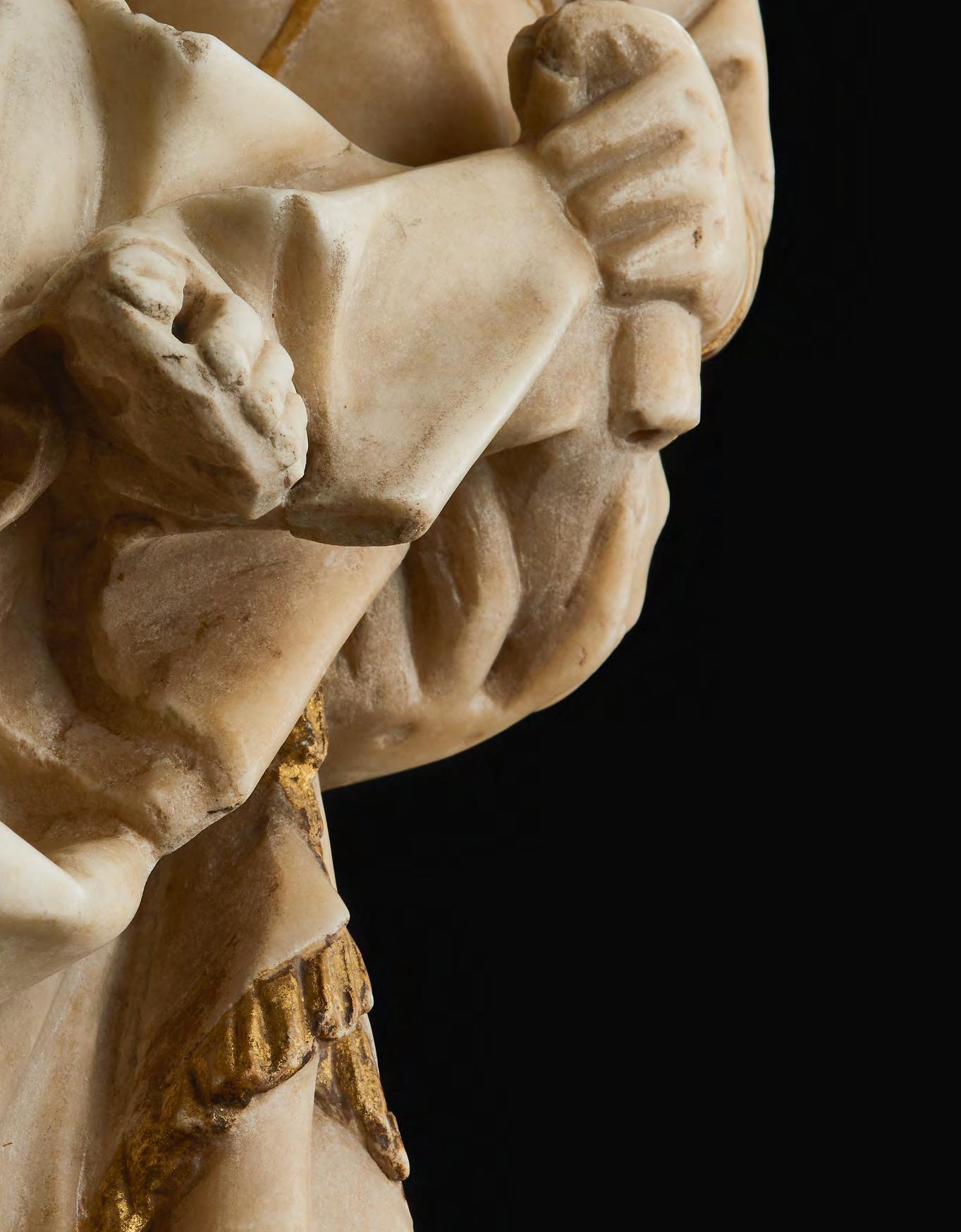
1. Fievez 1904.
2. Böhler 1958, Plastiken aus Stein, Ton und Stuck, n. 77.
3. Böhler 1931, I vol., n. 52. Böhler 1967, p. 45.
4. Seidel 2003, II vol., pp. 821-862, pp. 826-835, pp. 845-846.
5. Böhler 1931, I vol., n. 52. Böhler 1967, p. 45.
6. Ibid.
7. Böhler 1967, p. 45.
8. Venturi 1906, pp. 256-263, p. 257.
9. Volbach 1925, pp. 40-45.
10. Venturi 1906, p. 257.
11. Ibid., pp. 256-263. Seidel 2003, II vol., p. 846. Bode 1886.
12. Mallé 1965, pp. 87-88.
13. Venturi 1906, pp. 256-263, p. 257.
14. Volbach 1925, pp. 40-45.
15. Ibid., p. 43. Original text: ‚Betrachten wir neben den genannten thronenden Madonnen Tinos übrige Werke, so wächst die Wahrscheinlichkeit für seine Autorschaft an der Ettaler Madonna. Schon bei seinen frühen stehenden Madonnen im Museo Civico zu Turin und in der Sammlung Böhler München finden wir verwandte Züge’.
16. Ibid., pp. 40-45.
17. Böhler 1980, pp. 5-9.
18. Ibid.
19. Ibid.
20. Ibid.
21. Ibid.
22. Ibid.
23. Ibid., Seidel 2003, II vol., pp. 821-862, pp. 826-835, pp. 845-846.
24. Ibid., Böhler 1980, pp. 5-9.
25. Fievez 1904. Böhler 1980, pp. 5-9.
26. Seidel 2003, II vol., pp. 845-846.
27. Bode 1886. Seidel 1972, pp. 181-183. Venturi 1906, pp. 256-263, p. 257. Volbach 1925, pp. 40-45.
28. Seidel 1972, pp. 181-183.
29. Seidel 1987, pp. 165-177.
30. Ibid.
31. Venturi 1906, pp. 256-263, p. 257. Volbach 1925, pp. 40-45.
32. Van Molle 1972, Léon de Somzée. De Paepe and Raindorf-Gerard 1996, Léon de Somzée.
33. Ibid.
34. Ibid.
35. Ibid.
36. Ibid.
37. Ibid.
38. Ibid.
39. ACS 1892, p. 788. Denhaene 2002, pp. 31-34, p. 42.
40. Fievez 1904.
41. ACS 1892, p. 788. Denhaene 2002, pp. 31-34, p. 42.
42. Ibid.
43. Inventaire du patrimoine architectural (Bruxelles) 2013-2014, p. 3.
44. Fievez 1904.
45. Meyers Enzyklopädisches Lexikon 1973, IX vol., Adolf Furtwängler.
46. Ibid.
47. Ibid.
48. Furtwängler 1897.
49. Ibid., pp. V-VI.
50. Ibid.
51. Furtwängler 1897.
52. Ibid.
53. Ibid., pp. V-VI.
54. Ibid.
55. Ibid., n. 7. Original text: ‚Frühere Ergänzungen sind abgenommen’.
56. Ibid., n. 6, n. 30.
57. Ibid., n. 28. Original text: ‚Der Stamm mit der Schlange neben den beiden mit Sandalen bekleideten Füssen ist antik, doch nicht zu gehörig. Die Unterbeine von den Knien bis zu den Knöcheln sind ergänzt. Die übrigen früheren Ergänzungen sind entfernt’.
58. Ibid., n. 4.
59. Ibid.
60. Ibid.
61. E xposition Universelle de Paris 1900, Pavillon de la Belgique, Catalogue des Œuvres d’Art appartenant a M. L. de Somzée.
62. Ibid.
63. Fievez 1904.
64. Ibid., pl. XCIII, nn. 1408, 1417-1421.
65. Ibid., n. 1417.
66. Ibid., n. 1418.
67. Allgemeines Lexikon der bildenden Künstler 1980, XXVII vol., Nicola Pisano, pittore.
68. Fievez 1904, n. 1419.
69. Ibid., n. 1420.
70. Ibid., n. 1408.
71. Ibid., n. 1421.
72. Böhler 1931, I vol., n. 52. Böhler 1967, p. 45.
73. Carl 2006, I vol., pp. 381-392.
74. Vasari ed. 1966-1997, III vol., Vita d’Antonio Rossellino scultore e Bernardo suo fratello, pp. 391-397.
75. Carl 2006, I vol. pp. 381-382.
76. Ibid., p. 382.
77. Ibid., pp. 381-383, 389.
78. Caglioti 2002, pp. 990-1009. Carl 2006, I vol. p. 124, note 53, pp. 121-128.
79. Ibid.
80. Carl 2006, I vol., p. 124, pp. 121-128.
81. Ibid., pp. 121-128.
82. Ibid.
83. Ibid., p. 126.
84. Ibid., pp. 121-127.
85. Caglioti 2002, pp. 990-1009. Carl 2006, I vol. p. 124, note 53, pp. 121-128.
86. Venturi 1906, pp. 256-263, p. 257. Volbach 1925, pp. 40-45.
87. Böhler 1931, I vol., n. 52. Böhler 1967, p. 45.
88. Böhler 1958, Plastiken aus Stein, Ton und Stuck, n. 77.
89. Marcenaro 1963.
90. Seidel 1987, pp. 20, 165-200.
91. Ibid.
92. Ibid.
93. Ibid.
94. Ibid., Caleca, in Baracchini 1993, pp. 214-215.
95. Seidel 1987, pp. 165-200.
96. Caleca, in Baracchini 1993, pp. 214-215.
97. Seidel 1987, pp. 165-166.
98. Papini 1915, pp. 266-267.
99. Carli 1935, p. 18, n. 8.
100. Seidel 1972, p. 184. See also Seidel 1987, pp. 40, 165-177.
101. Caleca, in Baracchini 1993, pp. 214-215.
102. Carletti, in Burresi – Caleca 2005, pp. 91-92. Carletti – Giometti 2011.
103. Calderoni Masetti 2019, p. 20.
104. Ibid., p. 30, note 17.
105. Ibid., pp. 24-26.
106. See the Chapter ‘The Madonna of the Pisa Baptistery compared to the Böhler Madonna’.
107. Seidel 1987, pp. 65-119, 165-177.
108. Ayrton 1969, p. 220.
109. Ibid.
110. Fantappié, in Martini – Tosi 1995, pp. 41-59. Grassi, in Ibid., pp. 28-31.
111. Fantappié, in Ibid., pp. 42-44.
112. Ibid., p. 42, note 8.
113. Ibid.
114. Ibid., p. 42, note 12, cf. document of 12 May 1293 (note 8).
115. Ibid., p. 42, note 19.
116. Grassi, in Ibid., p. 28.
117. Ibid., pp. 28-29.
118. Ibid.
119. Ibid., p. 28.
120. Ibid., pp. 28-29.
121. Ibid. See also the Virgin’s second miracle: ‘Et la Vergine gloriosa […] fece che la forma del sangue in decto luogho manifestissima rimase, la quale, benchè allo scoperto sia, per aeque né piove di tale luogho mai è scaduta’ Ibid., p. 29.
122. Ibid., pp. 28-29.
123. Fantappié, in Ibid., pp. 42-44.
124. Ibid.
125. Ibid., p. 42, note 21.
126. Ibid.
127. Ibid.
128. Ibid., p. 44, note 28.
129. Ibid., p. 44, note 29.
130. Ibid.
131. Ibid., p. 44, note 28 e 29.
132. Grassi, in Ibid., pp. 28-29.
133. Seidel 1972.
134. Ibid., pp. 181-191.
135. Ibid., pp. 181-182.
136. Tripps, in Schwarz 1997, pp. 27-49, p. 35, note 30.
137. Walther – Siebert 1988, pp. VIII-XXXVIII.
138. Ibid., p. 35.
139. G olinelli 2001. Seidel 1987, pp. 12-163.
140. Walther – Siebert 1988, p. 71.
141. Bowsky 1960, p. 19, p. 218 note 10.
142. Contini 1970, pp. 436-440.
143. Ibid.
144. Ibid.
145. Ibid., Thomas 1887.
146. Thomas 1887. Alighieri ed. 2016, Epistola V, pp. 102-131.
147. Contini 1970, pp. 436-440. See also Thomas 1883.
148. Ibid., Francesconi 2021, pp. 49-73.
149. Da Barberino ed. 1995, pp. XXIII-XLIV.
150. Ibid.
151. Ibid., part V, pp. 45-93.
152. Ibid., p. 58.
153. Ibid.
154. Ibid., pp. 58-59.
155. Bowsky 1960, pp. 17-19.
156. Mussato ed. 1727, libro I, rubrica XIII, p. 340.
157. Bowsky 1960, pp. 17-19.
158. Rorimer 1957, pp. 5-17.
159. Ibid., p. 7.
160. Bowsky 1960, pp. 17-19.
161. Ibid.
162. Ibid.
163. Ibid.
164. Ibid.
165. Irmer 1881, pp. V-XII.
166. Ibid.
167. Mussato ed. 1727, libro I, rubrica XIII, p. 340.
168. De Castris 2003, pp. 172-188, pp. 351-352.
169. Irmer 1881, pp. 44-46.
170. Mussato ed. 1727, libro I, rubrica XII, pp. 338-339.
171. Ibid., rubrica XIII, p. 339.
172. Herzner 1990.
173. Seidel 2008, pp. 61-83.
174. Ayrton 1969, p. 220.
175. Caleca, in Bergdolt – Bonsanti 2001, pp. 99-104.
176. Ibid., p. 103.
177. Caleca 1991, p. 206.
178. Ibid., p. 206.
179. Ibid.
180. Ibid.
181. Ibid.
182. Ibid.
183. Ibid.
184. Collareta – Carletti 2019, p. 26. In the caption to the sculptural group on p. 28 a dating of 1300 is given.
185. Caleca, in Bergdolt - Bonsanti 2001, p. 101.
186. Baldelli 2007, pp. 282-302.
187. Ibid., p. 397, n. 5.
188. Novello, in Pettinari – Romano 1996, pp. 88-89.
189. Toesca 1951, pp. 256-257.
190. Mallé 1965, pp. 87-88.
191. Ibid., Baldelli 2007, p. 397, n. 5.
192. Baldelli 2007, p. 27, p. 397, n. 5 e Carmi – Felicetti, in Baldelli 2007, pp. 408-409, n. 23.
193. Seidel 1972, p. 185.
194. Seidel 1987, pp. 167-171.
195. Venturi 1906, pp. 256-263, p. 257. Volbach 1925, pp. 40-45.
196. See the Chapter ‘Aulico stile imperiale’.
197. Aceto 2000.
198. Baldelli 2007, p. 27, pp. 408-409, n. 23, inscription: OPERU[M] DE
S ENIS NATUS EX MAG[IST]RO CAMAINO IN HOC SITU FLORENTINO
T INUS SCULPSIT O[MN]E LAT[US] / HU[N]C P[RO] PATRE GENETIVO
D ECET INCLINARI UT MAGISTER ILLO VIVO NOLIT APPELLARI.
199. Ibid., p. 27.
200. Ibid., pp. 28-29.
201. Carmi – Felicetti, in Ibid., p. 428, n. 1.
202. Ibid., pp. 434, n. 23, p. 439, n. 40.
203. Ibid., pp. 428-452.
204. Ibid., pp. 450-451.
205. Ibid.
206. Baldelli 2007, p. 29. Bartalini 2019.
207. Baldelli 2007, p. 29, Carmi – Felicetti, in Ibid., pp. 429-433.
208. Ibid.
209. Ibid.
210. Baldelli 2007, p. 29. Carmi – Felicetti, in Ibid.
211. Ibid.
212. Baldelli 2007, pp. 395-396.
213. Carmi – Felicetti, in Ibid., p. 441, n. 45.
214. Baldelli 2007, p. 61.
215. Vasari ed. 1966-1997, II vol., Vita di Nicola e Giovanni Pisani, pp. 59-71, pp. 70-71.
216. Ibid., pp. 70-71.
217. Seidel 1975. Baldelli 2007, pp. 395-396. Valentiner 1935.
218. Ibid.
219. Ibid.
220. Seidel 1975.
221. Vasari ed. 1966-1997, II vol., Vita di Nicola e Giovanni Pisani, pp. 59-71, pp. 70-71.
222. De Dalmases 1997.
223. Ibid.
224. Martinelli, in Ceccarelli Lemut – Garzella 2016, pp. 103-119.
225. Ibid.
226. Ibid.
227. Seidel 1975. Seidel 1972.
228. Caleca, in Bergdolt – Bonsanti 2001, p. 100: ASP, OdP, 79, c. 99v.
229. Ibid., pp. 100-101.
230. Russoli – Tolaini 1947, p. 38. Lazzarini 2011.
231. Caleca, in Bergdolt – Bonsanti 2001, p. 101, nota 18.
ACETO 2000
F. Aceto, Tino di Camaino, in ‘Enciclopedia dell’Arte Medievale’, XI vol., Roma 2000, pp. 180-188.
ACS 1892
ACS (Archives communal Schaerbeek)/Bulletin communal de Schaerbeek, 1892.
ALIGHIERI ED. 2016
D. Alighieri, Le Opere. Epistole Egloge Questio de Aqua et Terra, ed. by M. Baglio, L. Azzetta, M. Petoletti, M. Rinaldi, Roma 2016, V vol.
ALLGEMEINES LEXIKON DER BILDENDEN KÜNSTLER 1980
Allgemeines Lexikon der bildenden Künstler ed. by H. Vollmer, XXVII vol., Leipzig 1980.
AYRTON 1969
M. Ayrton, Giovanni Pisano Sculptor, introd. by Henry Moore, London 1969.
BAGNOLI – BARTALINI – BELLOSI – LACLOTTE 2003
A. Bagnoli, R. Bartalini, L. Bellosi, M. Laclotte (ed. by), Duccio. Siena fra tradizione bizantina e mondo gotico, Cinisello Balsamo (Milano) 2003, Edizione Monte dei Paschi di Siena.
BAGNOLI – BELLOSI 1985
A. Bagnoli, L. Bellosi (ed. by), Simone Martini e ‘chompagni’, catalogue of the exhibition, Siena, Pinacoteca Nazionale, 27 March-31 October 1985, Firenze 1985.
BALDELLI 2007
F. Baldelli, Tino di Camaino, Morbio Inferiore 2007.
BARACCHINI 1993
C. Baracchini (ed. by), I marmi di Lasinio: la collezione di sculture medievali e moderne nel Camposanto di Pisa, catalogue of the exhibition Pisa, Museo Nazionale di San Matteo, 30 July-31 October 1993, Firenze 1993.
BARTALINI 2019
R. Bartalini, Il duomo nuovo di Siena: la fabbrica, le sculture, i maestri, le dinamiche di cantiere, Cinisello Balsamo, Milano 2019.
BERGDOLT – BONSANTI 2001
K. Bergdolt, G. Bonsanti (ed. by), Opere e giorni. Studi su mille anni di arte europea dedicati a Max Seidel, Venezia 2001.
BIGNAMI ODIER 1956
J. Bignami Odier, Le testament du Cardinal Richard Petroni, in ‘Papers of the British School at Rome’, XXIV, 1956, pp. 142-157.
BODE 1886
W. Bode, Neue Erwerbungen für die Abteilung der christlichen Plastik in den königlichen Museen, in ‘Jahrbuch der königlich preußischen Kunstsammlungen’, VII vol., 1886, pp. 211-212.
BÖHLER 1931
Katalog der Sammlung Julius Böhler 1931, I vol., München 1931.
BÖHLER 1958
J. Böhler, Meisterwerke alter Kunst, catalogue of the exhibition to mark the 800 th anniversary of the City of Munich, München 1958.
BÖHLER 1967
Die Sammlung Julius Böhler, Skulpturen, München 1967.
BÖHLER 1980
J. Böhler, Deutsche Skulptur der Gotik, catalogue of the exhibition, München, Galerie Böhler, 18 June -18 July 1980, München 1980.
BOWSKY 1960
W. M. Bowsky, Henry VII in Italy. The conflict of Empire and City-State 1310-1313, Lincoln 1960.
BURRESI – CALECA 2005
M. Burresi, A. Caleca (ed. by), Cimabue a Pisa: la pittura pisana del Duecento da Giunta a Giotto, catalogue of the exhibition Pisa, Museo Nazionale di San Matteo, 25 March-25 June 2005, Pisa 2005.
CAGLIOTI 2002
F. Caglioti, La scultura del Quattrocento e dei primi decenni del Cinquecento, in ‘Storia della Calabria nel Rinascimento’, ed. by S. Valtieri, Roma 2002, pp. 977-1042.
CALDERONI MASETTI 2019
A. R. Calderoni Masetti, Riflettendo sull’attività di Giovanni Pisano a Genova, in ‘Studi di storia dell’arte’, 30 (2019), pp. 19-32.
CALECA 1991
A. Caleca, La dotta mano: il Battistero di Pisa, Bergamo 1991.
CARL 2006
D. Carl, Benedetto da Maiano. Ein Florentiner Bildhauer an der Schwelle zur Hochrenaissance, Regensburg 2006, II voll.
CARLETTI – GIOMETTI 2011
L. Carletti, C. Giometti (ed. by), L’arte a Pisa in 200 immagini, Pisa 2011.
CARLI 1935
E. Carli, Valore e significato del nuovo Museo della Primaziale, Pisa 1935.
CARLI 1980
E. Carli, Gli scultori senesi, Milano 1980.
CECCARELLI LEMUT – GARZELLA 2016
M. L. Ceccarelli Lemut, G. Garzella (ed. by), San Michele in Borgo: mille anni di storia, Pisa 2016.
CHELAZZI DINI 1983-1984
G. Chelazzi Dini, Un capolavoro giovanile di Simone Martini, in ‘Prospettiva’, 33/36.1983/1984 (1985), pp. 29-32.
COLLARETA – CARLETTI 2019
M. Collareta, L. Carletti, Museo dell’Opera del Duomo di Pisa: guida breve, San Miniato (Pisa) 2019.
CONTINI 1970
G. Contini, Letteratura delle origini, Firenze 1970.
DA BARBERINO ED. 1995
F. Da Barberino, Reggimento e costumi di donna, ed. by G. E. Sansone, Roma 1995.
DE CASTRIS 2003
P. L. De Castris, Simone Martini, Milano 2003.
DE DALMASES 1997
N. De Dalmases, Lupo di Francesco, in ‘Enciclopedia dell’Arte Medievale’, VIII vol., Roma 1997, pp. 49-50.
DE PAEPE E RAINDORF – GERARD 1996
J-L. De Paepe, C. Raindorf-Gerard, Le Parlement belge 1831-1894, Bruxelles 1996.
DENHAENE 2002
G. Denhaene, L’expansion de Bruxelles au XIXe siècle. Naissance du Faubourg de Schaerbeek: histoire et images, Bruxelles 2002.
EXPOSITION UNIVERSELLE DE PARIS 1900
Exposition Universelle de Paris, Pavillon de la Belgique, Catalogue des Œuvres d’Art appartenant a M. L. de Somzée, Bruxelles 1900.
FIEVEZ 1904
J. Fievez (ed. by), Catalogue des monuments d’art antique: statues de marbre et de bronze grecques et romaines, statuettes de Tanagra, curiosités égyptiennes, tableaux anciens des écoles italienne, flamande, française, etc. et cassones, tapisseries, broderies, faiences, bois sculptés, verreries, éventails, médailles, cuivres, ivoires, émaux, objets d’art et d’ameublement et curiosités du moyen-âge et de la renaissance, composant les Collections de Somzée dont la vente publique, pour sortir d’indivision, aura lieu à Bruxelles le Mardi 24 Mai 1904 et jours suivants, Troisième partie, Bruxelles 1904.
FRANCESCONI 2021
G. Francesconi (ed. by), 1315. La battaglia di Montecatini. Una vittoria ghibellina, atti della giornata di studi, Montecatini Terme, 19 settembre 2015, Pisa 2021.
FURTWÄNGLER 1897
A. Furtwängler (ed. by), Sammlung Somzée. Antike Kunstdenkmäler, München 1897.
GOLINELLI 2001
P. Golinelli, Adelaide regina santa d’Europa, Milano 2001.
HERZNER 1990
V. Herzner, Herrscherbild oder Grabfigur? Die Statue eines thronenden Kaisers und das Grabmal Heinrichs VII von Tino di Camaino in Pisa, in ‘Ikonographia’ ed. by B. Brock, München 1990, pp. 27-78.
INVENTAIRE DU PATRIMOINE ARCHITECTURAL (BRUXELLES)
2013-2014
Inventaire du patrimoine architectural, Région de Bruxelles-Capitale, Schaerbeck, Rue des Palais, Bruxelles 2013-2014.
IRMER 1881
G. Irmer, Die Romfahrt Kaiser Heinrich’s VII. im Bildercyclus des Codex Balduini Trevirensis, Berlin 1881.
KLESSE 1967
B. Klesse, Seidenstoffe in der italienischen Malerei des 14. Jahrhunderts, Bern 1967.
LAZZARINI 2011
M. T. Lazzarini (ed. by), La chiesa di Sant’Antimo a Piombino e il Museo Diocesano Andrea Guardi, Pisa 2011.
MALLÉ 1965
L. Mallé, Le sculture del Museo di Arte Antica, catalogue of the Museo Civico of Turin, Torino 1965.
MARCENARO 1963
C. Marcenaro, La Madonna della tomba di Margherita di Brabante, in ‘Paragone. Arte’, Firenze 1963, n. 167, pp. 17-21.
MARTINI – TOSI 1995
C. Martini, P. Tosi (ed. by), La Sacra Cintola nel Duomo di Prato, Prato 1995.
MASIGNANI 1997
S. Masignani, Tino di Camaino e Lupo di Francesco: precisazioni sulla tomba dell’imperatore Arrigo VII, in ‘Prospettiva’, 87-88. 1997 (1998), pp. 112-119.
MEYERS ENZYKLOPÄDISCHES LEXIKON 1973
Meyers Enzyklopädisches Lexikon, ed. by H. J. Abs, O. K. Flechtheim, K. Focke, M. Riedel, IX vol., Mannheim-Wien-Zürich 1973.
MILANESI 1854-1856
G. Milanesi, Documenti per la storia dell’arte senese raccolti ed illustrati dal Dott. Gaetano Milanesi, Siena 1854-1856.
MUSSATO ED. 1727
A. Mussato, De Gestis Heinrici VII Caesaris Historia Augusta, Rerum Italicorum Scriptores, vol. X, Milano 1727.
PAPINI 1915
R. Papini, La collezione di sculture del Campo Santo di Pisa (III), in: ‘Bollettino d’arte del Ministero della Pubblica Istruzione’, anno 9, fasc. 9, 1915.
PETTINARI – ROMANO 1996
S. Pettinari, G. Romano (ed. by), Il tesoro della città. Opere d’Arte e oggetti preziosi da Palazzo Madama, catalogue of the exhibition, Torino, March-September 1996, Torino 1996.
RORIMER 1957
J. J. Rorimer (ed. by), The Hours of Jeanne d’ Évreux, Queen of France, facsimile edition of the original manuscript, New York 1957.
RUSSOLI – TOLAINI 1947
F. Russoli, E. Tolaini (ed. by), Mostra della scultura pisana del Trecento, catalogue of the exhibition, Pisa, Museo Nazionale di San Matteo, May-October 1947, Pisa 1947.
SCHWARZ 1997
M. V. Schwarz, Grabmäler der Luxemburger. Image und Memoria eines Kaiserhauses, Luxemburg 1997.
SEIDEL 1972
M. Seidel, Die Berliner Madonna des Giovanni Pisano, in ‘Pantheon’, 30.1972, pp. 181-192.
SEIDEL 1975
M. Seidel, Studien zu Giovanni di Balduccio und Tino di Camaino: die Rezeption des Spätwerks von Giovanni Pisano, in ‘Städel-Jahrbuch’, N.F. 5.1975, pp. 37-84.
SEIDEL 1987
M. Seidel (ed. by), Giovanni Pisano a Genova, catalogue of the exhibition, Comune of Genoa, April-September 1987, Genova 1987.
SEIDEL 1988
M. Seidel, Das „gemeißelte Bild’ im Trecento: ein neu entdecktes Meisterwerk von Tino di Camaino, in ‘Pantheon’, 47.1988, pp. 4-13.
SEIDEL 2003
M. Seidel, Arte Italiana del Medioevo e del Rinascimento, Vol. 2, Venezia 2003.
SEIDEL 2008
M. Seidel, La scoperta del sorriso: vie di diffusione del gotico francese (Italia centrale, 1315 - 25), in ‘Mitteilungen des Kunsthistorischen Institutes in Florenz’, 51.2007(2008), pp. 45-158.
TOESCA 1951
P. Toesca, Il Trecento, Torino 1951.
THOMAS 1883
A. Thomas, Francesco da Barberino et la littérature provençale en Italie au Moyen Age, Paris 1883.
THOMAS 1887
A. Thomas, Lettres latines inédites de Francesco da Barberino, in ‘Romania’, vol.16, n. 61, 1887, pp. 73-91.
VALENTINER 1935
W. R. Valentiner, Tino di Camaino a Sienese sculptor of the fourteenth century, Paris 1935.
VASARI ED. 1966-1997
G. Vasari, Le vite de’ più eccellenti pittori, scultori e architettori nelle redazioni del 1550 e 1569, text ed. by R. Bettarini. Commento secolare ed. by P. Barocchi, VI vols., Firenze 1966-1997.
VAN MOLLE 1972
P. Van Molle, Het Belgisch Parlement 1894-1972, Antwerpen 1972.
VENTURI 1906
A. Venturi, Storia dell’Arte Italiana, IV vol. ‘La scultura del Trecento e le sue origini’, Milano 1906, pp. 256-263.
VOLBACH 1925
W. F. Volbach, Die Madonna von Ettal, in ‘Münchner Jahrbuch der bildenden Kunst’, N.F. 2.1925, pp. 40-47.
WALTHER – SIEBERT 1988
I. F. Walther, G. Siebert (ed. by), Codex Manesse. Die Miniaturen der großen Heidelberger Liederhandschrift, Frankfurt am Main 1988.


Julius Böhler Kunsthandlung GmbH
Unterer Seeweg 4
82319 Starnberg
Phone: + 49 (0) 81 51 55 92 53
Fax: + 49 (0) 81 51 26 83 17
E-Mail: info@boehler-art.com
www.boehler-art.com
Editor
Florian Eitle-Böhler
Translation
Dr. Mark A. Roberts, Florence
Photography
www.andreashuber-fotografie.de
Graphic design
Matthias Schilling, D-signbureau
Production
Vogl GmbH & Co KG, Zorneding
© 2024 Julius Böhler Kunsthandlung GmbH, Starnberg
All rights reserved. No part of this publication may be reproduced or transmitted in any form without written permission
© all photographs of the Böhler Madonna, Julius Böhler Kunsthandlung
© all other photographs archives Prof. Max Seidel
